Motorola Solutions 89FT7084 2-Way Portable Radio with Bluetooth, Bluetooth LE and WiFi User Manual APX TWO WAY RADIOS
Motorola Solutions, Inc. 2-Way Portable Radio with Bluetooth, Bluetooth LE and WiFi APX TWO WAY RADIOS
Contents
- 1. Manual
- 2. RF Safety Manual
Manual
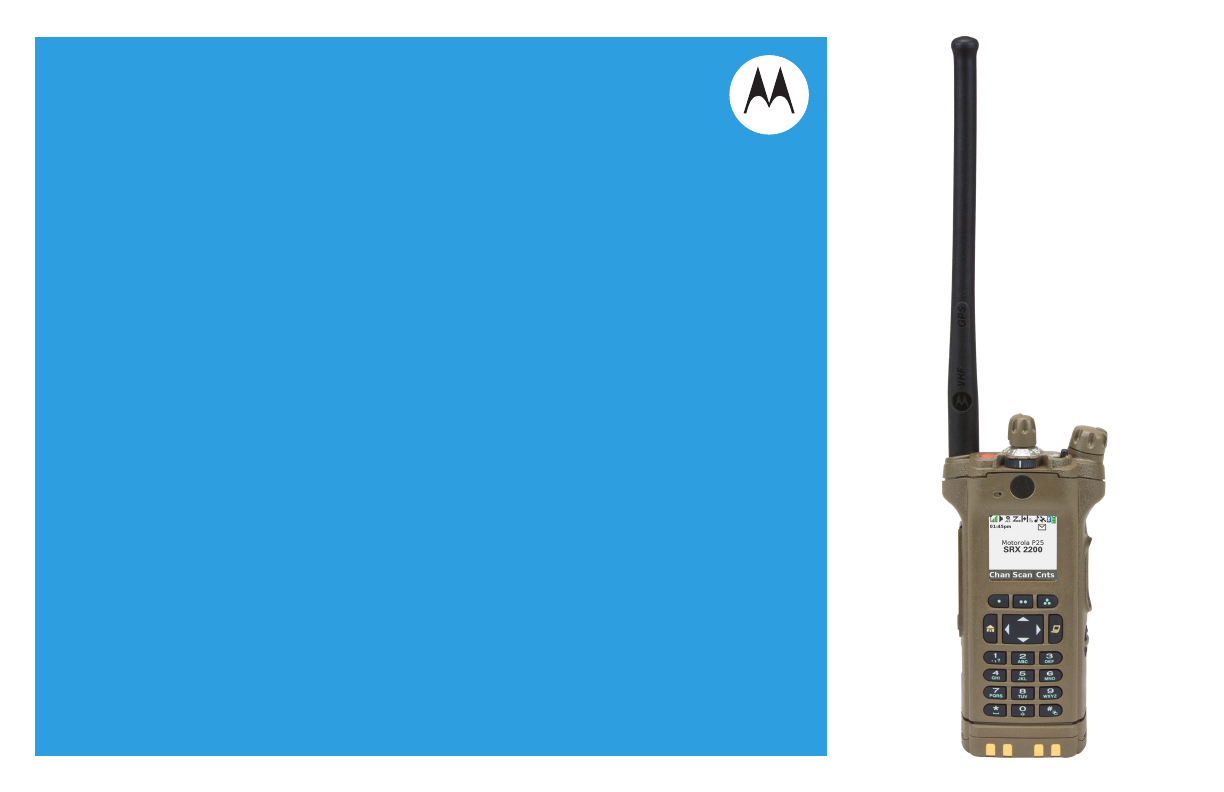
SRX™ TWO-WAY RADIOS
SRX 2200
MODEL 3.5
USER GUIDE
SRX2200_M3.5_FrontCover.fm Page 1 Wednesday, March 27, 2013 6:51 PM
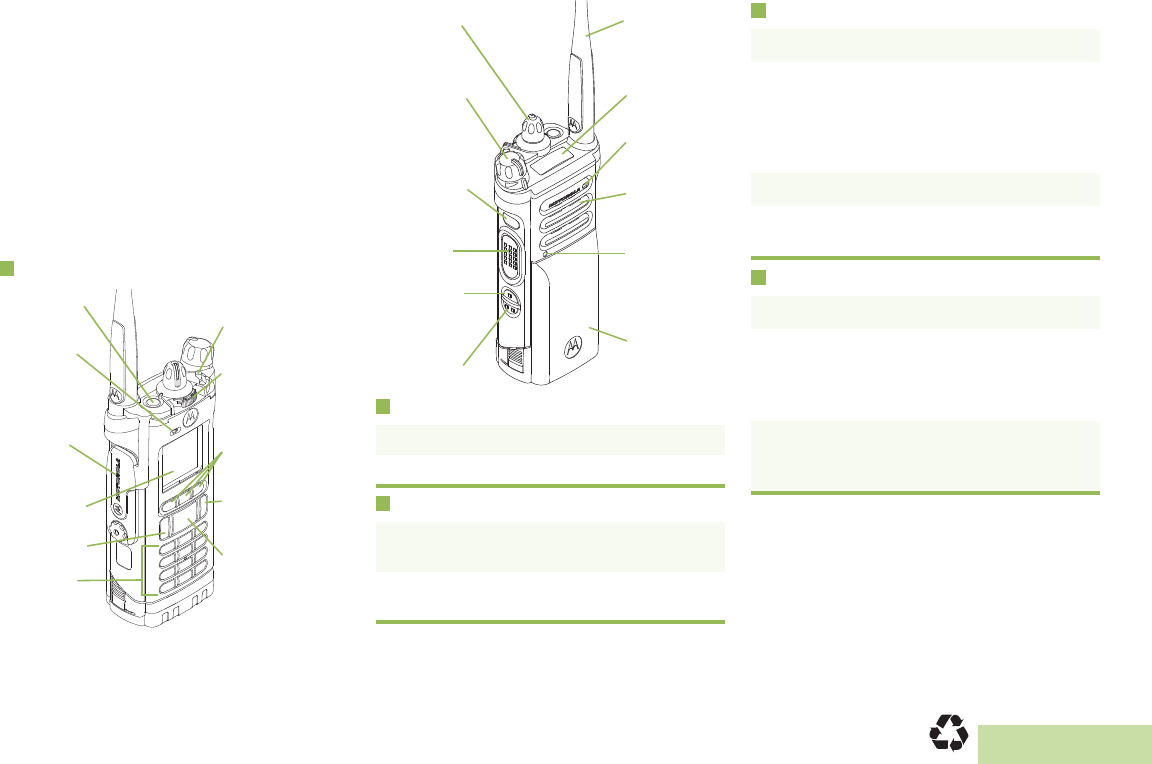
English
m
ASTRO® SRX™ 2200 Series
Digital Portable Radios
Quick Reference Card
RF Energy Exposure and Product Safety
Guide for Portable Two-Way Radios
ATTENTION!
This radio is restricted to Occupational use only. Before using
the radio, read the RF Energy Exposure and Product Safety
Guide for Portable Two-Way Radios which contains important
operating instructions for safe usage and RF energy awareness
and control for Compliance with applicable standards and
Regulations.
Radio Controls
Radio On/Off
Zones and Channels
Receiving and Transmitting
Sending an Emergency Alarm
* Default timer of Emergency button press to
activate Emergency is 50 milliseconds. This
timer is programmable, see Emergency
Operation in the user guide for details.
To exit emergency at any time, press and hold
the Emergency button.
Accessory
Connector
cover
Microphone
Top (Orange)
Button
__________
Keypad
Main Display
Home Button 4-Way Navigation
Button
Data Feature
Button
Menu Select
Buttons
3-Position A/B/C
Switch
__________
2-Position
Concentric Switch
__________
•On – On/Off/Volume knob clockwise.
•Off – On/Off/Volume knob counterclockwise.
•Zone – Toggle the Zone switch or use the
radio menu to the desired zone.
•Channel – Turn the Channel knob or use the
radio menu to the desired channel.
Battery
Side Button 1
__________
Side Button 2
__________
PTT Button
On/Off/Volume
Control Knob
16-Position
Select Knob
__________
Top Side (Select)
Button
__________ Main
Speaker
Microphone
Antenna
Bluetooth®
Pairing
Indicator
Top
Display
1Select zone/channel.
2Listen for a transmission.
OR
Press and hold Volume Set button.
OR
Press Monitor button and listen for activity.
3Adjust volume, if necessary.
4Press the PTT button to transmit; release to
receive.
1Press and hold the Emergency button*.
2The display shows Emergency and the
current zone/channel. Radio sounds a short,
medium-pitched tone, and the LED blinks red
momentarily.
3When acknowledgment is received, you hear
four beeps; alarm ends; and radio exits
emergency.
*PMLN6132E*
PMLN6132E
MOTOROLA, MOTO, MOTOROLA SOLUTIONS and the Stylized M logo are trademarks or registered trademarks of Motorola Trademark Holdings, LLC and are used under license. All
other trademarks are the property of their respective owners. © 2011 and 2015 by Motorola Solutions, Inc. All Rights Reserved. 06/15
1303 East Algonquin Road, Schaumburg, Illinois 60196, U.S.A.
QR-Card.fm Page 1 Friday, June 5, 2015 7:29 PM
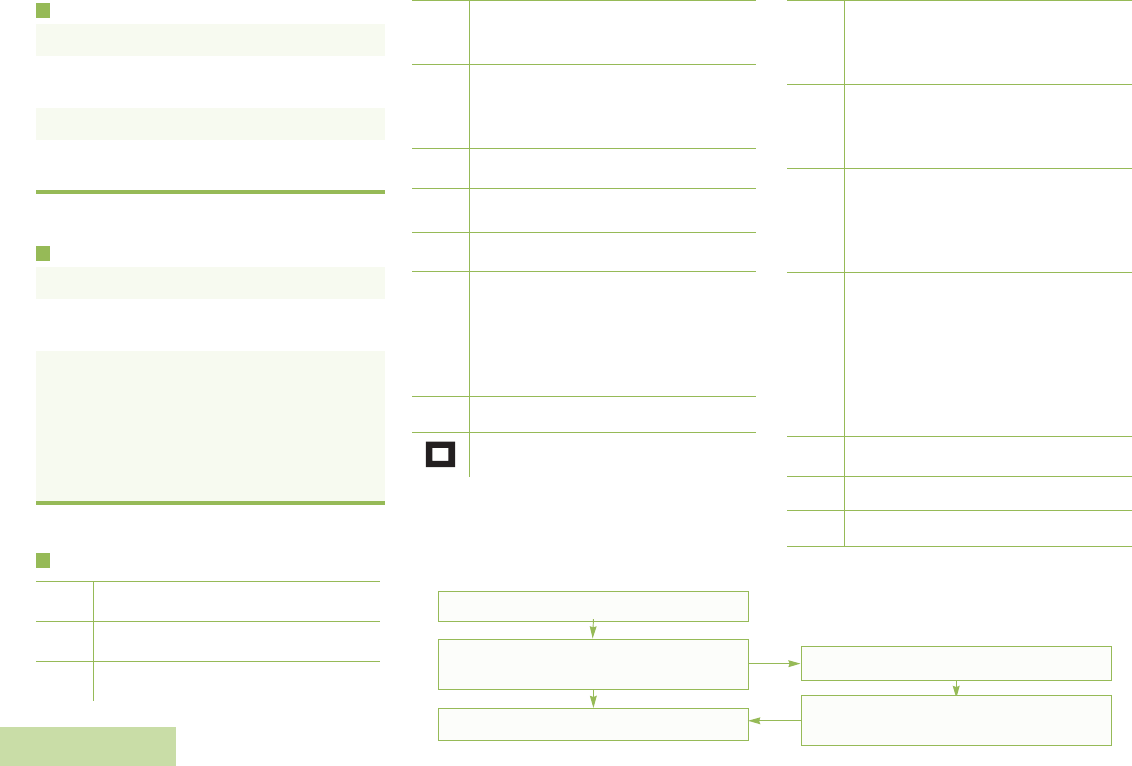
English
Menu Navigation
< or > to Menu Entry.
{, |, or } directly below Menu
Entry to select.
H to exit.
U or D to scroll through sub-list.
{, |, or } directly below Menu
Entry to select.
Sending an Emergency Call
To exit emergency at any time, press and hold
the Emergency button.
Sending a Silent Emergency Call
To exit emergency at any time, press and hold
the Emergency button.
Display Status Icons
1Press the Emergency button.
2Press and hold the PTT button. Speak clearly
into the microphone.
3Release the PTT button to end call.
4Press and hold Emergency button to exit
emergency.
1Press the Emergency button.
2The display does not change; the LED does
not light up, and there is no tone.
3Silent emergency continues until you:
Press and hold the Emergency button to exit
emergency state.
OR
Press and release the PTT button to exit the
Silent Emergency Alarm mode and enter
regular dispatch or Emergency Call mode.
Receiving a call or data.
Transmitting a call or data.
Blinks when the battery is low.
u
t
8
The more stripes, the stronger the
signal strength for the current site
(trunking only).
Direct radio to radio communication or
connected through a repeater.
On = Direct
Off = Repeater
This channel is being monitored.
L = Radio is set at Low power.
H = Radio is set at High power.
Scanning a scan list.
Blinking dot = Detects activity on the
Priority-One Channel
during scan.
Steady dot = Detects activity on the
Priority-Two Channel
during scan.
The vote scan feature is enabled.
On steady = View mode
Blinking = Program mode
v
O
M
HOR .
i
j
k
On = Secure operation.
Off = Clear operation.
Blinking = Receiving an encrypted
voice call.
On = AES Secure operation.
Off = Clear operation.
Blinking = Receiving an encrypted
voice call.
On = GPS enabled, and signal
available.
Off = GPS disabled.
Blinking = GPS enabled, but signal
unavailable.
On = User is currently associated with
the radio.
Off = User is currently not associated
with the radio.
Blinking = Device registration or user
registration with the server
failed due to an invalid
username or pin.
Data activity is present.
Bluetooth is ready.
Bluetooth is connected to the device.
m
l
G
n
o
b
a
QR-Card.fm Page 2 Friday, June 5, 2015 7:29 PM

Contents
Declaration of Conformity......................... 9
Important Safety Information........11
Software Version............................12
Notice to Users (FCC and Industry
Canada)....................................................12
Consignes de sécurité
importantes.................................13
Version logicielle........................... 14
Avis aux utilisateurs (FCC et Industrie
Canada)....................................................14
Computer Software Copyrights....15
Documentation Copyrights...........16
Disclaimer.......................................17
Getting Started............................... 18
How to Use This Guide..................................18
Notations Used in This Manual......................18
Additional Performance Enhancement.......... 19
ASTRO 25 Enhanced Data.................19
Dynamic System Resilience (DSR).... 19
CrossTalk Prevention..........................19
Encrypted Integrated Data (EID).........19
SecureNet...........................................19
Conventional Talkgroup and Radio
Scan Enhancements......................19
What Your Dealer/System Administrator
Can Tell You.............................................20
Preparing Your Radio for Use.......21
Charging the Battery......................................21
Attaching the Battery..................................... 21
Contents
1
English

Attaching the Antenna................................... 22
Removing and Attaching the Accessory
Connector Cover...................................... 23
Using the Carry Holder.................................. 24
Turning On the Radio.................................... 26
Adjusting the Volume.....................................27
Identifying Radio Controls............ 28
Radio Parts and Controls...............................28
Programmable Features................................29
Assignable Radio Functions............... 30
Assignable Settings or Utility
Functions....................................... 33
Accessing the Preprogrammed Functions.....34
Menu Select Buttons...........................34
Home Button.......................................35
4-Way Navigation Button.................... 35
Data Feature Button............................35
Keypad...........................................................35
Keypad Characters – Uppercase
Mode..............................................36
Keypad Characters – Lowercase
Mode..............................................37
Keypad Characters – Numeric
Mode..............................................38
Keypad Characters – Hexadecimal
Mode..............................................39
Push-To-Talk (PTT) Button............................40
Identifying Status Indicators.........41
Status Icons...................................................41
Text Messaging Service (TMS) Indicators.....45
TMS Status Icons................................46
TMS Menu Options.............................47
Call Type Icons..............................................47
LED Indicator.................................................48
Intelligent Lighting Indicators......................... 49
Alert Tones.................................................... 50
Phone Call Displays and Alerts..................... 54
General Radio Operation...............56
Selecting a Zone............................................56
Selecting a Radio Channel............................ 56
Selecting a Channel via Channel Search
Button....................................................... 57
Mode Select Feature..................................... 58
Saving a Zone and a Channel to a
Softkey...........................................58
Contents
2
English

Saving a Zone and a Channel to a
Button............................................ 59
Receiving and Responding to a Radio Call... 59
Receiving and Responding to a
Talkgroup Call................................59
Receiving and Responding to a
Private Call (Trunking Only)...........60
Receiving and Responding to a
Telephone Call (Trunking Only).....61
Methods to Make a Radio Call.......................61
Making a Talkgroup Call..................... 62
Making a Private Call (Trunking
Only).............................................. 62
Making an Enhanced Private Call
(Trunking Only).............................. 63
Making a Telephone Call (Trunking
Only).............................................. 64
Switching Between Repeater or Direct
Operation Button...................................... 65
Monitor Feature............................................. 65
Monitoring a Channel..........................65
Monitoring Conventional Mode........... 66
Advanced Features........................67
Advanced Call Features................................ 67
Selective Call (ASTRO
Conventional Only)........................ 67
Talkgroup Call Feature
(Conventional Operation Only)...... 68
Sending a Status Call......................... 69
Responding to the Dynamic
Regrouping Feature (Trunking
Only).............................................. 69
Dynamic Zone Programming (DZP)....71
Contacts.........................................................73
Making a Private Call from Contacts...74
Adding a New Contact Entry...............75
Deleting a Contact Entry.....................76
Adding a Contact to a Call List............76
Removing a Contact from a Call
List................................................. 77
Methods of Contact Editing in a
Call List.......................................... 77
Viewing Details of a Contact...............79
Scan Lists...................................................... 79
Viewing a Scan List.............................79
Editing the Scan List........................... 79
Changing the Scan List Status............80
Viewing and Changing the Priority
Status.............................................81
Scan...............................................................82
Turning Scan On or Off.......................82
Contents
3
English

Making a Dynamic Priority Change
(Conventional Scan Only)..............82
Deleting a Nuisance Channel............. 82
Restoring a Nuisance Channel........... 83
Call Alert Paging............................................83
Receiving a Call Alert Page................ 83
Sending a Call Alert Page...................84
Quick Call II (ASTRO P25 Digital
Trunking and Conventional)..................... 85
Initiating a Quick Call II
Transmission................................. 86
Emergency Operation....................................86
Sending an Emergency Alarm............ 87
Sending an Emergency Call
(Trunking Only).............................. 88
Sending an Emergency Alarm with
Emergency Call............................. 88
Sending a Silent Emergency Alarm.... 89
Change of Channels during
Emergency.....................................89
Emergency Keep-Alive Feature..........90
Man Down......................................................90
Pre-Alert Timer....................................92
Post-Alert Timer..................................92
Radio Alerts When Man Down
Feature is Triggered...................... 92
Triggering Emergency.........................92
Radio Alerts When Man Down
Enhanced is Triggered...................93
Exiting Man Down Feature..................93
Re-Initiating Man Down.......................94
Testing the Man Down Feature...........94
Automatic Registration Service (ARS)...........94
Selecting or Changing the ARS
Mode..............................................95
User Login Feature............................. 95
Text Messaging Service (TMS)..................... 97
Accessing the Messaging Features....98
Composing and Sending a New
Text Message................................ 99
Sending a Quick Text Message........100
Priority Status and Request Reply
of a New Text Message............... 101
ASTRO 25 Advanced Messaging Solution..108
System Setup for ASTRO
Advanced Messaging Solution.... 109
Two-Factor Authentication................109
Sending a Query...............................112
Receiving a Query............................ 113
Secure Operations.......................................114
Selecting Secure Transmissions.......114
Selecting Clear Transmissions......... 114
Managing Encryption........................ 115
Security........................................................120
Contents
4
English

Radio Lock........................................120
Radio Stun and Kill...................................... 123
Radio Stun........................................ 123
Radio Kill...........................................124
Global Positioning System / Global
Navigation Satellite System....................125
GPS Operation..................................125
GPS Performance Enhancement......126
The Outdoor Location Feature
(Using GPS).................................126
Military Grid Reference System
(MGRS) Coordinates................... 127
Accessing the Outdoor Location
Feature........................................ 127
Saving a Waypoint............................128
Viewing a Saved Waypoint............... 129
Editing the Alias of a Waypoint......... 129
Editing the Coordinates of a
Waypoint......................................130
Deleting a Single Saved Waypoint....131
Deleting All Saved Waypoints...........132
Measuring the Distance and
Bearing from a Saved Waypoint.. 132
Location Feature in Emergency
Mode............................................133
Peer-Location on the Display
(ASTRO Conventional only)........ 133
Geofence (ASTRO 25 Trunking System).... 134
Entering the Geofence Area............. 135
Trunking System Controls........................... 136
Operating in Failsoft System.............136
Out-of-Range Radio..........................136
Site Trunking Feature....................... 137
Locking and Unlocking a Site............137
Site Display and Search Button........ 137
Mission Critical Wireless - Bluetooth®-........ 138
Turning On Bluetooth .......................139
Turning Off the Bluetooth..................139
Re-Pair Timer....................................140
Bluetooth Drop Timer........................141
Pairing with Low Frequency-
Motorola Proximity Pairing (LF-
MPP) Feature.............................. 142
Radio Indications of Lost Bluetooth
Connection...................................143
Standard Pairing Feature..................143
PIN Authentication in Pairing............ 146
Turning On the Bluetooth Audio
(Routing the Audio from the
Radio to the Headset)..................149
Turning Off the Bluetooth Audio
(Routing the Audio from the
Headset to the Radio)..................150
Contents
5
English

Adjusting the Volume of the Radio
from Bluetooth Audio Device....... 150
Viewing and Clearing the Bluetooth
Device Information.......................151
Clearing All Bluetooth Devices
Information...................................152
Editing the Bluetooth Friendly
Name........................................... 153
Over-the-Air Programming (POP 25,
ASTRO 25, ASTRO Conventional).........153
Responding to the Notification of
Upgrade....................................... 154
Voice Announcement...................................154
Site Selectable Alerts (ASTRO 25)..............155
Sending SSA Notification to Single
Site...............................................156
Sending SSA Notification to Single
Site Via Manual Entry.................. 157
Sending SSA Notification to All
Sites.............................................158
Sending SSA Notification to All
Available Sites............................. 158
Stopping SSA Notification of a
Single Site....................................159
Stopping SSA Notification of a
Single Site Via Manual Entry....... 159
Stopping SSA Notification of All
Sites.............................................160
Stopping SSA Notification of All
Available Sites............................. 161
Utilities......................................................... 161
Viewing Recent Calls........................161
Using the Flip Display....................... 162
Selecting a Basic Zone Bank............162
Selecting an Enhanced Zone Bank.. 163
Selecting the Power Level................ 163
Selecting a Radio Profile...................164
Enabling and Disabling the Radio
Alias............................................. 165
Selecting the Audio Speaker.............165
Controlling the Display Backlight...... 166
Setting Up the Radio Display and
Visual Indicators to Suit Night
Vision Goggles.............................167
Locking and Unlocking the Keypad
and Controls................................ 168
Turning the Controls and Keypad
Buttons Tones On or Off..............168
Turning Voice Mute On or Off...........169
Using the Time-Out Timer.................169
Time and Date Setup........................170
Using Conventional Squelch
Operation Features......................171
Contents
6
English

Using the PL Defeat Feature............ 171
Digital PTT ID Support......................172
Smart PTT Feature (Conventional
Only)............................................ 172
Transmit Inhibit................................. 173
IMPRES Battery Annunciator............174
General Radio Information................175
Helpful Tips.................................. 179
Radio Care...................................................179
Cleaning Your Radio.........................180
Preparation for Washing the Radio
and Parts..................................... 180
Proper Ways to Handle the Radio.... 185
Radio Service and Repair.................185
Battery Care.................................................186
Battery Charge Status.......................186
Battery Recycling and Disposal........ 187
Accessories..................................188
Maritime Radio Use in the VHF
Frequency Range..................... 189
Special Channel Assignments.....................189
Emergency Channel......................... 189
Non-Commercial Call Channel......... 189
Operating Frequency Requirements............189
Declaration of Compliance for the Use of
Distress and Safety Frequencies............192
Technical Parameters for Interfacing
External Data Sources............................192
Glossary........................................193
Limited Warranty..........................199
MOTOROLA COMMUNICATION
PRODUCTS........................................... 199
I. WHAT THIS WARRANTY COVERS
AND FOR HOW LONG:......................... 199
II. GENERAL PROVISIONS:....................... 200
III. STATE LAW RIGHTS:............................201
IV. HOW TO GET WARRANTY SERVICE:.201
V. WHAT THIS WARRANTY DOES NOT
COVER:..................................................201
VI. PATENT AND SOFTWARE
PROVISIONS:........................................ 202
VII. GOVERNING LAW:...............................203
Contents
7
English

Declaration of Conformity
This declaration is applicable to your radio only if your radio is labeled with the FCC logo shown below.
Declaration of Conformity
Per FCC CFR 47 Part 2 Section 2.1077(a)
Responsible Party
Name: Motorola Solutions, Inc.
Address: 1303 East Algonquin Road, Schaumburg, IL 60196-1078, U.S.A.
Phone Number: 1-800-927-2744
Hereby declares that the product:
Model Name: SRX 2200
conforms to the following regulations:
FCC Part 15, subpart B, section 15.107(a), 15.107(d) and section 15.109(a)
Declaration of Conformity
9
English

Class B Digital Device
As a personal computer peripheral, this device complies with Part 15 of the FCC Rules. Operation is subject to the
following two conditions:
1This device may not cause harmful interference, and
2This device must accept any interference received, including interference that may cause undesired operation.
Note:
This equipment has been tested and found to comply with the limits for a Class B digital device, pursuant
to part 15 of the FCC Rules. These limits are designed to provide reasonable protection against harmful
interference in a residential installation. This equipment generates, uses and can radiate radio frequency
energy and, if not installed and used in accordance with the instructions, may cause harmful interference
to radio communications. However, there is no guarantee that interference will not occur in a particular in-
stallation.
If this equipment does cause harmful interference to radio or television reception, which can be determined
by turning the equipment off and on, the user is encouraged to try to correct the interference by one or
more of the following measures:
• Reorient or relocate the receiving antenna.
• Increase the separation between the equipment and receiver.
• Connect the equipment into an outlet on a circuit different from that to which the receiver is connected.
• Consult the dealer or an experienced radio or TV technician for help.
Declaration of Conformity
10
English

Important Safety Information
RF Energy Exposure and Product Safety Guide
for Portable Two-Way Radios
ATTENTION!
This radio is restricted to Occupational use only.
Before using the radio, read the RF Energy Exposure
and Product Safety Guide for Portable Two-Way
Radios which contains important operating
instructions for safe usage and RF energy awareness
and control for Compliance with applicable standards
and Regulations.
For a list of Motorola-approved antennas, batteries,
and other accessories, visit the following website:
http://www.motorolasolutions.com/APX
Under Industry Canada regulations, this radio
transmitter may only operate using an antenna of a
type and maximum (or lesser) gain approved for the
transmitter by Industry Canada. To reduce potential
radio interference to other users, the antenna type
and its gain should be so chosen that the equivalent
isotropically radiated power (e.i.r.p.) is not more than
that necessary for successful communication.
This radio transmitter has been approved by Industry
Canada to operate with Motorola-approved antenna
with the maximum permissible gain and required
antenna impedance for each antenna type indicated.
Antenna types not included in this list, having a gain
greater than the maximum gain indicated for that
type, are strictly prohibited for use with this device.
Important Safety Information
11
English

Software Version
All the features described in the following sections are
supported by the software version R14.00.00 or later.
See Accessing the Radio Information on page 175 to
determine the software version of your radio.
Check with your dealer or system administrator for
more details of all the features supported.
Notice to Users (FCC and Industry Canada)
This device complies with Part 15 of the FCC rules
and RSS 210 of the Industry Canada rules per the
following conditions:
• This device may not cause harmful interference.
• This device must accept any interference
received, including interference that may cause
undesired operation.
• Changes or modifications made to this device, not
expressly approved by Motorola, could void the
authority of the user to operate this equipment.
Software Version
12
English

Consignes de sécurité importantes
Radios bidirectionnelles portatives : exposition
aux radiofréquences et sécurité du produit
ATTENTION!
Cette radio ne doit être utilisée qu'à des fins
professionnelles. Avant d'utiliser la radio, lisez le
guide Radios bidirectionnelles portatives : exposition
aux radiofréquences et sécurité du produit, qui
contient d'importantes instructions de fonctionnement
pour une utilisation sécuritaire et des informations sur
l'exposition aux fréquences radioélectriques, dans le
but d’assurer votre conformité aux normes et
règlements en vigueur.
Visitez le site Web suivant pour obtenir la liste des
antennes, des batteries et des autres accessoires
approuvés par Motorola :
http://www.motorolasolutions.com/APX
Selon la réglementation d'Industrie Canada, cet
émetteur radio ne peut être utilisé qu'avec une
antenne dont le type et le gain maximal (ou minimal)
sont approuvés par Industrie Canada pour cet
émetteur. Afin de limiter les interférences radio pour
les autres utilisateurs, le type et le gain de l'antenne
doivent être choisis de façon à ce que la puissance
isotrope rayonnée équivalente (P.I.R.E.) ne soit pas
plus forte qu'il ne le faut pour établir la
communication.
Cet émetteur radio a été approuvé par Industrie
Canada pour utilisation avec une antenne approuvée
par Motorola offrant le gain maximal autorisé et
l'impédance requise pour le type d'antenne indiqué. Il
est strictement interdit d'utiliser avec cet appareil tout
type d'antenne ne figurant pas dans cette liste et
présentant un gain supérieur au maximum indiqué
pour le type.
Consignes de sécurité importantes
13
English

Version logicielle
Toutes les fonctions décrites dans les sections
suivantes sont prises en charge par la version
R14.00.00 ou les versions ultérieures du logiciel de la
radio.
Pour obtenir davantage de renseignements à propos
des fonctions prises en charge, adressez-vous à
votre détaillant ou à votre administrateur de système.
Avis aux utilisateurs (FCC et Industrie
Canada)
Cet appareil est conforme à la Partie 15 des
règlements de la FCC et RSS 210 du règlement
d'Industrie Canada selon les conditions énumérées
ci-dessous:
• Ce dispositif ne doit pas causer d'interférences
nuisibles.
• Cet appareil doit accepter toute interférence
reçue, y compris les interférences qui peuvent
perturber le fonctionnement.
• Les changements ou les modifications apportées
à ce dispositif, non expressément approuvées par
Motorola, peuvent annuler le droit de l'utilisateur à
utiliser cet équipement.
Version logicielle
14
English

Computer Software Copyrights
The Motorola products described in this manual may
include copyrighted Motorola computer programs
stored in semiconductor memories or other media.
Laws in the United States and other countries
preserve for Motorola certain exclusive rights for
copyrighted computer programs including, but not
limited to, the exclusive right to copy or reproduce in
any form the copyrighted computer program.
Accordingly, any copyrighted Motorola computer
programs contained in the Motorola products
described in this manual may not be copied,
reproduced, modified, reverse-engineered, or
distributed in any manner without the express written
permission of Motorola. Furthermore, the purchase of
Motorola products shall not be deemed to grant either
directly or by implication, estoppel, or otherwise, any
license under the copyrights, patents or patent
applications of Motorola, except for the normal non-
exclusive license to use that arises by operation of
law in the sale of a product.
Computer Software Copyrights
15
English

Documentation Copyrights
No duplication or distribution of this document or any
portion thereof shall take place without the express
written permission of Motorola. No part of this manual
may be reproduced, distributed, or transmitted in any
form or by any means, electronic or mechanical, for
any purpose without the express written permission of
Motorola.
Documentation Copyrights
16
English

Disclaimer
The information in this document is carefully
examined, and is believed to be entirely reliable.
However, no responsibility is assumed for
inaccuracies. Furthermore, Motorola reserves the
right to make changes to any products herein to
improve readability, function, or design. Motorola
does not assume any liability arising out of the
applications or use of any product or circuit described
herein; nor does it cover any license under its patent
rights, nor the rights of others.
Disclaimer
17
English
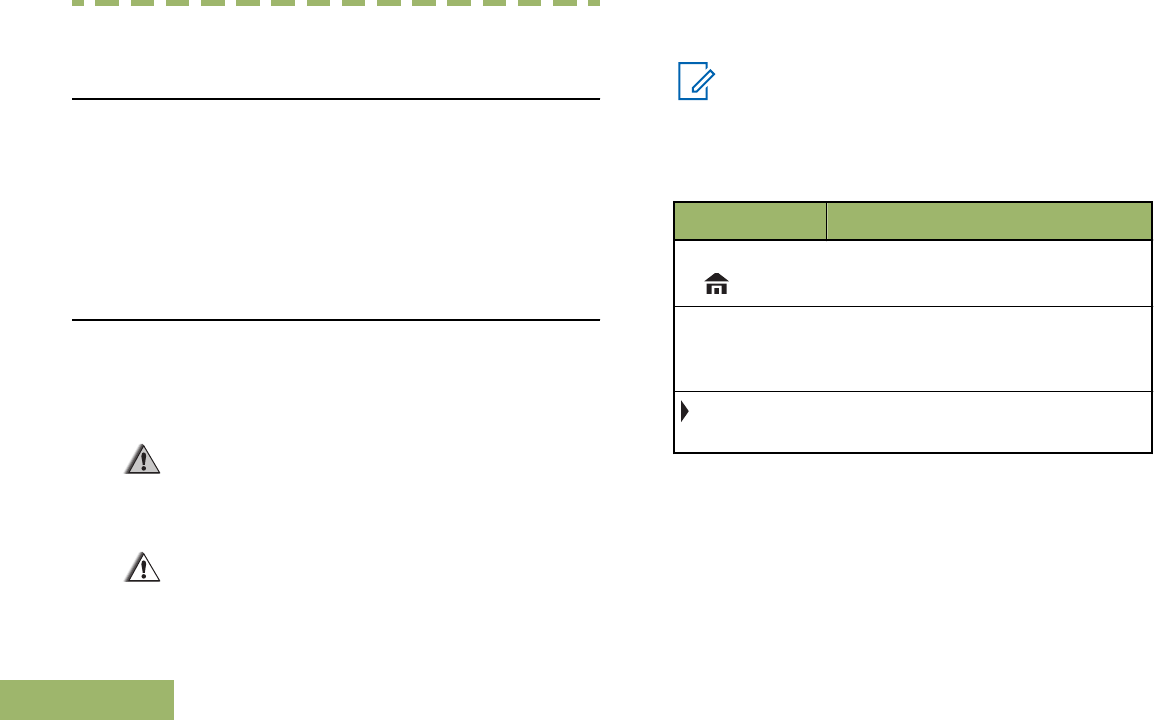
Getting Started
How to Use This Guide
This User Guide covers the basic operation of the
APX Portables.
However, your dealer or system administrator may
have customized your radio for your specific needs.
Check with your dealer or system administrator for
more information.
Notations Used in This Manual
Throughout the text in this publication, you will notice
the use of Warning, Caution, and Note. These
notations are used to emphasize that safety hazards
exist, and the care that must be taken or observed.
Warning:
An operational procedure, practice, or
condition and so on, which may result in injury
or death if not carefully observed.
Caution:
An operational procedure, practice, or
condition and so on, which may result in
damage to the equipment if not carefully
observed.
Note:
An operational procedure, practice, or
condition and so on, which is essential to
emphasize.
The following special notations identify certain items.
Example Description
Home button
or
Buttons and keys are shown in
bold print or as an icon.
Phon Menu entries are shown similar to
the way they appear on the display
of the radio.
This means “Press the right side of
the 4-Way Navigation Button”.
Getting Started
18
English

Additional Performance Enhancement
The following performance enhancements are some
of the latest creations designed to enhance the
security, quality and efficiency of the radios.
ASTRO 25 Enhanced Data
ASTRO 25 Enhanced Data is optimized to handle
different message sizes and variable update rates
from different applications of the radio. Add Enhanced
Data to the Integrated Data system with a software
installation to improve data channel efficiency and
enable denser network traffic.
Dynamic System Resilience (DSR)
DSR ensures the radio system is seamlessly
switched to a backup master site dynamically in case
of system failure. DSR also provides additional
indication e.g. failure detection, fault recovery, and
redundancy within the system to address to the user
in need. Mechanisms related to the Integrated Voice
and Data (IV&D) or data centric are all supported by
DSR.
CrossTalk Prevention
This feature prevents crosstalk scenarios from
happening, especially when a wideband antenna is
used. This feature allows the adjustment of the
internal SSI clock rate of the radio. This subsequently
reduces the possibility of radio frequency interfering
spurs and prevents the issues of crosstalk.
Encrypted Integrated Data (EID)
EID provides security encryption and authentication
of IV&D data bearer service communication between
the radio and the Customer Enterprise Network.
SecureNet
SecureNet allows user to perform secured
communications on an Analog or Motorola Data
Communication (MDC) channel. The MDC Over-the-
Air Rekeying (OTAR) feature will allow users to
perform OTAR activities on an MDC channel.
Conventional Talkgroup and Radio Scan
Enhancements
A few enhancements have been made to the
Conventional Talkgroup at the system. These
enhancements improve the Scan feature operation
significantly when multiple agencies are using a
Getting Started
19
English

single conventional radio frequency channel. These
enhancements allow users to use Selective Squelch
to operate on only the subset of talkgroups that are
relevant to the users rather than all talkgroups on the
channel. These Scan improvements have been made
to eliminate the audio holes that were present and to
turn on the busy LED when activity is present on the
channel. Mixed Vote Scan and Standard
Conventional Scan configurations are supported.
Priority Operation is also supported.
Up to 30 different talkgroups can be supported using
conventional channels. A maximum of four talkgroups
can be supported when Vote Scan channels are
being used.
Smart PTT is supported with this enhancement as
Smart PTT prevents users from transmitting while
other users are on the channel.
Note:
User Selectable Talkgroups are not
compatible with this Conventional Talkgroup
Enhancement.
What Your Dealer/System Administrator Can
Tell You
Check with your dealer or system administrator for
the correct radio settings, if the radio is to be
operated in extreme temperatures (less than -30 °C
or more than +60 °C).
You can consult your dealer or system administrator
about the following:
• Is your radio programmed with any preset
conventional channels?
• Which buttons have been programmed to access
other features?
• What optional accessories may suit your needs?
Note:
Specifications may vary for different radio
models. Check with your dealer or system
administrator for more information.
Getting Started
20
English

Preparing Your Radio for Use
This section provides simple instructions to prepare
your radio for use.
Charging the Battery
Warning:
To avoid a possible explosion:
• Do not replace the battery in any area
labeled hazardous atmosphere.
• Do not discard batteries in a fire.
The Motorola-approved battery shipped with your
radio is uncharged. Prior to using a new battery,
charge it for a minimum of 16 hours to ensure
optimum capacity and performance. For a list of
Motorola-authorized batteries and chargers available
for use with your radio, see Accessories on page
188.
Note:
When charging a battery attached to a radio,
turn the radio off to ensure a full charge.
To charge the battery, place the battery (with or
without the radio) in a Motorola-approved charger.
The LED on the charger indicates the charging
progress; see the charger user guide.
Attaching the Battery
If your radio is preprogrammed with volatile-key
retention, the encryption keys are retained for
approximately 30 seconds after battery removal.
Check with your dealer or system administrator for
more information.
You can view the status of the IMPRES™ battery if the
radio is using an IMPRES battery. See IMPRES
Battery Annunciator on page 174 for more
information.
1Slide the battery into the radio frame until the side
latches click into place.
Preparing Your Radio for Use
21
English
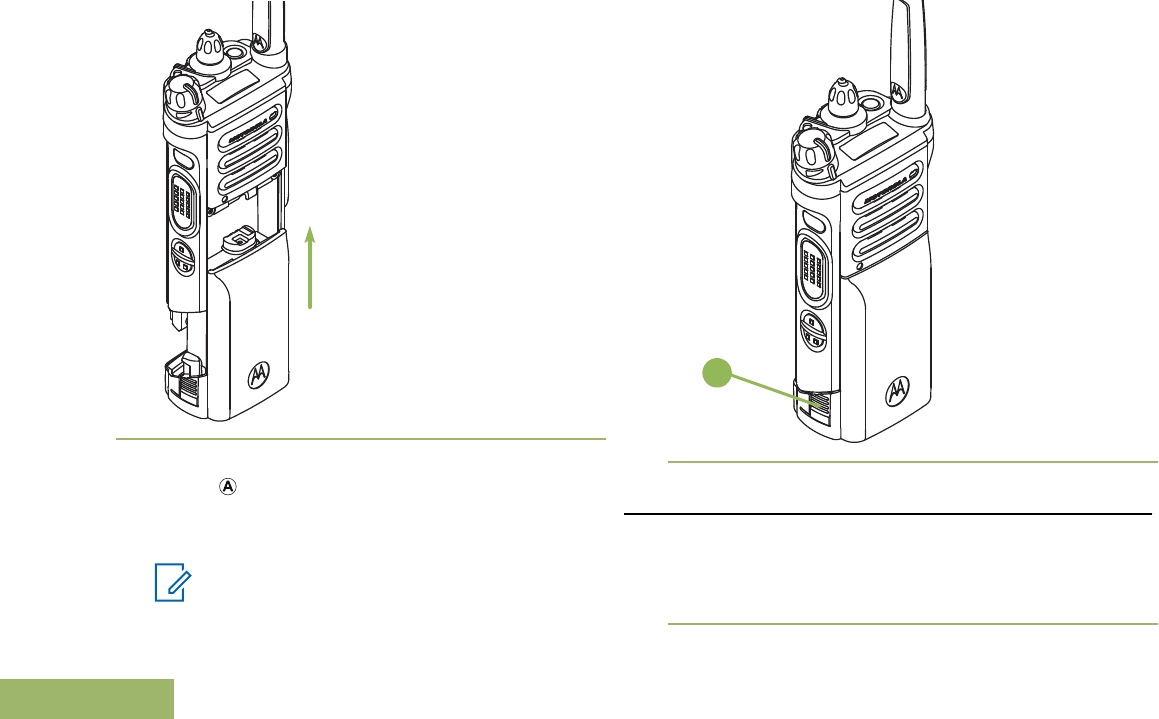
2To remove the battery, squeeze the release
latches at the bottom of the battery until the
battery releases from the radio and remove the
battery from the radio.
Note:
When removing the battery, ensure that the
radio is turned off.
A
Attaching the Antenna
Ensure the radio is turned off before attaching the
antenna.
1Set the antenna in its receptacle.
Preparing Your Radio for Use
22
English
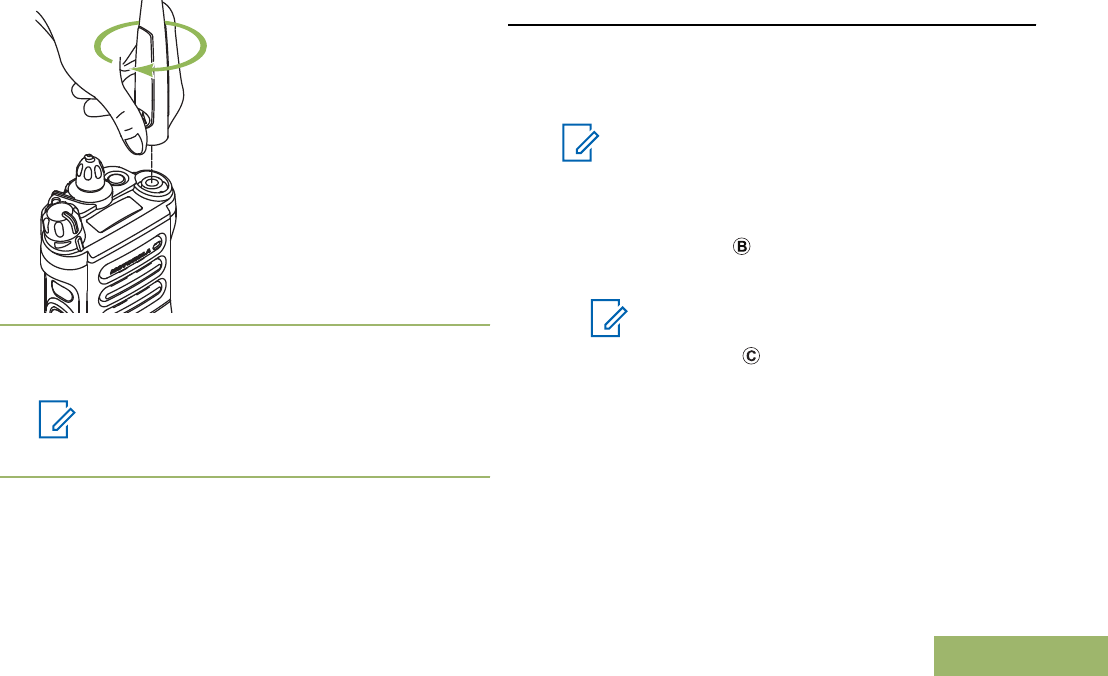
2Turn the antenna clockwise to attach to the radio.
3To remove the antenna, turn the antenna
counterclockwise.
Note:
When removing the antenna, ensure that
the radio is turned off.
Removing and Attaching the Accessory
Connector Cover
The accessory connector is on the antenna side of
the radio. It is used to connect accessories to the
radio.
Note:
To prevent damage to the connector, shield it
with the connector cover when not in use.
1To remove the accessory connector cover, rotate
the thumbscrew counterclockwise until it
disengages from the radio.
Note:
If the thumbscrew is too tight, use an Allen
wrench at to loosen it first.
Preparing Your Radio for Use
23
English
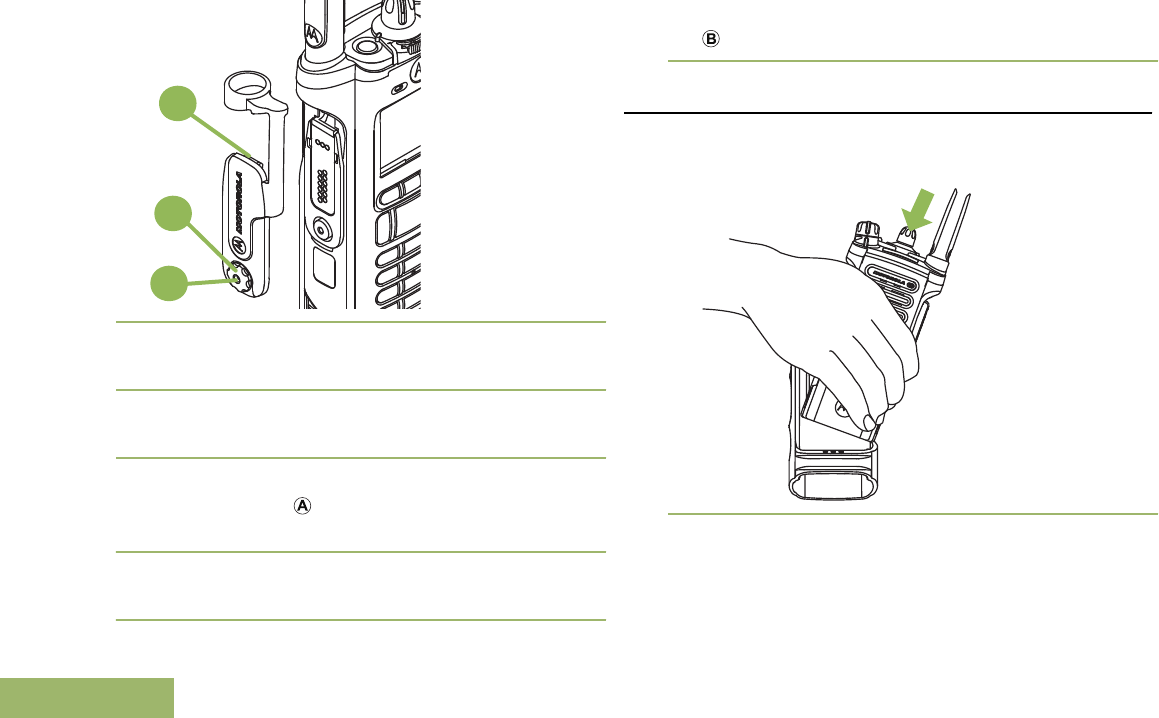
A
B
C
2Rotate and lift the connector cover to disengage it
from the radio.
3Slide the accessory connector cover over the
antenna and position at the base of the antenna.
4To attach the accessory connector cover, insert
the hooked end of the cover into the slot above
the connector.
5Press downward on the cover’s top to seat it in the
slot.
6Once in place, tighten by rotating the thumbscrew
clockwise by hand.
Using the Carry Holder
1Position the radio within the carry holder with the
main speaker facing outward.
2Slide the radio down into the carry holder until it
clicks in place.
Preparing Your Radio for Use
24
English
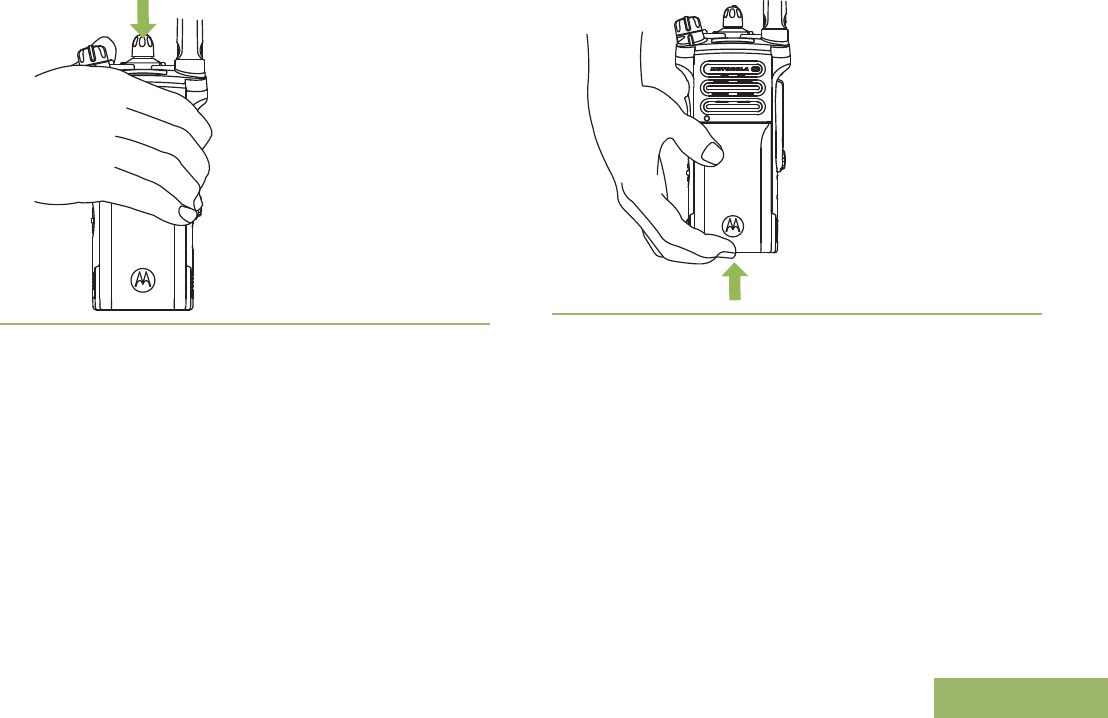
3To remove the radio from the carry holder, place
the tip of your fingers on the ledge of the carry
holder.
4Push at the bottom of the radio until the radio is
released from it.
Preparing Your Radio for Use
25
English
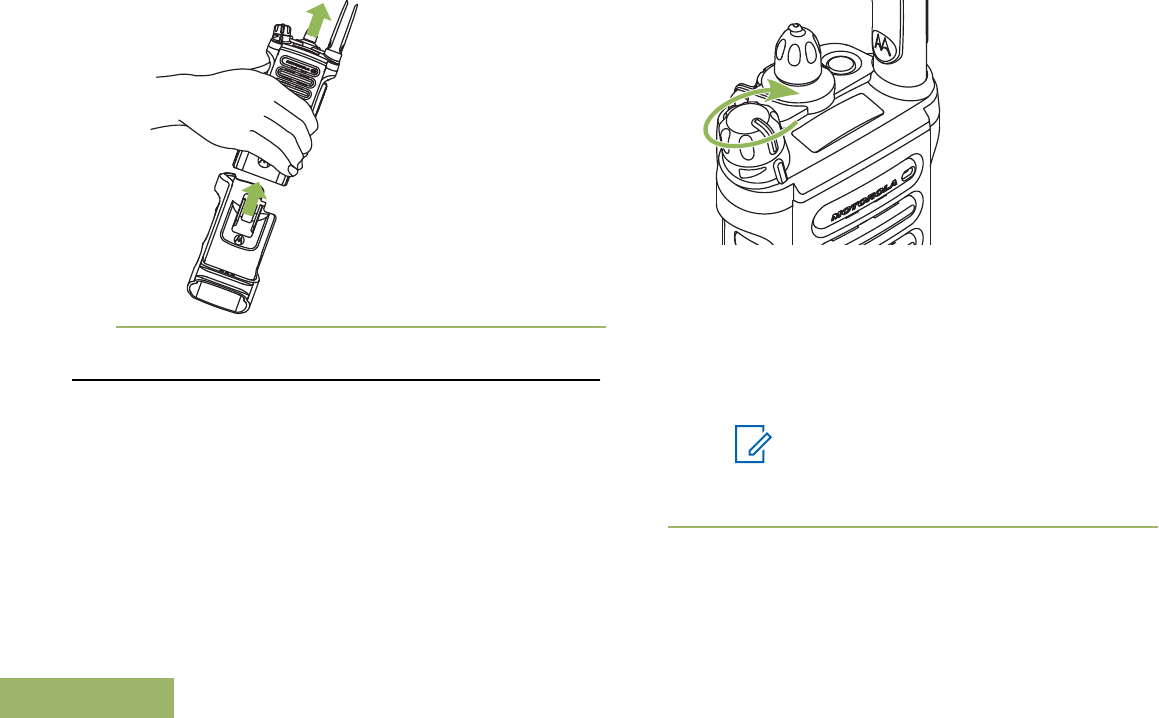
Turning On the Radio
1Rotate the On/Off/Volume Control Knob
clockwise until you hear a click.
• If the power-up test is successful, you see
momentary SELFTEST on the radio display,
followed by the Home screen.
• If the power-up test is unsuccessful, you see
Error XX/YY (XX/YY is an alphanumeric
code).
Note:
If the radio fails to power-up after
repeating a few times, record the Error
XX/YY code and contact your dealer.
2To turn off the radio, rotate the On/Off/Volume
Control Knob counterclockwise until you hear a
click.
Preparing Your Radio for Use
26
English
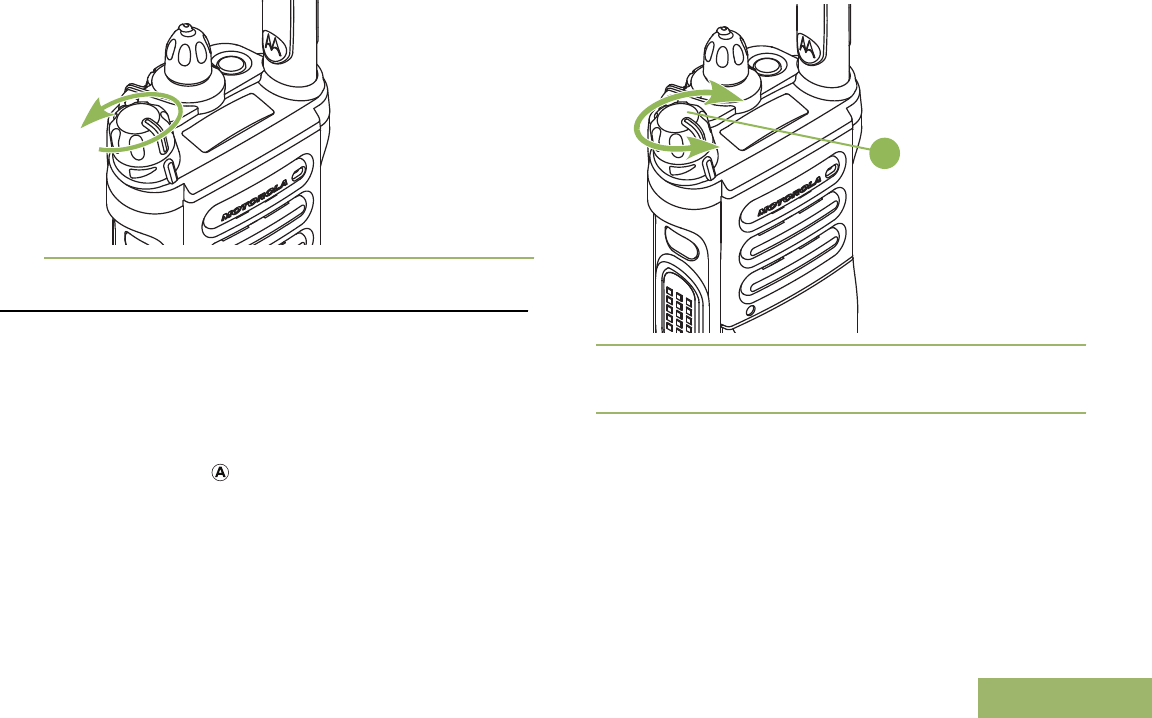
Adjusting the Volume
Ensure the radio is power on and the main speaker is
pointed towards you for increased loudness and
intelligibility, especially in areas with loud background
noises.
1To increase the volume, rotate the On/Off/Volume
Control Knob clockwise.
A
2To decrease the volume, rotate this knob
counterclockwise.
Preparing Your Radio for Use
27
English
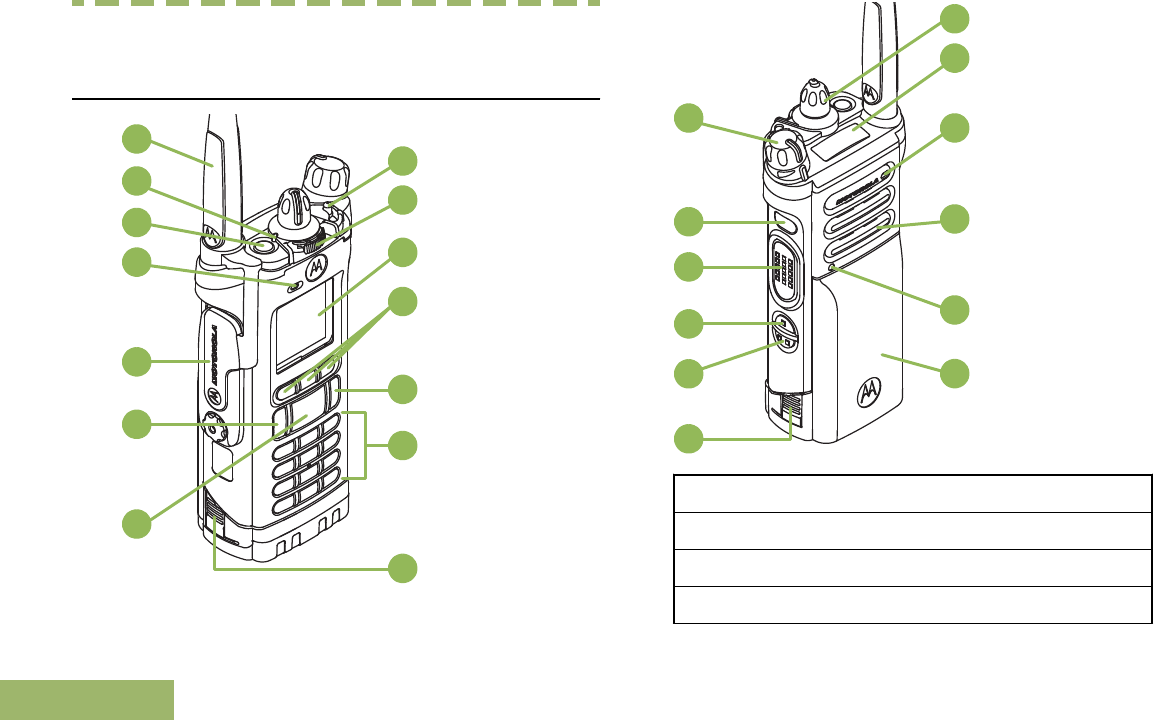
Identifying Radio Controls
Radio Parts and Controls
9
10
11
12
13
14
4
3
2
1
5
6
7
8
20
21
22
23
24
25
16
15
17
18
19
8
1 Antenna
2 LED
3 Top (Orange) Button[1]
4 Microphone
Identifying Radio Controls
28
English

5 Accessory Connector
6 Home Button
7 4–Way Navigation Button
8 Battery Latch
9 Keypad
10 Data Feature Button
11 Menu Select Buttons
12 Main Display
13 3–Position A/B/C Switch[1]
14 2–Position Concentric Switch[1]
15 On/Off/Volume Control Knob
16 Top Side (Select) Button[1]
17 Push-to-Talk (PTT) Button
18 Side Button 1[1]
19 Side Button 2[1]
20 Battery
21 Bluetooth Pairing Location Indicator
22 Main Speaker
23 Microphone
24 Top Display
25 16-Position Select Knob[1]
Programmable Features
Any reference in this manual to controls that are
preprogrammed means that a qualified radio
technician must use the radio programming software
to assign a feature to a control.
Your dealer can program the programmable buttons
as shortcuts to radio functions or preset channels/
groups depending on the duration of a button press:
Press Pressing and releasing rapidly.
1These radio controls/buttons are programmable.
Identifying Radio Controls
29
English

Long press Pressing and holding for the
preprogrammed duration (between
0.25 seconds and 3.75 seconds).
Hold down Keeping the button pressed.
Assignable Radio Functions
Bluetooth On/Off Allows you to turn on/off the
Bluetooth.
Bluetooth
Configuration
Allows you to access to the
Bluetooth menu.
Bluetooth Audio
Reroute
Allows you to toggle the audio
route between radio speaker or
Remote Speaker Microphone
and Bluetooth headset.
Bluetooth
Headset PTT
Keys up the Bluetooth Headset
microphone.
Bluetooth Data
Devices
Pairs with the data devices for
data transfer.
Bluetooth Clear
All Pairing
Allows you to clear all pairing
information for Bluetooth. This
is accessed by a long press of
the Bluetooth On/Off Button.
Bluetooth Inquiry
On/Off
Enables Bluetooth Search
feature.
Bluetooth
Discoverable
On/Off
Enables Bluetooth visibility.
This is accessed by a long
press of the Bluetooth Inquiry
On/Off Button.
Call Alert Allows the radio to function like
a pager, or to verify if a radio is
active on the system.
Call Response Allows you to answer a private
call.
Channel Selects a channel.
Contacts Selects the Contacts menu.
Dynamic ID
(Conventional
Only)
Allows you to edit the ASTRO
Individual ID and/or MDC
Primary ID of the radio.
Dynamic Priority
(Conventional
Only)
Allows any channel in a Scan
List (except for the Priority-One
channel) to temporarily replace
the Priority-Two channel.
Identifying Radio Controls
30
English

Emergency Depending on the
programming, initiates or
cancels an emergency alarm or
call.
Information Displays the information of the
radio.
Internet Protocol
Address
Display the Internet Protocol
(IP) address, device name and
status of the radio.
Location Determines the current location
(latitude, longitude, time and
date), and also the distance
and bearing to another location.
Or, turns the GPS functionality
on or off for all locations.
Man Down Clear Clears the alarm of Man Down
mode which was triggered
when your radio achieves or
passes a tilt angle threshold or
a combination of the angle
threshold and a motion
sensitivity level.
Message Enters the current message list.
Mode Select Long-press programs a button
with the current zone and
channel of the radio; once
programmed, the short-press of
that button changes the radio
zone channel to the
programmed zone and channel.
Monitor
(Conventional
Only)
Monitors a selected channel for
all radio traffic until function is
disabled.
Multiple Private
Line
(Conventional
Only)
Selects the Multiple Private
Line lists.
Nuisance Delete Temporarily removes an
unwanted channel, except for
priority channels or the
designated transmit channel
from the scan list.
One Touch 1– 4 Launches a specific feature
with one single button-press.
You can setup as many as four
separately programmed buttons
for four different features.
Identifying Radio Controls
31
English

Phone Allows you to make and receive
calls similar to standard phone
calls.
Private Call
(Trunking Only)
Allows a call from an individual
radio to another individual
radio.
Private Line
Defeat
(Conventional
Only)
Overrides any coded squelch
(DPL or PL) that is
preprogrammed to a channel.
Query Launches a list of predefined
short text messages only after
successfully logged in the two-
Factor Authentification.
Radio Profiles Allows easy access to a set of
preprogrammed visual and
audio settings of the radio.
Recent Calls Allows easy access to the list of
calls recently received or made.
Rekey Request Notifies the dispatcher you want
a new encryption key.
Repeater Access
Button (RAB)
Allows user to manually send a
repeater access codeword.
(Conventional
Only)
Reprogram
Request
(Trunking Only)
Notifies the dispatcher you want
a new dynamic regrouping
assignment.
Request-To-Talk
(Conventional
Only)
Notifies the dispatcher you want
to send a voice call.
Scan Toggles scan on or off.
Scan List
Programming
Selects the scan list for editing
(by long press on the Scan
button).
Secure
Transmission
Select
(Conventional
and Trunking)
Toggles the Secure
Transmission On or Off when
the Secure/Clear Strapping
fields is set to Select for the
current channel and when the
radio is model/option capable.
Selective Call
(Conventional
Only)
Calls an assigned radio.
Identifying Radio Controls
32
English

Site Display/
Search (Trunking
Only)
Displays the current site ID and
RSSI value; performs site
search for Automatic Multiple
Site Select (AMSS) or
SmartZone operation.
Site Lock/Unlock
(Trunking Only)
Locks onto a specific site.
Status (Astro 25
Trunking Only)
Sends data calls to the
dispatcher about a predefined
status.
Talkaround/
Direct
(Conventional
Only)
Toggles between using a
repeater and communicating
directly with another radio.
Talkgroup
(Conventional
Only)
Allows a call from an individual
radio to a group of radios.
Text Messaging
Service (TMS)
Selects the text messaging
menu.
TMS Quick Text Selects a predefined message.
User Automatically registers with the
server.
Zone Select Allows selection from a list of
zones.
Basic Zone Bank Provides access from up to 6
zones by toggling between 2
banks of 3 zones, one group of
3 (A, B and C) to a second
group of 3 zones (D, E and F).
Enhanced Zone
Bank
Provides access from up to 75
zones by toggling between 25
banks (A, B ... X or Y) of 3
zones.
Assignable Settings or Utility Functions
Keypad/Controls
Lock
Locks or unlocks the keypad,
programmable buttons,
switches or rotary knobs.
Light/Flip Press the button to toggle the
display backlight on or off;
press and hold the button to
reverse the content of the top
display.
TX Power Level Toggles transmit power level
between high and low.
Identifying Radio Controls
33
English
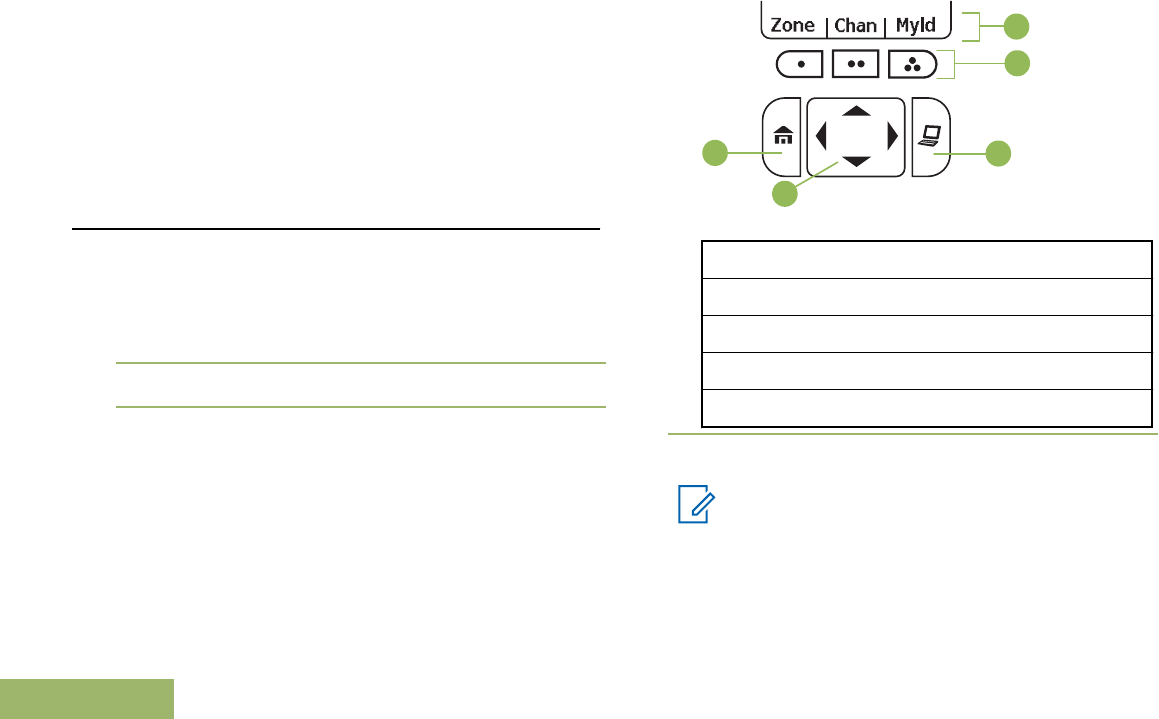
Voice
Announcement
Audibly indicates the current
feature mode, Zone or
Channel the user has just
assigned.
Voice Mute Toggles voice mute on or off.
Volume Set Tone Sets the volume set tone.
Accessing the Preprogrammed Functions
You can access various radio functions through one
of the following methods.
•A short or long press of the relevant
programmable buttons.
•Use the Menu Select Button.
•Use the Menu Select and Navigation buttons.
B
C
D
E
A
A Softkeys
B Menu Select Buttons
C Data Feature Button
D 4–Way Navigation Button
E Home Button
Menu Select Buttons
Note:
Check with your dealer or system
administrator for the list of features activated
in your radio.
Use the Menu Select button to access the menu
entry of your radio feature. Your radio may be
Identifying Radio Controls
34
English

preprogrammed differently from the following
example, but the steps for selecting a channel may
appear as shown below:
Press the Menu Select button directly below Chan.
Home Button
Pressing the button returns you to the Home
(default) screen. In most cases, this is the current
mode. For selected radio features, the button is
also used to save user-edited radio settings or
information before returning you to the Home screen.
Note:
Some features do not require you to press
to go to the Home screen. Refer to the
individual feature sections in this manual for
further details on saving user-edited radio
settings or information.
4-Way Navigation Button
Use the 4-Way Navigation Button to scroll up, down,
left or right with one of the following methods.
• Press and release one of the button to scroll from
one entry to the next one.
• Press and hold one of the button to have the radio
toggles through the list automatically (release the
button to stop).
Data Feature Button
Use Data Feature button to access data-related
features, such as the Text Messaging Service (TMS)
feature screen.
Keypad
You can use the 3 x 4 alphanumeric keypad to
access your radio features. The keypad functions in a
manner similar to a standard telephone keypad when
entering numeric digits. When the keypad is used to
edit a list, each key can generate different characters
of the alphabet. The following tables show the
number of times a key needs to be pressed to
generate the required character.
Identifying Radio Controls
35
English
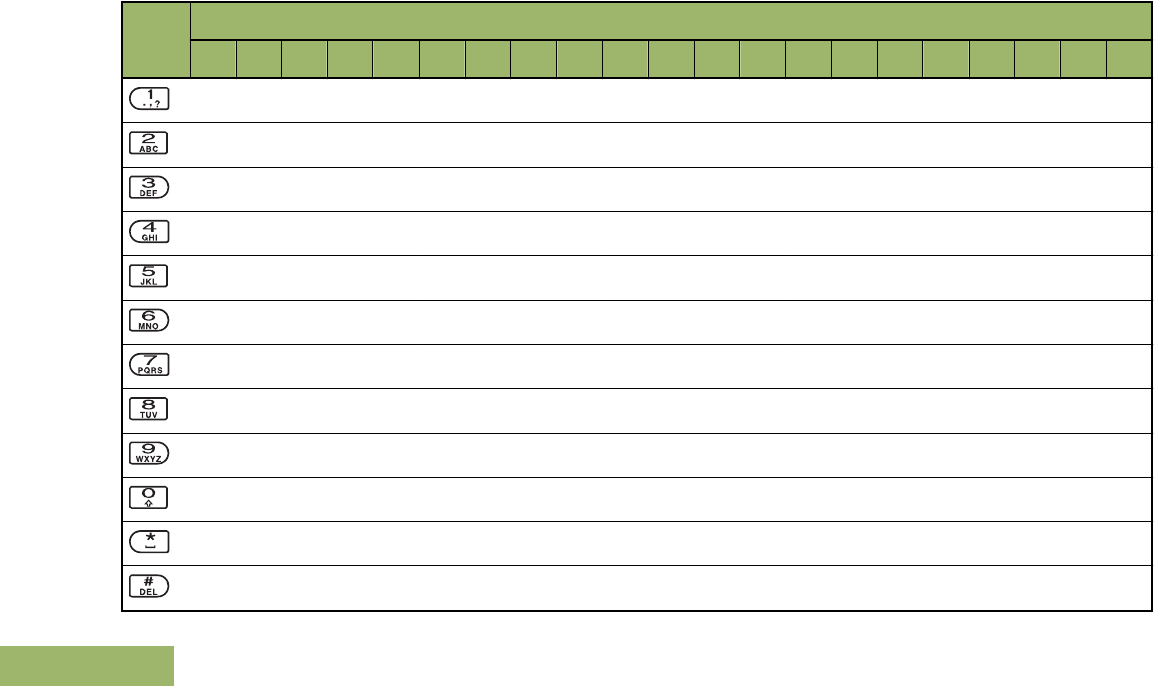
Keypad Characters – Uppercase Mode
Key Number of Times Key is Pressed
1 2 3 4 5 6 7 8 9 10 11 12 13 14 15 16 17 18 19 20 21
1 . , ? ! ; @ _ - * # & $ / + = \ “ ‘ ( )
ABC
D E F
G H I
J K L
M N O
P Q R S
T U V
W X Y Z
Toggle between mixed case mode, uppercase mode and lowercase mode.
Space
Toggle between numeric and letter mode.
Identifying Radio Controls
36
English
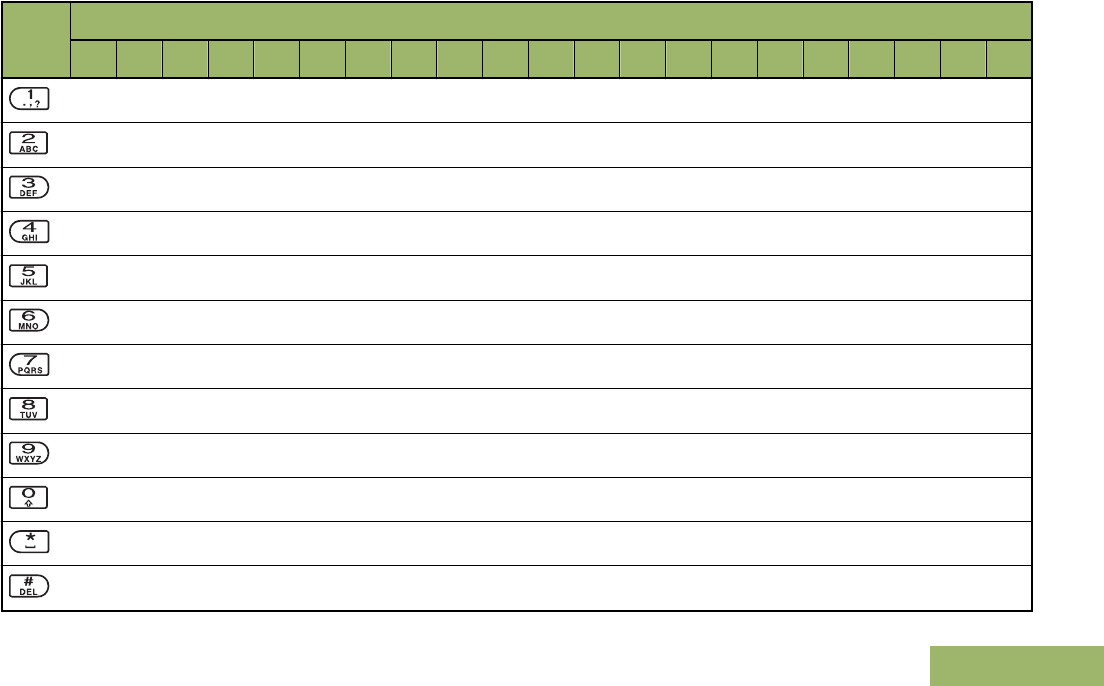
Keypad Characters – Lowercase Mode
Key Number of Times Key is Pressed
1 2 3 4 5 6 7 8 9 10 11 12 13 14 15 16 17 18 19 20 21
1 . , ? ! ; @ _ - * # & $ / + = \ “ ‘ ( )
a b c
d e f
g h i
j k l
m n o
p q r s
t u v
w x y z
Toggle between mixed case mode, uppercase mode and lowercase mode.
Space
Toggle between numeric and letter mode.
Identifying Radio Controls
37
English
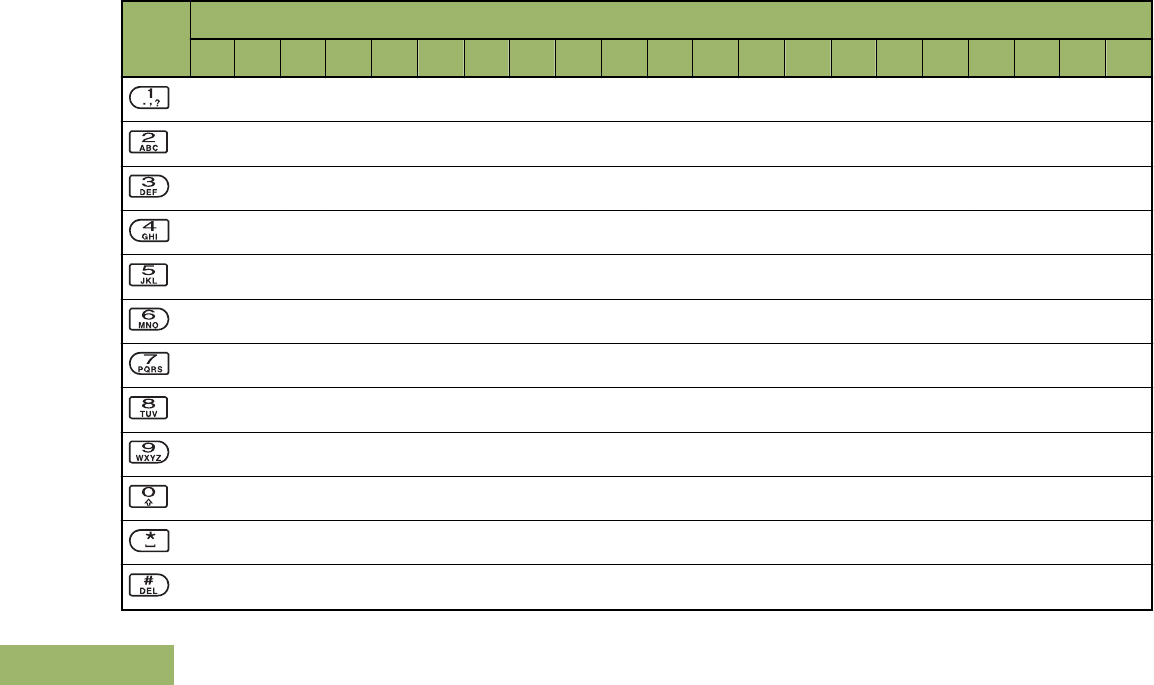
Keypad Characters – Numeric Mode
Key Number of Times Key is Pressed
1 2 3 4 5 6 7 8 9 10 11 12 13 14 15 16 17 18 19 20 21
1 . , ? ! ; @ _ - * # & $ / + = \ “ ‘ ( )
2
3
4
5
6
7
8
9
0
Space
Toggle between numeric and letter mode.
Identifying Radio Controls
38
English
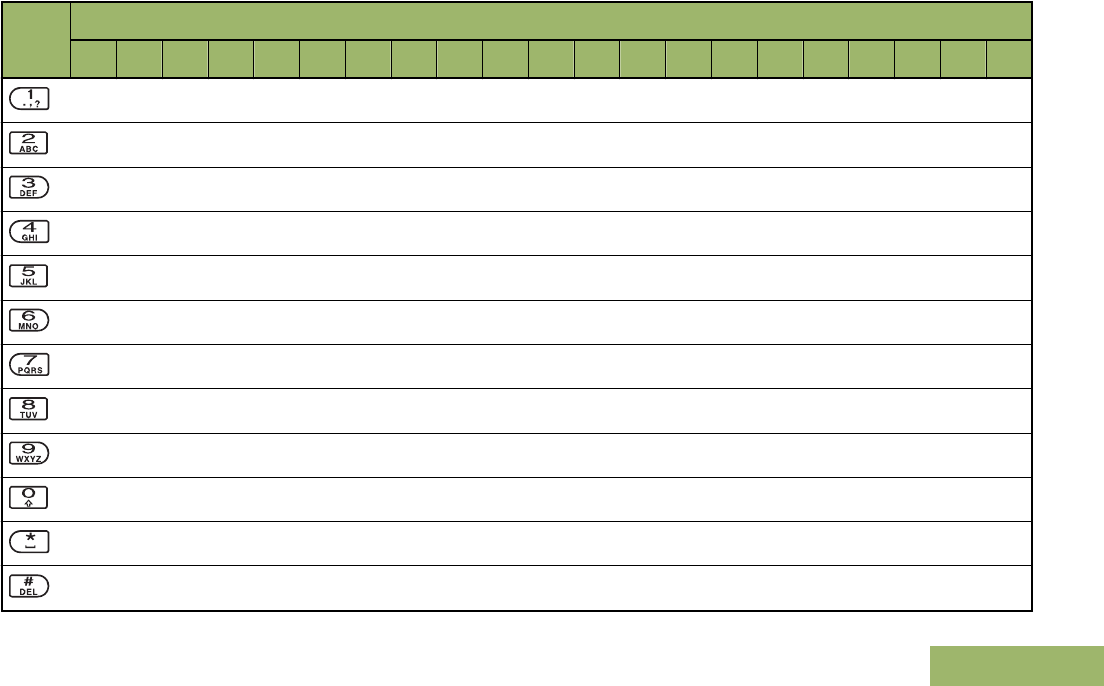
Keypad Characters – Hexadecimal Mode
Key Number of Times Key is Pressed
1 2 3 4 5 6 7 8 9 10 11 12 13 14 15 16 17 18 19 20 21
1
2 A B C
3 D E F
4
5
6
7
8
9
0
Not applicable
Not applicable
Identifying Radio Controls
39
English
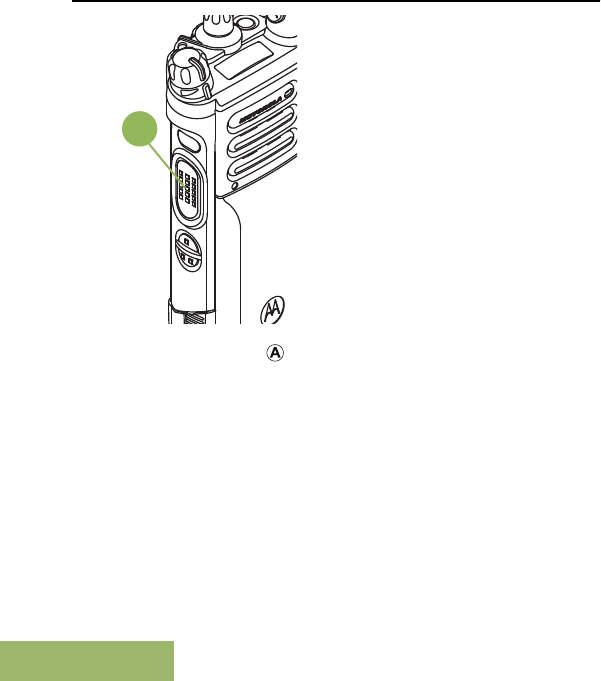
Push-To-Talk (PTT) Button
A
The PTT button on the side of the radio serves two
basic purposes:
• While a call is in progress, the PTT button allows
the radio to transmit to other radios in the call.
Press and hold down PTT button to talk. Release
the PTT button to listen. The microphone is
activated when the PTT button is pressed.
• While a call is not in progress, the PTT button is
used to make a new call. See Methods to Make a
Radio Call on page 61 for more information.
Identifying Radio Controls
40
English
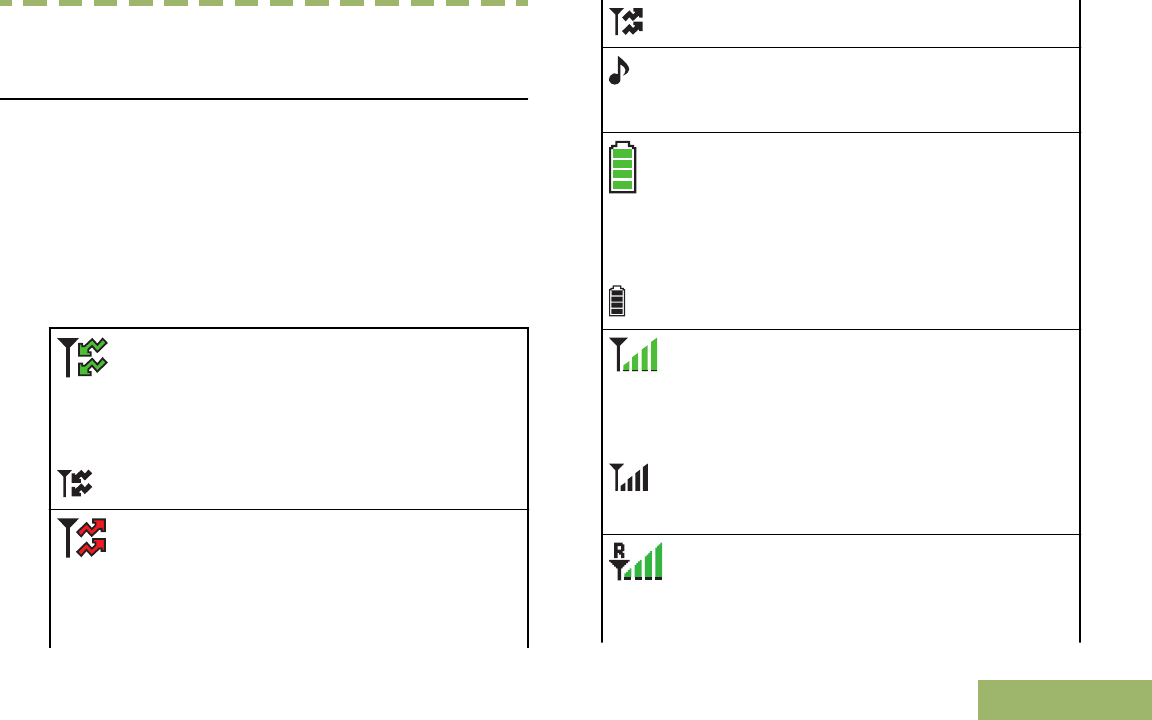
Identifying Status Indicators
Status Icons
The 130 x 130 pixel front liquid crystal display (LCD)
of your radio shows radio status, text entries, and
menu entries. The top two display rows contain color
icons that indicate radio operating conditions.
Selected icons are also shown on the first row of the
112 x 32 pixel top monochrome display screen of
your radio. The following icons are for the front
display screen unless indicated otherwise.
Top Dis-
play:
Receiving
Radio is receiving a call or data.
Top Dis-
play:
Transmitting
Radio is transmitting a call or data.
Call Received
Radio has received an Individual Call.
Top Dis-
play:
Battery
For IMPRES™ battery operation only –
the icon shown indicates the charge re-
maining in the battery.
For all battery operation – the icon blinks
when the battery is low.
Top Dis-
play:
Received Signal Strength Indicator
(RSSI)
The number of bars displayed repre-
sents the received signal strength for the
current site, for trunking only. The more
stripes in the icon, the stronger the sig-
nal.
Roaming
The radio has roamed to and is currently
registered to a foreign system.
Identifying Status Indicators
41
English
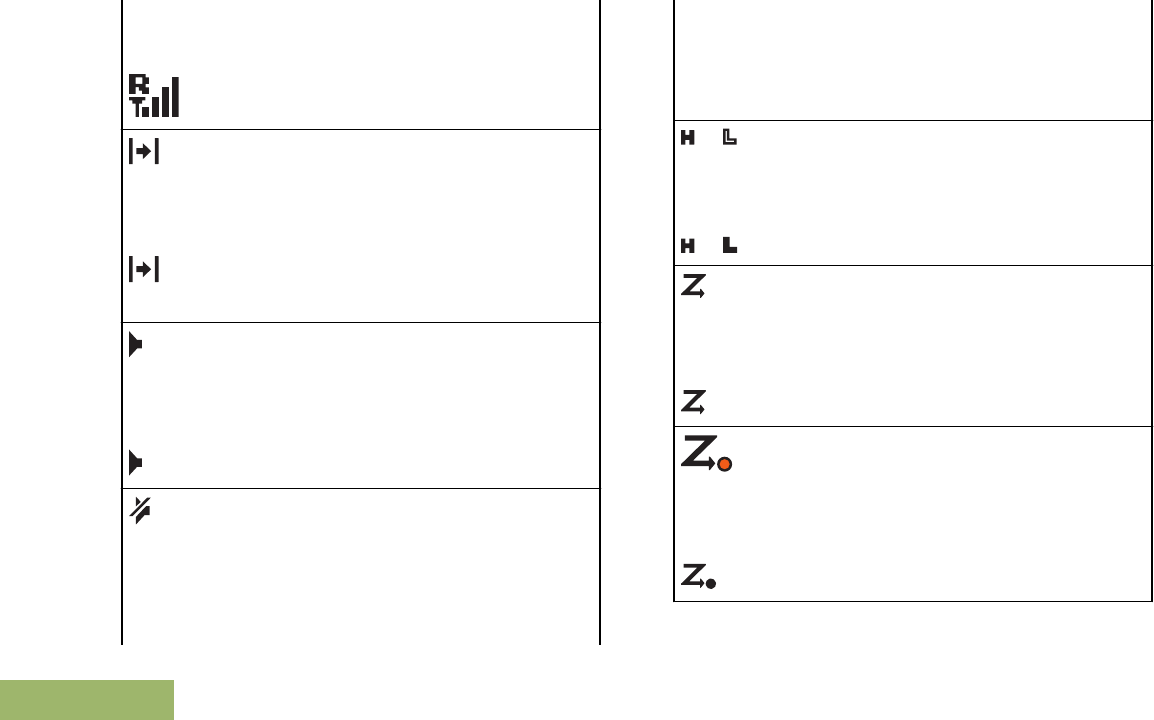
Top Dis-
play:
Top Dis-
play:
Direct
On – Radio is currently configured for di-
rect radio-to-radio communication (dur-
ing conventional operation only).
Off – Radio is connected with other ra-
dios through a repeater.
Top Dis-
play:
Monitor (Carrier Squelch)
Selected channel is being monitored
(during conventional operation only).
In-Call User Alert
On – The feature is enabled. Voice mut-
ing of the affiliated trunking talkgroup or
selected conventional channel is activat-
ed.
Off – The feature is disabled. Voice mut-
ing of the affiliated trunking talkgroup or
selected conventional channel is deacti-
vated.
or
Top Dis-
play:
or
Power Level
L – Radio is set at Low power.
H – Radio is set at High power.
Top Dis-
play:
Scan
Radio is scanning a scan list.
Top Dis-
play:
Priority Channel Scan
Blinking dot – Radio detects activity on
channel designated as Priority-One.
Steady dot – Radio detects activity on
channel designated as Priority-Two.
Identifying Status Indicators
42
English
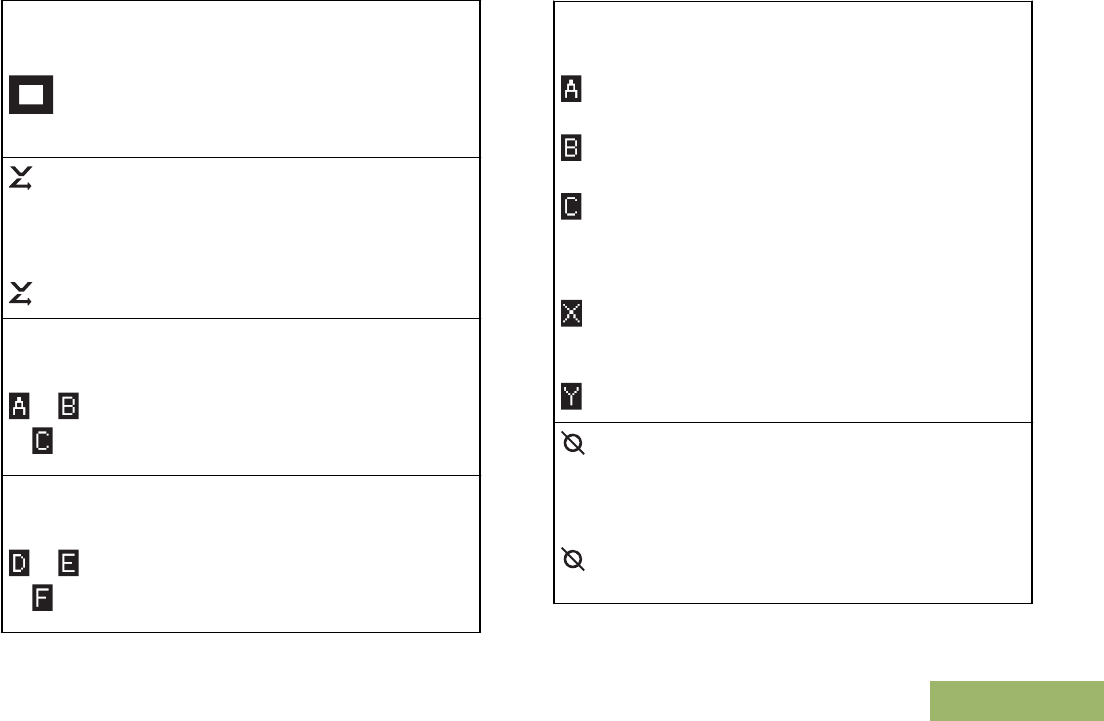
Top Dis-
play:
View/Program Mode
Radio is in the view or program mode.
On steady – View mode
Blinking – Program mode
Top Dis-
play:
Vote Scan Enabled
The vote scan feature is enabled.
Top Dis-
play:
or
or
Basic Zone Bank 1
A – Radio is in Zone 1.
B – Radio is in Zone 2.
C – Radio is in Zone 3.
Top Dis-
play:
or
or
Basic Zone Bank 2
D – Radio is in Zone 4.
E – Radio is in Zone 5.
F – Radio is in Zone 6.
Top Dis-
play:
,
,
until
or
Enhanced Zone Bank
A – Contains Zone 1, Zone 2 and Zone
3,
B – Contains Zone 4, Zone 5 and Zone
6,
C – Contains Zone 7, Zone 8 and Zone
9,
until
X – Contains Zone 70, Zone 71 and
Zone 72,
Y – Contains Zone 73, Zone 74 and
Zone 75.
Top Dis-
play:
Secure Operation
On – Secure operation.
Off – Clear operation.
Blinking – Receiving an encrypted
voice call.
Identifying Status Indicators
43
English
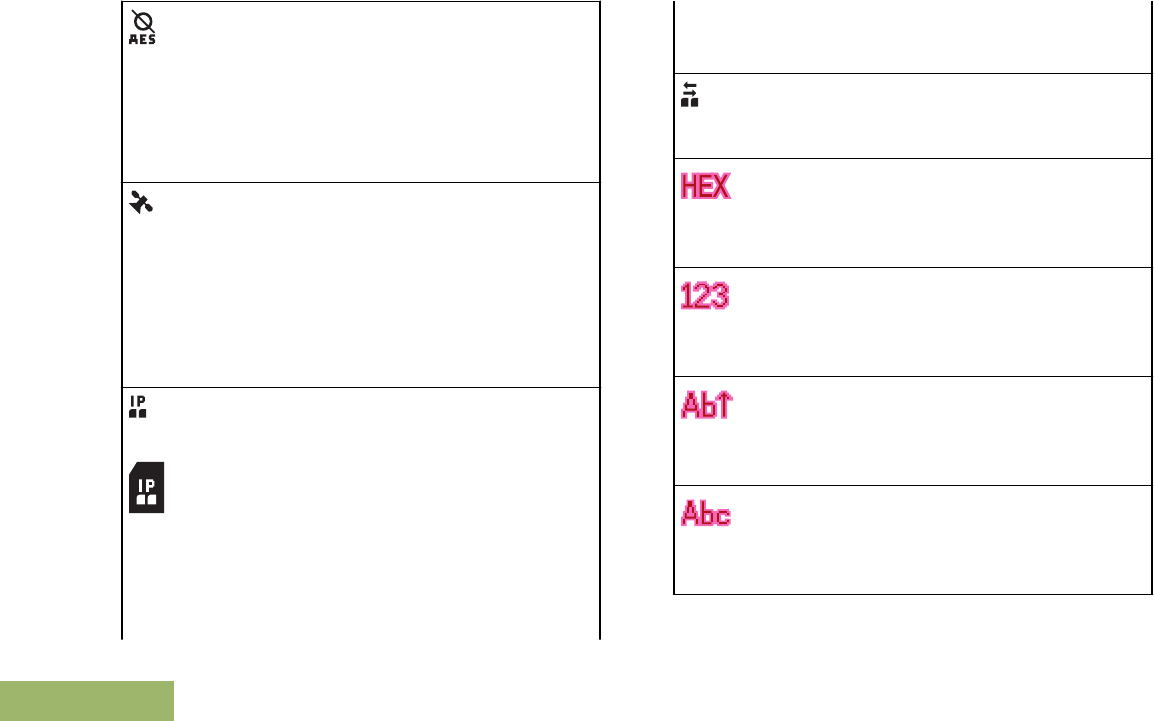
AES Secure Operation
On – AES secure operation.
Off – Clear operation.
Blinking – Receiving an encrypted
voice call.
GPS Signal
On – Feature is enabled and signal is
available.
Off – Feature is disabled.
Blinking – Feature is enabled, but no
signal is available.
User Login Indicator (IP Packet Data)
On – User is currently associated with
the radio.
Off – User is currently not associated
with the radio.
Blinking – Device registration or user
registration with the server failed due to
an invalid username or pin.
Inverted – User successfully login to the
secured IP Packet Data.
Data Activity
Data activity is present.
Hexadecimal
Indicates that the text entry is currently
in hexadecimal mode.
Numeric
Indicates that the text entry is currently
in numeric mode.
Start Case
Indicates that the first character of the
text entry is capitalized.
Mixed Case
Indicates that the text entry is currently
in normal text mode.
Identifying Status Indicators
44
English
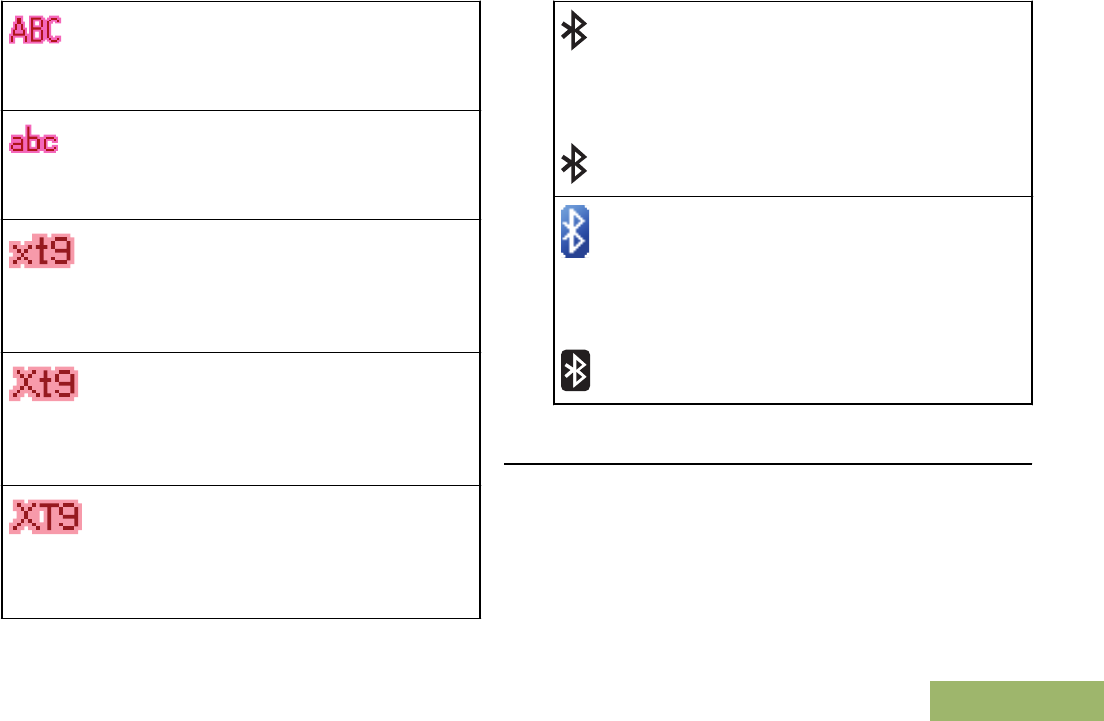
Uppercase
Indicates that the text entry is currently
in uppercase mode.
Lowercase
Indicates that the text entry is currently
in lowercase mode.
Lowercase Predictive
Indicates that the text entry is currently
in lowercase and with predicted words
shown at the bottom of the screen.
Mixedcase Predictive
Indicates that the text entry is currently
in mixed case and with predicted words
shown at the bottom of the screen.
Uppercase Predictive
Indicates that the text entry is currently
in uppercase and with predicted words
shown at the bottom of the screen.
Top Dis-
play:
Bluetooth On
Bluetooth is on and ready for Bluetooth
connection.
Top Dis-
play:
Bluetooth Connected
Bluetooth is currently connected to the
external Bluetooth device.
Text Messaging Service (TMS) Indicators
This feature allows you to send and receive text
messages. Status icons and menu options shown
here help you to work more efficiently with TMS
feature. See Text Messaging Service (TMS) on page
97 for more information.
Identifying Status Indicators
45
English
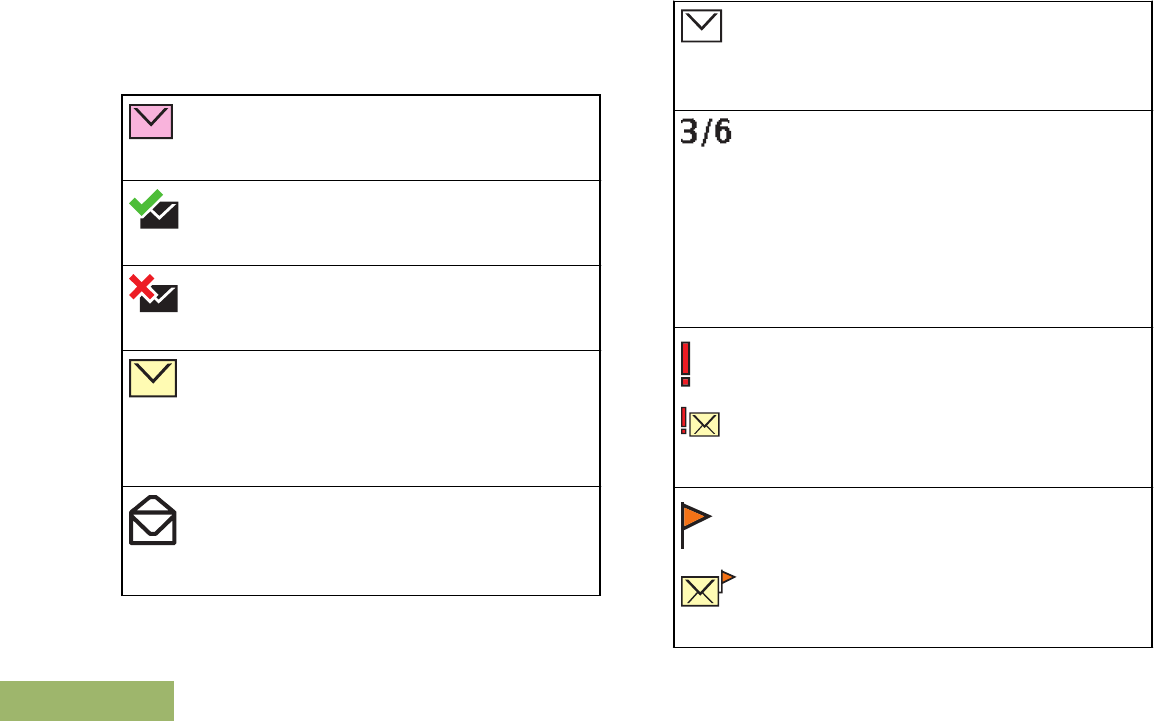
TMS Status Icons
The following icons appear on the radio’s display
when you send and receive text messages.
Inbox Full
The Inbox is full.
Message Sent
The text message is sent successfully.
Message Unsent
The text message cannot be sent.
Unread Message
• User receives a new message.
• The selected text message in the Inbox
has not been read.
Read Message
The selected text message in the Inbox
has been read.
Normal Message
User is composing a message with normal
priority and without a request for a reply.
Message Index
Indicates the index of the current message
the user is viewing.
Example: If the user is looking at the third
message out of a total of 6 messages in
the Inbox folder, the icon is displayed as
the icon on the left column.
Priority Status
• The “Priority” feature is toggled on be-
fore the message is sent.
• Messages in the Inbox folder are flag-
ged with “Priority”.
Request Reply
• The “Request Reply” feature is toggled
on before the message is sent.
• Messages in the Inbox folder are flag-
ged with “Request Reply”.
Identifying Status Indicators
46
English
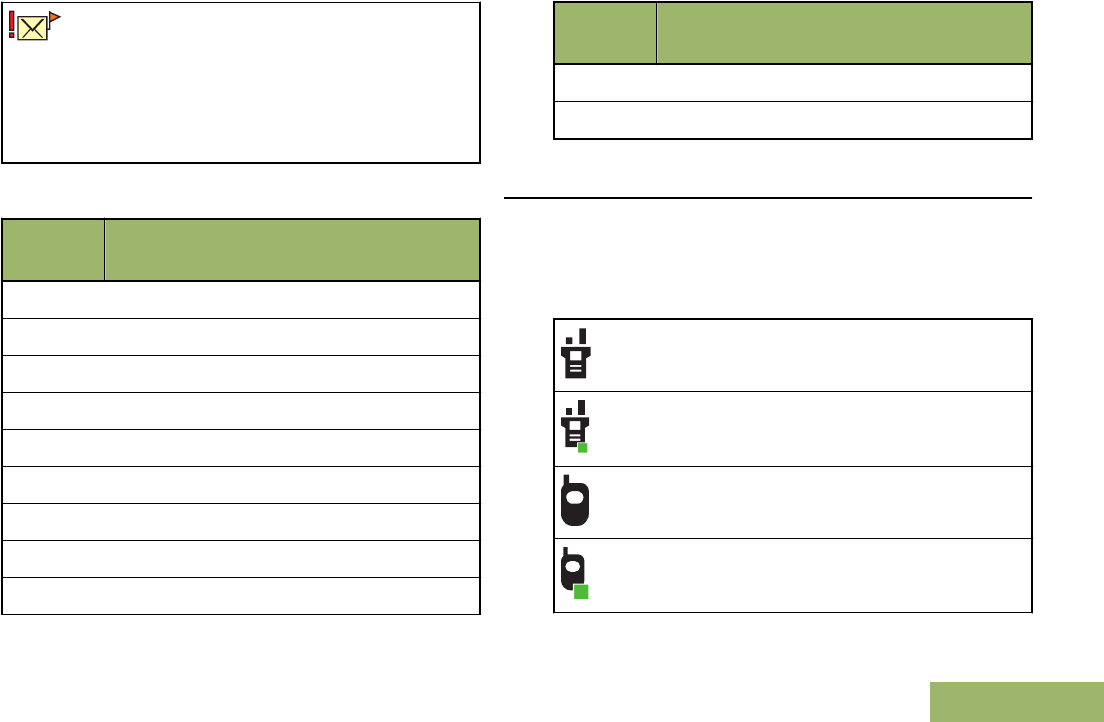
Priority Status and Request Reply
• User is composing a message with a
priority status and a request for a reply.
• Messages in the Inbox folder are flag-
ged with “Priority” and “Request Reply”.
TMS Menu Options
Menu
Option
Description/Function
Back Brings you back to the previous screen.
Clr Deletes all messages.
Del Deletes a message or text.
Edit Brings you to the edit screen.
Exit Exits to the Home screen.
No Returns to the previous screen.
Optn Brings you to the Options main screen.
Rply Replies to a message.
Sel Selects the highlighted command.
Menu
Option
Description/Function
Send Sends the message.
Yes Updates or saves a command.
Call Type Icons
The following icons appear on the radio’s main
display, when you make or receive a call, or view
selected call lists, to indicate the different call types
associated with an alias or ID.
Radio number.
Radio number added to a Call List.
Mobile number.
Mobile number added to a Call List.
Identifying Status Indicators
47
English
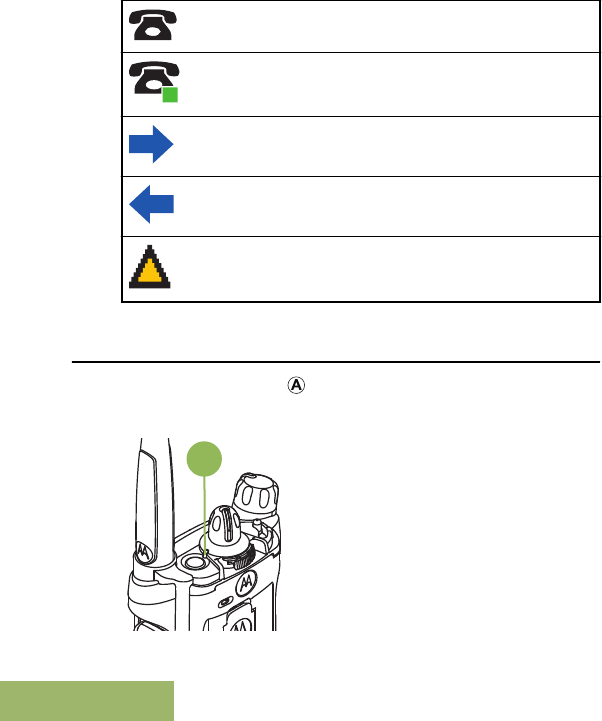
Landline phone number.
Landline phone number added to a Call
List.
Incoming call or data.
Outgoing call or data.
Incoming emergency call.
LED Indicator
The LED indicator shows the operational status of
your radio.
A
Solid red Radio is transmitting.
Blinking red Radio is transmitting at low
battery condition.
Double blinking
red
Radio is in Emergency Mode.
Rapidly blinking
red
Radio has failed the self test
upon powering up or
encountered a fatal error.
Solid yellow
(Conventional
Only)
Channel is busy.
Blinking yellow Radio is receiving a secured
transmission.
Solid green Radio is powering up, or is on
a non-priority channel while in
the Scan List Programming
mode.
Blinking green Radio is receiving an individual
or telephone call, or is on a
Priority-Two channel while in
the Scan List Programming
mode.
Identifying Status Indicators
48
English
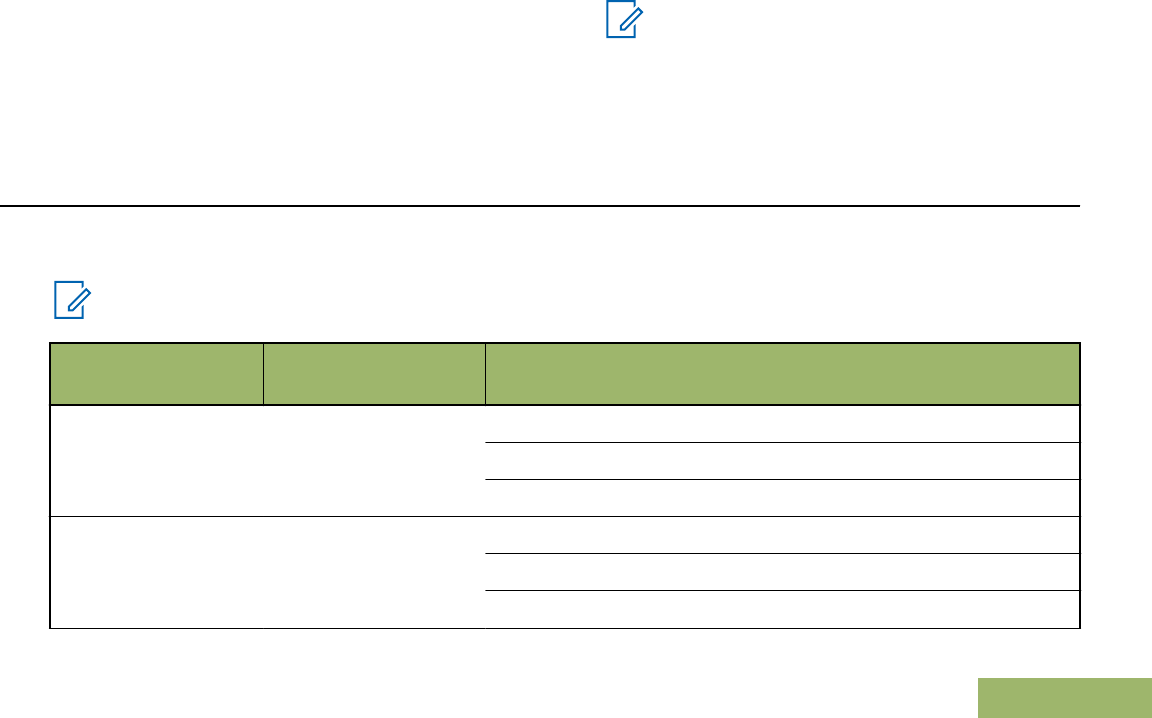
Rapidly blinking
green
Radio is on a Priority-One
channel while in the Scan List
Programming mode.
Note:
No LED indication when the radio receives a
clear (non-secured) transmission in trunking
Mode. LED indication can be preprogramed by
qualified technician to be permanently
disabled. Consult your dealer for further
details if you want to disable it.
Intelligent Lighting Indicators
This feature temporarily changes the backlight of the top display screen, and adds a color bar to the main display
screen to help signal that a radio event has occurred.
Note:
This feature must be preprogrammed by a qualified radio technician.
Backlight and Bar
Color
Notification When
Orange Emergency Alerts The radio initiates an emergency alarm or call.
The radio receives an emergency alarm or call.
The radio initiates the Man Down Post-Alert timer.
Red Critical Alerts The radio battery is low.
The radio is out of range.
The radio enters Failsoft mode.
Identifying Status Indicators
49
English
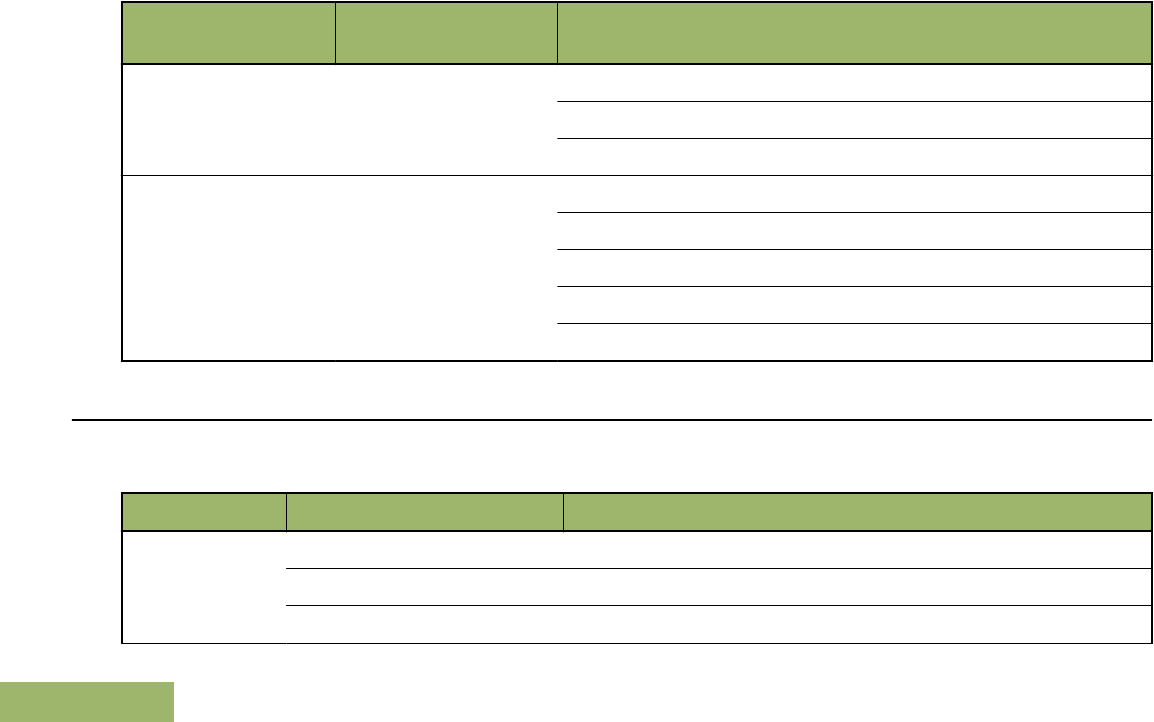
Backlight and Bar
Color
Notification When
The radio is unable to establish a full connection with the system.
The radio is unable to authenticate or register with the system.
The radio lost GPS signal or GPS function fails.
Green Call Alerts The radio receives a private call.
The radio receives a phone call.
The radio receives a call alert.
The radio receives a selective call.
The radio enters Geofence.
Alert Tones
Your radio uses alert tones to inform you of the condition of your radio. The following table lists these tones and
when they occur.
You Hear Tone Name Heard
Short, Low-
Pitched Tone
Radio Self Test Fail When radio fails its power-up self test.
Reject When an unauthorized request is made.
Time-Out Timer Warning Four seconds before time out.
Identifying Status Indicators
50
English
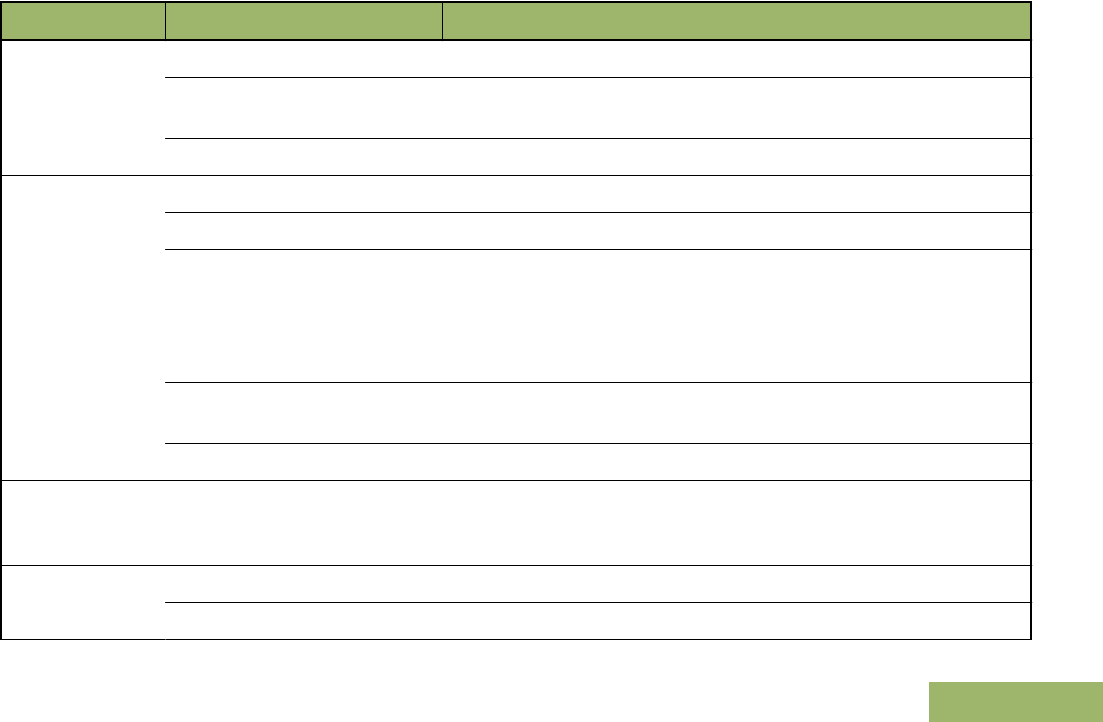
You Hear Tone Name Heard
No ACK Received When radio fails to receive an acknowledgment.
Individual Call Warning
Tone
When radio is in an individual call for greater than 6 seconds
without any activity.
Man Down Entry When radio initiates Man Down mode.
Long, Low-
Pitched Tone
Time-Out Timer Timed Out After time out.
Talk Prohibit/PTT Inhibit (When PTT button is pressed) transmissions are not allowed.
Lack of Voice PTT Time out When the radio ends your call after it detected there is lack of
voice for 60 seconds after the PTT is pressed and hold. Your ra-
dio ends the call to enable your radio to receive calls from other
radio users. The duration of this timer can be preprogrammed by
a qualified radio technician.
Out of Range (When PTT button is pressed) the radio is out of range of the
system.
Invalid Mode When radio is on an unpreprogrammed channel.
A Group of
Low-Pitched
Tones
Busy When system is busy.
Short, Medium-
Pitched Tone
Valid Key-Press When a correct key is pressed.
Radio Self Test Pass When radio passes its power-up self test.
Identifying Status Indicators
51
English
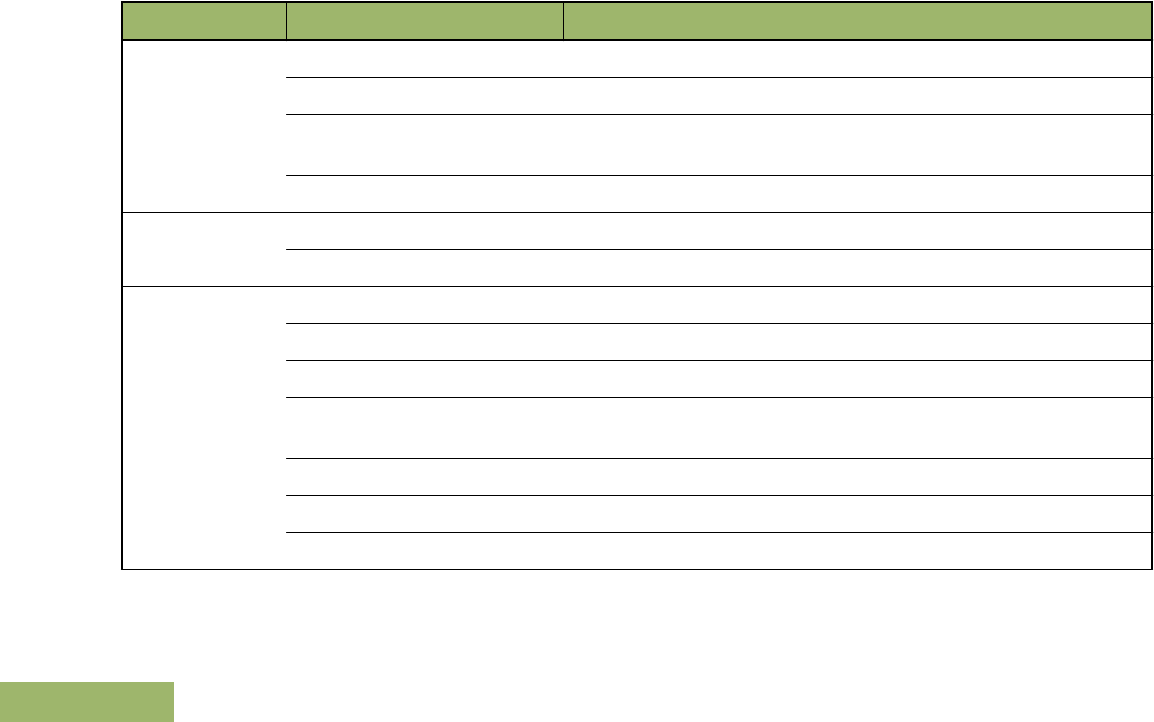
You Hear Tone Name Heard
Clear Voice At beginning of a non-coded communication.
Priority Channel Received When activity on a priority channel is received.
Emergency Alarm /Call En-
try
When entering the emergency state.
Central Echo When central controller has received a request from a radio.
Long, Medium-
Pitched Tone
Volume Set When volume is changed on a quiet channel.
Emergency Exit When exiting the emergency state.
A Group of Me-
dium-Pitched
Tones
Failsoft When the trunking system fails.
Automatic Call Back When voice channel is available from previous request.
Keyfail When encryption key has been lost.
Console Acknowledge When status, emergency alarm, or reprogram request ACK is re-
ceived.
Received Individual Call When Call Alert or Private Call is received.
Call Alert Sent When Call Alert is received by the target radio.
Site Trunking When a SmartZone trunking system fails.
Identifying Status Indicators
52
English
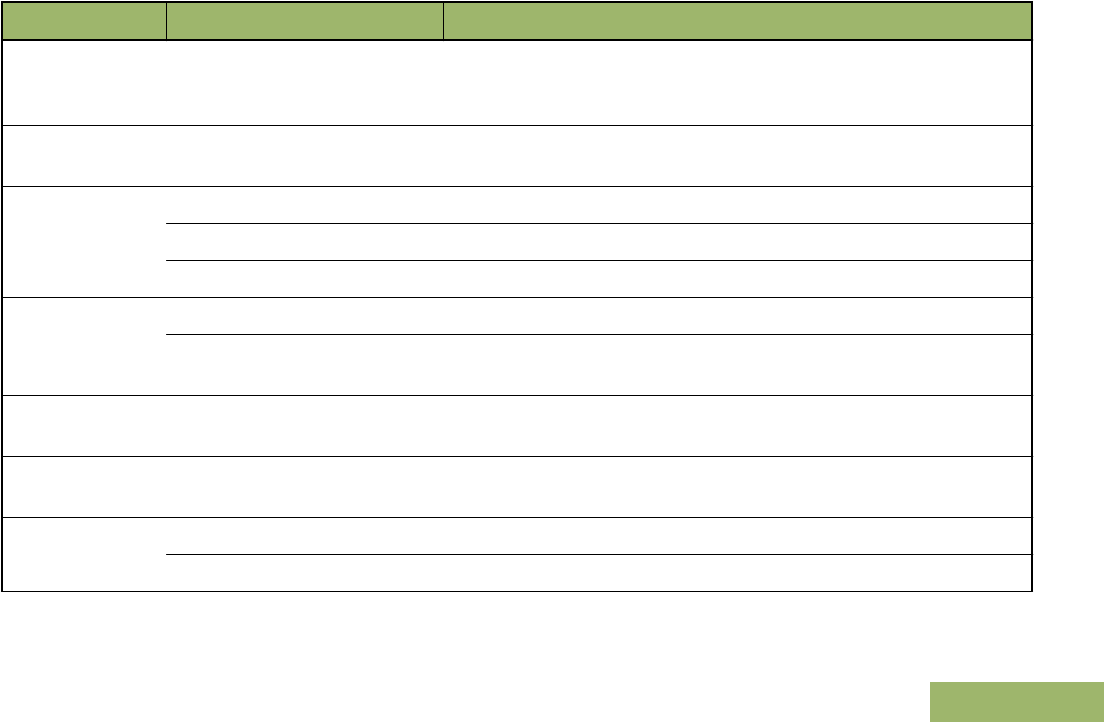
You Hear Tone Name Heard
Short, High-
Pitched Tone
(Chirp)
Low-Battery Chirp When battery is below preset threshold value.
Two High-
Pitched Tones
GPS Fails When the GPS signal is lost or when GPS fails.
Ringing Fast Ringing When system is searching for target of Private Call.
Enhanced Call Sent When waiting for target of Private Call to answer the call.
Phone Call Received When a land-to-mobile phone call is received.
Gurgle Dynamic Regrouping (When PTT button is pressed) a dynamic ID has been received.
Talk Permit (When PTT button is pressed) is verifying with the system for ac-
cepting its transmissions.
Unique, Low-
Pitched Chirp
New Message When a new message is received.
Unique, High-
Pitched Chirp
Priority Status When a priority message is received.
Incremental-
Pitched Tone
Bluetooth Paired When Bluetooth accessory is paired with the radio.
Bluetooth Connected When Bluetooth accessory is connected to the radio.
Identifying Status Indicators
53
English
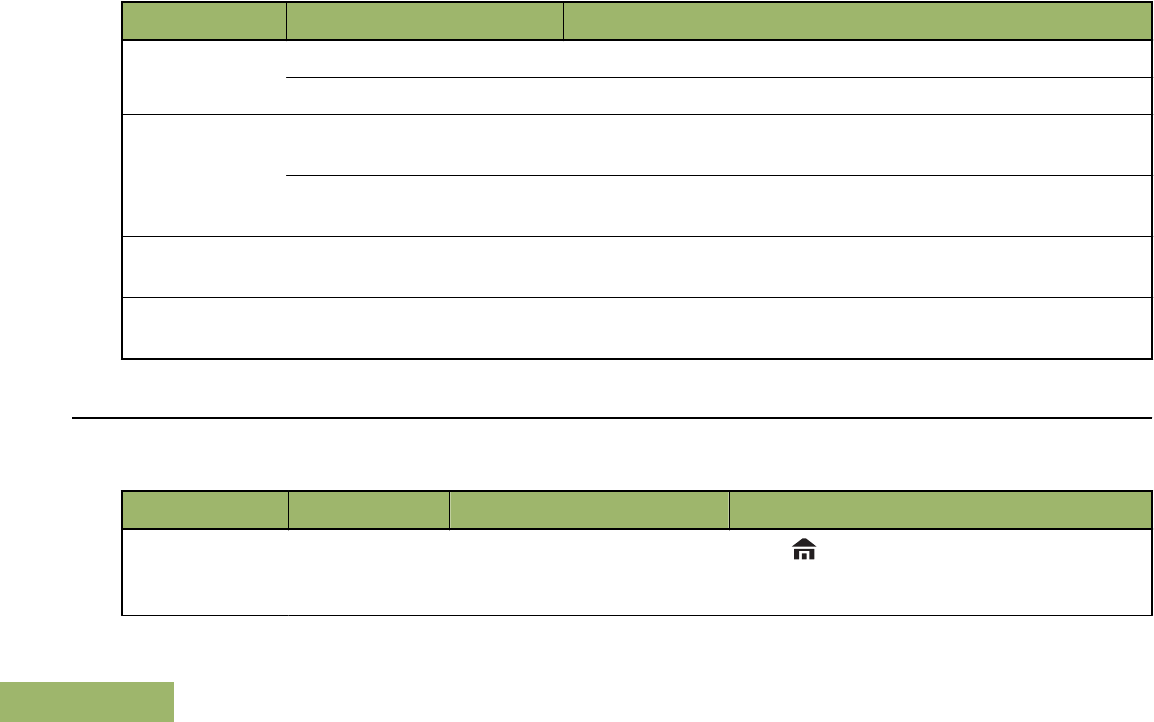
You Hear Tone Name Heard
Decremental-
Pitched Tone
Bluetooth Unpaired When Bluetooth accessory is unpaired from the radio.
Bluetooth Disconnected When Bluetooth accessory is disconnected from the radio.
A Group of
Very High-
Pitched Tones
Man Down Continuous
Tone
When radio is in Man Down mode and prepares to transmit
Emergency Alarm when the timer of this alarm ends.
Critical Man Down Continu-
ous Tone
When radio is in Man Down Enhanced mode and prepares to
transmit Emergency Alarm when the timer of this alarm ends.
Unique Low-
High Tone
Enhanced Zone Bank Up When EZB Up button is pressed to scroll the Enhance Zone
Bank up.
Unique High-
Low Tone
Enhanced Zone Bank Down When EZB Down button is pressed to scroll the Enhance Zone
Bank down.
Phone Call Displays and Alerts
The following phone call displays and alerts appears on the radio’s display when you make and receive Phone calls.
The radio also uses alert tones to indicate the current status.
You Hear You See When Notes
A Long Tone No phone You press the PTT button
and the phone system is
not available.
Press to hang up. The radio returns to the
Home screen.
Identifying Status Indicators
54
English
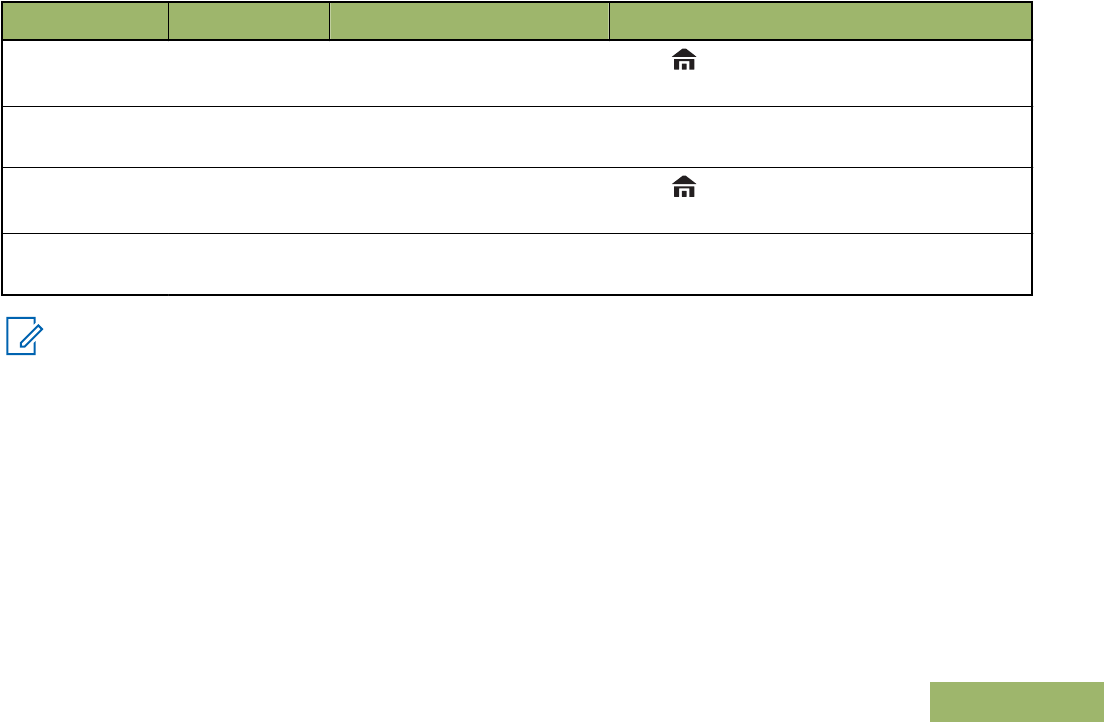
You Hear You See When Notes
Phone busy The phone system is busy. Press to exit the phone mode and try your
call later.
A Busy Tone Phone busy When a channel is not
available.
The radio automatically connects when a
channel opens.
– No acknowl-
edge
The call is not acknowl-
edged. Press to hang up. The radio returns to the
Home screen.
A High- Pitched
Tone
– When you release the PTT
button.
The radio indicates to the landline party that
he or she may begin talking.
Note:
You have the option of sending additional digits (overdial), such as an extension number, or credit card or
PIN numbers, to the phone system. If the radio is preprogrammed for live overdial, every digit entered after
the call is connected is sent to the phone system.
If the radio is preprogrammed for buffered overdial, the digits pressed are entered into memory and then sent
when the PTT button is pressed. Press the PTT button to send either digits or voice, but not both at the same
time.
Identifying Status Indicators
55
English

General Radio Operation
Selecting a Zone
Your radio must be preprogrammed to allow you to
use this feature.
A zone is a group of channels. The following methods
are options on how to select a radio zone. The result
of all the methods is the same. You can use the
options interchangeably depending on your
preference and the programmed functions.
•Select a zone via the preprogrammed Zone (3-
Position A/B/C) switch:
a) Move the preprogrammed Zone (3-Position
A/B/C) switch to the position of the required
zone.
If the zone number entered is unprogrammed,
the display shows Invalid entry. Repeat this
step.
b) Press the PTT button to transmit on the
displayed zone channel.
•Select a zone via the radio menu Zone:
a) or to Zone and press the Menu Select
button directly below Zone.
b) or to the required zone, or use the
keypad to enter the zone number.
If the zone number entered is unprogrammed,
the display shows Invalid entry. Repeat this
step.
c) Press the Menu Select button directly below
Sel to confirm the displayed zone.
d) Press the PTT button to transmit on the
displayed zone channel.
•Select a zone via the radio menu ZnUp or ZnDn:
a) or to ZnUp or ZnDn.
b) Press and hold the Menu Select button directly
below ZnUp or ZnDn until the required zone
appears.
Positions of ZnUp and ZnDn on the display may
differ each time you release the Menu Select
button. Read carefully before you press.
c) Press the PTT button to transmit on the
displayed zone channel.
Selecting a Radio Channel
General Radio Operation
56
English

A channel is a group of radio characteristics, such as
transmit/ receive frequency pairs. The following
methods are options on how to select a radio
channel. The result of all the methods is the same.
You can use the options interchangeably depending
on your preference and the programmed functions.
•Select a channel via the preprogrammed 16–
Position Select Knob to the desired channel.
a) Rotate the preprogrammed 16–Position
Select Knob to the desired channel.
b) Press the PTT button to transmit on the
displayed zone channel.
•Select a channel via the radio menu Chan:
a) or to Chan.
b) Press the Menu Select button directly below
Chan.
c) or to the required channel or use the
keypad to enter the channel number.
If the channel number entered is
unprogrammed, the display shows Invalid
entry. Repeat this step.
d) Press the Menu Select button directly below
Sel to confirm the selected channel.
e) Press the PTT button to transmit on the
displayed zone channel.
•Select a channel via the radio menu Channel Up
or Channel Down:
a) or to ChUp or ChDn.
b) Press the Menu Select button directly below
ChUp or ChDn.
Positions of ChUp and ChDn on the display may
differ each time you release the Menu Select
button. Read carefully before you press.
c) Press the PTT button to transmit on the
displayed zone and channel.
Selecting a Channel via Channel Search
Button
This feature allows you to do a quick search for a
specific channel in your radio by keying in the alias of
the channel. If the name matches, your radio prompts
the first found matched channel name.
1Perform one of the following actions:
• Press the preprogrammed Channel Search
button.
General Radio Operation
57
English

• or to CSrh and press the Menu Select
button directly below CSrh.
A blinking cursor appears on the Channel Search
screen.
2Use the keypad to type or edit your channel
name.
3To initiate searching, press the Menu Select
button directly below CSrh once the entry is done.
To exit this procedure, press the Menu Select
button directly below Cncl.
The display shows Searching. Once found, the
display shows the matched channel name and the
radio changed its transmission to the selected
channel.
If the radio is triggered to search for an empty entry,
the display shows Invalid entry. Repeat step 2 to
search again.
If the entry does not match, the display shows
Channel name not found. Repeat step 2 to search
again; or press or the Menu Select button directly
below Exit to exit.
Mode Select Feature
Mode Select allows a long press to save the current
zone and channel of your radio to a programmable
button, keypad button, or a softkey; then once
programmed, the short-press of that button or softkey
changes the transmission to the saved zone and
channel.
There are two methods to save the selected zone and
channel:
• Softkeys
• Programmable buttons and keypad buttons (digit 0
to 9)
Note:
Your radio must be preprogrammed to allow
you to use this feature.
Saving a Zone and a Channel to a Softkey
Five softkeys are available for you to save the
frequently used zone and channel.
1Toggle your zone and channel to the required
zone and channel.
General Radio Operation
58
English
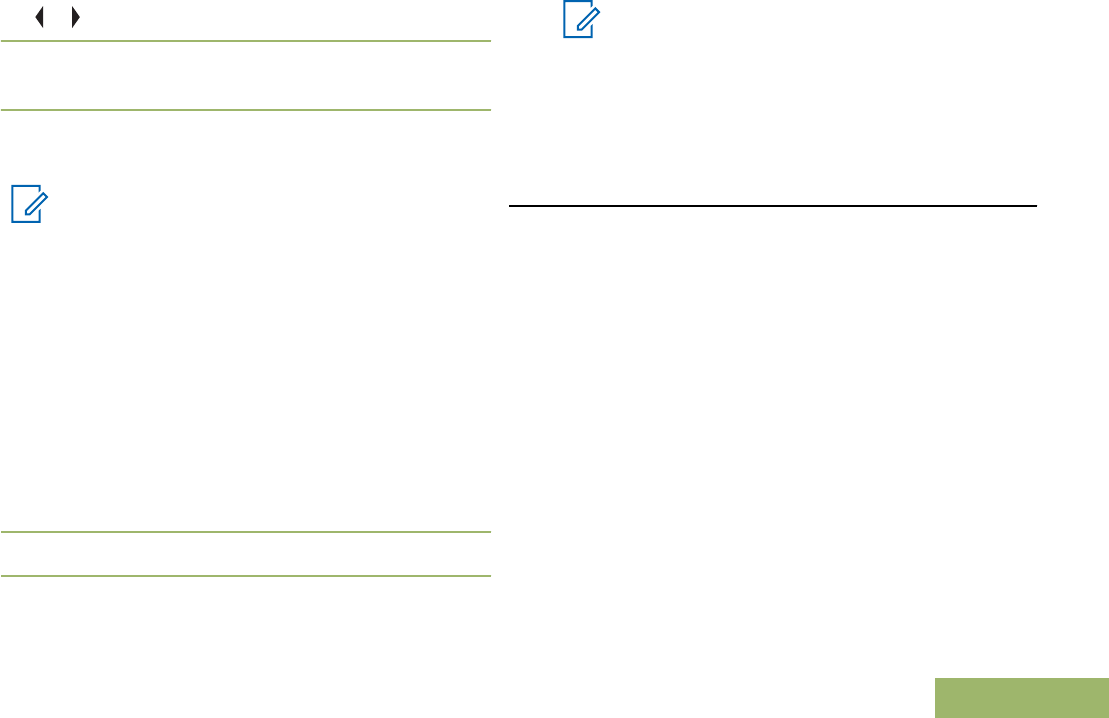
2 or to MS1, MS2 ... or MS5.
3Press and hold the Menu Select button directly
below one of the softkey (MS1 – MS5).
You hear a short, medium-pitched tone when the
zone and channel is saved.
Note:
To change the programmed zone and
channel, repeat this procedure.
Short press of the programmed softkey
changes your current transmission to the zone
and channel programmed in this softkey.
Saving a Zone and a Channel to a Button
You can save the frequent used zone and channel to
the programmable buttons and keypad digit 0 to 9
buttons.
1Toggle your zone and channel to the required
zone and channel.
2Press and hold the button you desire to program.
You hear a short, medium-pitched tone when the
zone and channel is saved.
Note:
Repeat this procedure to change the zone and
channel of the programmed button.
Short press of the programmed button
changes your current transmission to the zone
and channel programmed in this button.
Receiving and Responding to a Radio Call
Once you have selected the required channel and/or
zone, you can proceed to receive and respond to
calls.
The LED lights up solid red while the radio is
transmitting. In conventional mode, the LED lights up
solid yellow when the radio is receiving a
transmission. In trunking mode, there is no LED
indication when the radio receives a transmission.
If the radio is receiving a secure transmission, the
LED blinks yellow.
Receiving and Responding to a Talkgroup Call
To receive a call from a group of users, your radio
must be configured as part of that talkgroup.
When you receive a talkgroup call (while on the
Home screen) the radio triggers for your attention with
General Radio Operation
59
English

one of the following scenarios depending on the
system your radio is configured:
• For ASTRO Conventional system, the LED lights
up solid yellow. The display shows the talkgroup
alias or ID, and the caller alias or ID.
• For Trunking system, the display shows the caller
alias or ID.
1Hold the radio vertically 1 to 2 inches (2.5 to 5.0
cm) from your mouth.
2Press the PTT button to respond to the call.
The LED lights up solid red.
3Release the PTT button to listen.
See also Making a Talkgroup Call on page 62 for
details on making a Talkgroup Call.
Receiving and Responding to a Private Call (Trunking
Only)
A Private Call is a call from an individual radio to
another individual radio.
The one-to-one call between the two radios are not
heard by the others in the current talkgroup. The
calling radio automatically verifies that the receiving
radio is active on the system and can display the
caller ID.
Note:
With the inactivity timer enabled (optional),
when there is no response from the receiving
radio, the calling radio exits the call with Menu
Inactive Exit tone after the timer expires.
When you receive a Private Call, you hear two alert
tones and the LED blinks green. The display shows
Call received and the call received icon blinks.
1Perform one of the following actions:
• Press the Menu Select button directly below
Resp.
• Press the Call Response button within 20
seconds after the call indicators begin.
If the caller alias is in the call list, the display
shows the caller alias during the call.
If the caller name is not in the call list, the display
shows the caller ID.
2Press and hold the PTT button to talk. Release the
PTT button to listen.
General Radio Operation
60
English

3Press or the Call Response button to hang up
and return to the Home screen.
See also Making a Private Call (Trunking Only) on
page 62 for details on making a Private Call.
Receiving and Responding to a Telephone Call
(Trunking Only)
This feature allows you to receive calls similar to
standard phone calls from a landline phone.
Note:
With the inactivity timer enabled (optional), if
there is no response to the call after the timer
expires, your radio exits the call with Menu
Inactive Exit tone.
When you receive a Telephone Call, you hear a
telephone-type ringing and the LED blinks green. The
backlight of the screen and the bar turns green.The
display shows Phone Call and the call received icon
blinks.
1Press the Call Response button within 20
seconds after the call indicators begin.
2Press and hold the PTT button to talk. Release the
PTT button to listen.
3Press or the Call Response button to hang up
and return to the Home screen.
See also Making a Telephone Call (Trunking Only) on
page 64 for details on making a Telephone Call.
Methods to Make a Radio Call
You can select a zone, channel, subscriber ID, or
talkgroup by using:
• The preprogrammed Zone switch.
• The 16-Position Select Channel Knob.
• A preprogrammed One Touch Call button.
• The Contacts list (see Viewing Details of a Contact
on page 79).
Note:
The radio automatically exits the feature, if the
feature inactivity timer is enabled, when the
radio is left idle and the timer expires. You will
hear the Menu Inactive Exit Tone upon feature
exit.
General Radio Operation
61
English

Making a Talkgroup Call
To make a call to a group of users, your radio must
be configured as part of that talkgroup.
1Turn the 16-Position Select Channel Knob to
select the channel with the desired talkgroup.
2Hold the radio vertically 1 to 2 inches (2.5 to 5.0
cm) from your mouth.
3Press the PTT button to make the call.
The radio shows different indicators based on the
system the radio is configured.
• For ASTRO Conventional system, the LED
lights up solid red. The display shows the
talkgroup alias or ID.
• For Trunking system, the LED lights up solid
red.
4Speak clearly into the microphone.
5Release the PTT button to listen.
Making a Private Call (Trunking Only)
Your radio must be preprogrammed to allow you to
use this feature.
This feature allows you to send an individual Call
Alert or page if there is no answer from the target
radio.
1Perform one of the following actions:
• To access this feature via a preprogrammed
button, press the preprogrammed Quick
Access (One-Touch) Private Call button to
dial the preprogrammed ID (number) and
initiate the Private Call. Proceed to step 5.
• To access this feature via the menu, proceed
to the next step.
2 or to Call, and press the Menu Select button
directly below Call.
The display shows the last transmitted or received
ID.
3To select the required ID, perform one of the
following actions:
• Press the Menu Select button directly below
Cnts to scroll through and select the required
ID.
• Press the Menu Select button directly below
LNum to go to the last number dialed.
General Radio Operation
62
English
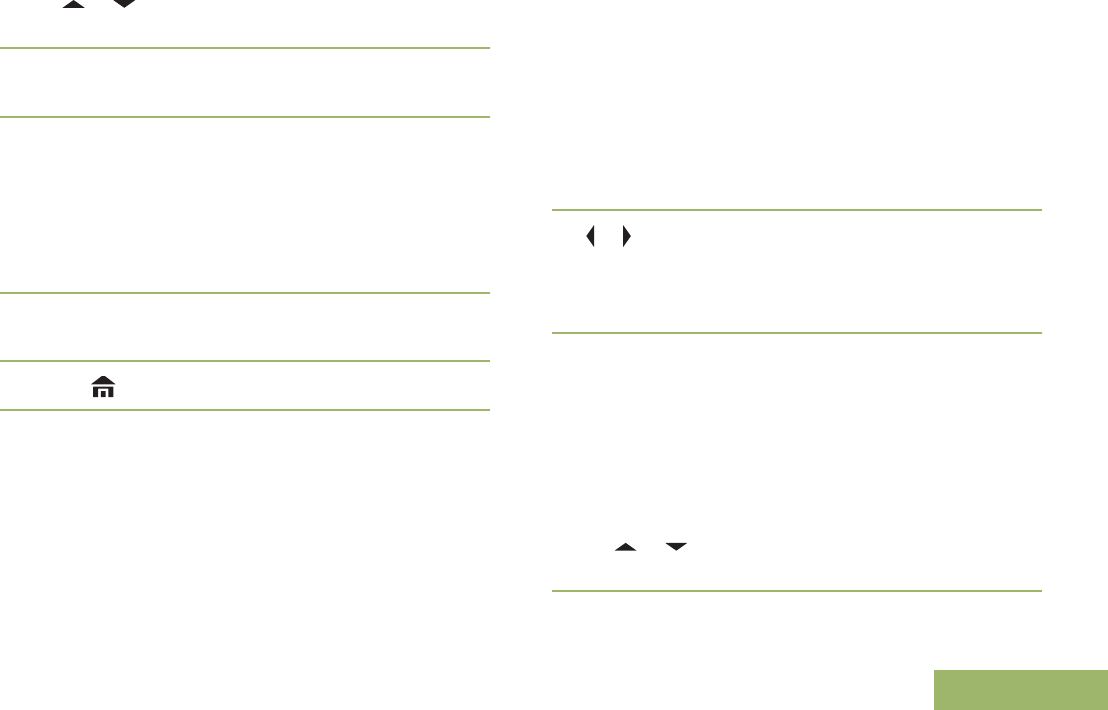
• or to the required ID.
• Use the keypad to enter the required ID.
4Press the PTT button to initiate the Private Call.
The display shows Calling... <Number>.
5Hold the radio vertically 1 to 2 inches (2.5 to 5.0
cm) from your mouth.
When you are connected, the display shows the
ID of the target radio.
If no acknowledgment is received, the display
shows No acknowledge.
6Press and hold the PTT button to talk. Release the
PTT button to listen.
7Press to return to the Home screen.
Making an Enhanced Private Call (Trunking Only)
Your radio must be preprogrammed to allow you to
use this feature.
This feature allows you to send an individual Call
Alert Page if there is no answer from the target radio.
See Sending a Call Alert Page on page 84 for more
information.
1Perform one of the following actions:
• To access this feature via a preprogrammed
button, press the preprogrammed Quick
Access (One-Touch) Enhanced Private Call
button to dial the preprogrammed ID (number)
and initiate the Private Call. Proceed to step 5.
• To access this feature via the menu, proceed
to the next step.
2 or to Call, and press the Menu Select button
directly below Call.
The display shows the last transmitted or received
ID.
3To select the required ID, perform one of the
following actions:
• Press the Menu Select button directly below
Cnts to scroll through and select the required
ID.
• Press the Menu Select button directly below
LNum to go to the last number dialed.
• or to the required ID.
• Use the keypad to enter the required ID.
4Press the PTT button to initiate the Private Call.
General Radio Operation
63
English

The display shows Calling... <Number>.
5Hold the radio vertically 1 to 2 inches (2.5 to 5.0
cm) from your mouth.
When you are connected, the display shows the
ID of the target radio.
If no acknowledgment is received, the display
shows No acknowledge.
If the target radio does not respond before the
time out, the display shows No answer.
6Press and hold the PTT button to talk. Release the
PTT button to listen.
7Press to return to the Home screen.
Making a Telephone Call (Trunking Only)
This feature allows you to make calls similar to
standard phone calls to a mobile or landline phone.
1Perform one of the following actions:
• To access this feature via a preprogrammed
button, press the preprogrammed Quick
Access (One-Touch) Phone Call button to
dial the preprogrammed phone number.
Proceed to step 5.
• To access this feature via the menu, proceed
to the next step.
2 or to Phon, and press the Menu Select button
directly below Phon.
The display shows the last transmitted or received
ID.
3To select the required ID, perform one of the
following actions:
• Press the Menu Select button directly below
Cnts to scroll through and select the required
ID.
• Press the Menu Select button directly below
LNum to go to the last number dialed.
• or to the required phone number.
• Use the keypad to enter the required phone
number.
4Press the PTT button to dial the phone number.
5Hold the radio vertically 1 to 2 inches (2.5 to 5.0
cm) from your mouth.
General Radio Operation
64
English

6When your call is answered, press and hold the
PTT button to talk. Release the PTT button to
listen.
7Press to return to the Home screen.
See Phone Call Displays and Alerts on page 54 for
more information if your call is NOT answered.
Switching Between Repeater or Direct
Operation Button
The Repeater Operation increases the radio
coverage area by connecting with other radios
through a repeater. The transmit and receive
frequencies are different.
The Direct or “talkaround operation” allows you to
bypass the repeater and connect directly to another
radio. The transmit and receive frequencies are the
same.
Perform one of the following actions:
• Press the preprogrammed Repeater/Direct
switch to toggle between talkaround and
repeater modes.
• or to Dir and press the Menu Select button
directly below Dir.
The display shows Repeater mode if the radio is
currently in Repeater mode.
The display shows Direct mode and the Talkaround
icon if the radio is currently in Direct mode (during
conventional operation only).
Monitor Feature
Radio users who switch from analog to digital radios
often assume that the lack of static on a digital
channel is an indication that the radio is not working
properly. This is not the case.
Digital technology quiets the transmission by
removing the noise from the signal and allows only
the clear voice or data information to be heard.
Use the Monitor feature to make sure a channel is
clear before transmitting.
Monitoring a Channel
The following methods are options on how to monitor
a channel. The result of all the methods is the same.
General Radio Operation
65
English

You can use the options interchangeably depending
on your preference and the programmed functions.
•Monitoring a Channel with Volume Set button.
a) Select the desired zone and channel.
b) Press and hold the Volume Set button to hear
the volume set tone.
c) Adjust the Volume Control Knob if necessary.
d) Release the Volume Set button.
e) Press and hold the PTT button to transmit.
The LED lights up solid red.
f) Release the PTT button to receive (listen).
•Monitoring a Channel with Monitor button.
a) Press the preprogrammed Monitor button.
b) Adjust the Volume Control Knob if necessary.
c) Press and hold the PTT button to transmit.
The LED lights up solid red.
d) Release the PTT button to receive (listen).
The Carrier Squelch indicator appears on the
display when you monitor a channel via the
preprogrammed Monitor button.
•Monitoring a Channel via the selected zone
channel.
a) Select the desired zone and channel.
b) Listen for a transmission.
c) Adjust the Volume Control Knob if necessary.
d) Press and hold the PTT button to transmit.
The LED lights up solid red.
e) Release the PTT button to receive (listen).
Monitoring Conventional Mode
Your radio may be preprogrammed to receive Private-
Line® (PL) calls.
1Momentarily press the Monitor button to listen for
activity.
The Carrier Squelch indicator appears on the
display.
2Press and hold the Monitor button to set
continuous monitor operation.
The duration of the button press is programmable.
3Press the Monitor button again, or the PTT
button, to return to the original squelch setting.
If you try to transmit on a receive-only channel,
you hear an invalid tone until you release the PTT
button.
General Radio Operation
66
English

Advanced Features
Advanced Call Features
Selective Call (ASTRO Conventional Only)
This feature allows you to receive a call from or to call
a specific individual. It is intended to provide privacy
and to eliminate the annoyance of having to listen to
conversations that are of no interest to you.
Receiving a Selective Call
When you receive a Selective Call, the radio initiates
for your attention with one of the following indication
scenario:
• You hear two alert tones and the LED lights up
solid yellow to indicate the transmitting radio is still
sending signal. The call received icons blinks and
the display shows Call received.
• The LED blinks solid green once to indicate the
transmitting radio is pending to receive signal.
The speaker unmutes.
1Hold the radio vertically 1 to 2 inches (2.5 to 5.0
cm) from your mouth.
2Press and hold the PTT button to talk. Release the
PTT button to listen.
Making a Selective Call
1Perform one of the following actions:
• To access this feature via a preprogrammed
button, press the preprogrammed Quick
Access (One-Touch) Selective Call button to
dial the preprogrammed ID. Proceed to step 4.
• To access this feature via the menu, proceed
to the next step.
2 or to Call, and press the Menu Select button
directly below Call.
The display shows the last transmitted or received
ID.
3To select the required ID, perform one of the
following actions:
• Press the Menu Select button directly below
Cnts to scroll through and select the required
ID.
• Press the Menu Select button directly below
LNum to go to the last number dialed.
Advanced Features
67
English
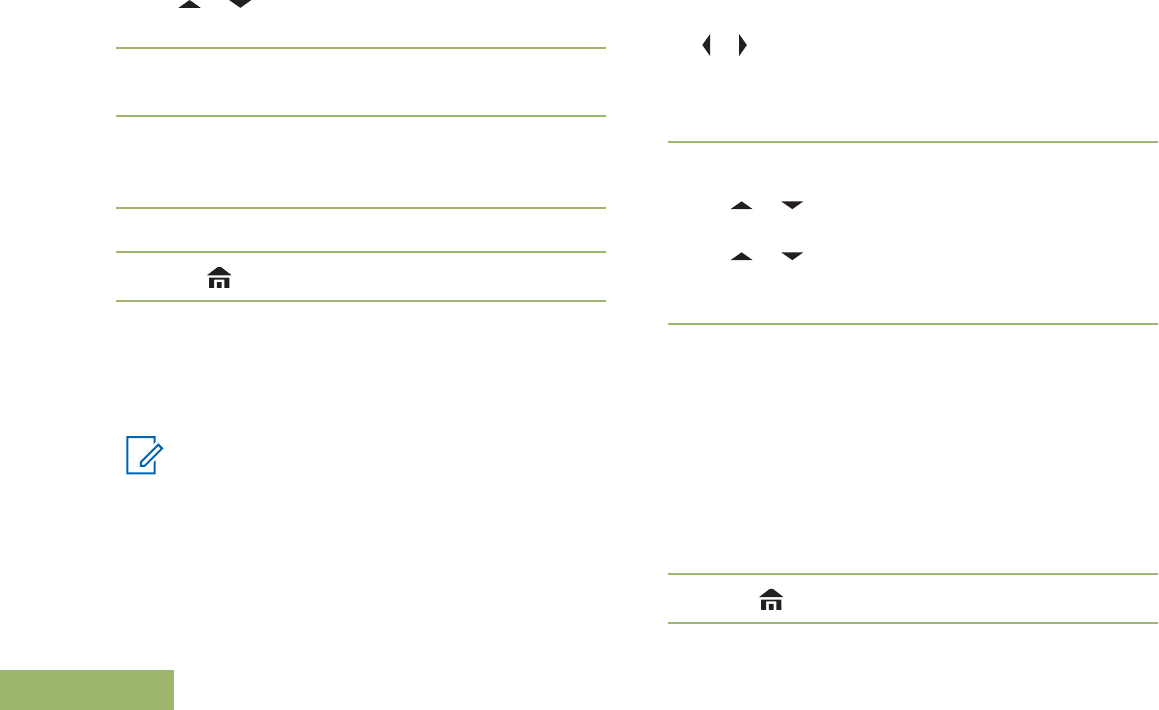
• or to the required ID.
• Use the keypad to enter the required ID.
4Hold the radio vertically 1 to 2 inches (2.5 to 5.0
cm) from your mouth.
5Press and hold the PTT button to start the
Selective Call.
The display shows the ID of the target radio.
6Release the PTT button to listen.
7Press to return to the Home screen.
Talkgroup Call Feature (Conventional Operation Only)
This feature allows you to define a group of
conventional system users so that they can share the
use of a conventional channel.
Note:
Encryption keys are associated to talkgroups.
When talkgroups are associated, encryption
keys are changed by changing the active
talkgroup. See Secure Operations on page
114 for more information.
Selecting a Talkgroup
1 or to Tgrp and press the Menu Select button
directly below Tgrp.
The display shows the last Talkgroup that was
selected and stored.
2Perform one of the following actions:
• or to Preset for the preset
preprogrammed Talkgroup.
• or to the required Talkgroup.
• Use the keypad to enter the number of the
corresponding Talkgroup in the list.
3Press the Menu Select button directly below Sel
to save the currently selected Talkgroup and
return to the Home screen.
If the encryption key associated to the new
Talkgroup is erased, you hear a momentary key
fail tone and the display shows Key fail.
If the encryption key that is associated to the new
Talkgroup is not allowed, you hear a momentary
key fail tone and the display shows Illegal key.
4Press to return to the Home screen.
Advanced Features
68
English

Sending a Status Call
This feature allows you to send data calls to the
dispatcher about a predefined status.
Each status can have up to a 14-character name. A
maximum of eight status conditions is possible.
Note:
The radio automatically exits the feature, if the
feature inactivity timer is enabled, when the
radio is left idle and the timer expires. You will
hear the Menu Inactive Exit Tone upon feature
exit.
1Perform one of the following actions:
• Press the preprogrammed Status button.
• or to Sts and press the Menu Select button
directly below Sts.
The display shows the last acknowledged status
call, or the first status in the list.
2Perform one of the following actions:
• Use the keypad to enter a number
corresponding to the location in the status list.
3Press the PTT button to send the status.
When the dispatcher acknowledges, you hear four
tones and the display shows Ack received . The
radio returns to normal dispatch operation.
If no acknowledgment is received, you hear a low-
pitched tone and the display shows No
acknowledge.
4Press to return to the Home screen.
No traffic is heard on trunked channels while
Status Calls is selected. If the radio detects no
Status Call activity for six seconds, an alert tone
sounds until you press or the PTT button.
Responding to the Dynamic Regrouping Feature
(Trunking Only)
This feature allows the dispatcher to temporarily
reassign selected radios to a particular channel
where they can communicate with each other. This
feature is typically used during special operations and
is enabled by a qualified radio technician.
You will not notice whether your radio has this feature
enabled until a dynamic regrouping command is sent
by the dispatcher.
Advanced Features
69
English

Note:
If you try to access a zone or channel that has
been reserved by the dispatcher as a
dynamically regrouped mode for other users,
you hear an invalid tone.
When your radio is dynamically regrouped, it
automatically switches to the dynamically regrouped
channel. You hear a Gurgle tone and the display
shows the dynamically regrouped channel’s name.
Press the PTT button to talk. Release PTT button
to listen.
When the dispatcher cancels dynamic regrouping, the
radio automatically returns to the zone and channel
that you were using before the radio was dynamically
regrouped.
Requesting a Reprogram (Trunking Only)
This feature allows you to notify the dispatcher when
you want a new dynamic regrouping assignment.
Perform one of the following actions:
• Press the preprogrammed Reprogram
Request button to send reprogram request to
the dispatcher.
• or to Rpgm then press the Menu Select
button directly below Rpgm to send reprogram
request to the dispatcher.
The display shows Reprgrm rqst and Please
wait.
If you hear five beeps, the dispatcher has
acknowledged the reprogram request. The display
shows Ack received and the radio returns to the
Home screen.
If the dispatcher does not acknowledge the
reprogram request within six seconds, you hear a
low-pitched alert tone and the display shows No
acknowledge. Try again or press to cancel and
return to the Home screen.
Classification of Regrouped Radios
The dispatcher can classify regrouped radios into
either of two categories:
Select
Enabled
Select-enabled radios are free to
change to any available channel,
including the dynamic-regrouping
channel, once the user has selected
the dynamic-regrouping position.
Advanced Features
70
English

Select
Disabled
Select-disabled radios cannot change
channels while dynamically regrouped.
The dispatcher has forced the radio to
remain on the dynamic-regrouping
channel.
The Scan or Private Call feature cannot be selected
while your radio is Select Disabled.
Dynamic Zone Programming (DZP)
Note:
Your radio must be preprogrammed to allow
you to use this feature. This feature works on
the condition at least one zone in the radio
must be a non-dynamic zone.
This feature provides one or more Dynamic Zones to
store the frequent used channels be it conventional or
trunking. These dynamic channels are saved from
pre-existing (non-dynamic) channels in the radio. This
saves the time and effort from the regular navigation
around the working zones and channels. User can
also delete or update the list in the Dynamic Zone.
Entering the Dynamic Zone to Select a Dynamic
Channel
1 or to Zone then press the Menu Select button
directly below Zone.
The display shows the Zone screen.
2 or to <# Dynamic Zone Channels>.[2]
3Perform one of the following actions:
•Press the Menu Select button below Sel to
select.
•Press the Menu Select button below Exit to
exit.
If you have selected one of the Dynamic Zone
Channels list, the display returns to Home screen
with the selected <# Dynamic Zone Channels>
shown on the screen.[2]
If you have selected Exit without selecting any
Dynamic Zone Channels list, the display returns to
Home screen without any changes.
2# indicates number of the channel on the 16-Position Switch which are numbered from 1 to 16.
Advanced Features
71
English

Saving a Channel in the Dynamic Zone from List
Selection
The radio must be in Dynamic Zone in order to
perform this operation.
1 or to ZnPr. Press the Menu Select button
directly below ZnPr to enter Program Zone
screen.
2Press the Menu Select button directly below
Edit.
The display shows Search Options screen.
3 or to List Selection. Press the Menu
Select button directly below Sel.
The display shows Select Zone screen.
4 or to the required zone. Press the Menu
Select button directly below Sel.
The display shows Select Chan screen.
5 or to the required channel. Press the Menu
Select button directly below Sel.
The display shows Channel updated.
6Press the Menu Select button directly below Exit
to return to Home screen.
Saving a Channel in the Dynamic Zone from
Channel Name
The radio must be in Dynamic Zone in order to
perform this operation.
1 or to ZnPr then press the Menu Select button
directly below ZnPr to enter Program Zone
screen.
2Press the Menu Select button directly below
Edit.
The display shows Search Options screen.
3 or to Channel Name then press the Menu
Select button directly below Sel.
The display shows a blinking cursor on the
Channel Name screen.
4Use the keypad to type or edit the channel name.
5Press the Menu Select button directly below Srch
once the entry is done to initiate searching.
Advanced Features
72
English

You can cancel this operation at this step by
pressing the Menu Select button directly below
Cncl to return to Search Options screen.
The display shows Searching.... Once found,
the display shows Channel updated.
If the radio is triggered to search for an empty
entry, the display shows Invalid entry.
If the entry does not match, the display shows
Channel name not found. Repeat from step 4 or
5 to search again.
6Press to return to the Home screen.
Deleting a Channel in the Dynamic Zone
The radio must be in Dynamic Zone in order to
perform this operation.
1 or to ZnPr then press the Menu Select button
directly below ZnPr to enter Program Zone
screen.
The display shows the dynamic channels list.
2 or to the saved dynamic channel then press
the Menu Select button directly below Del.
The display shows Channel deleted screen.
3Press the Menu Select button below Exit to
return to Home screen.
The Home screen shows <Dynamic Zone
Channels>.
If the channel deleted is the Home channel, the
Home screen shows <Zone Name>+”Blank”.
Contacts
This feature provides “address-book” capabilities on
your radio. Each entry corresponds to an alias (name)
or ID (number) that you use to initiate a call.
Contact entries are alphabetically sorted according to
entry alias. Each alias can have up to five IDs of
different call types associated with it.
Additionally, each entry, depending on context
(conventional, trunking, or phone), associates with
one or more of the four types of calls: Phone Call,
Selective Call, Private Call, or Call Alert.
Each entry within Contacts contains the following
information:
• Call Alias (Name)
• Call ID (Number)
Advanced Features
73
English
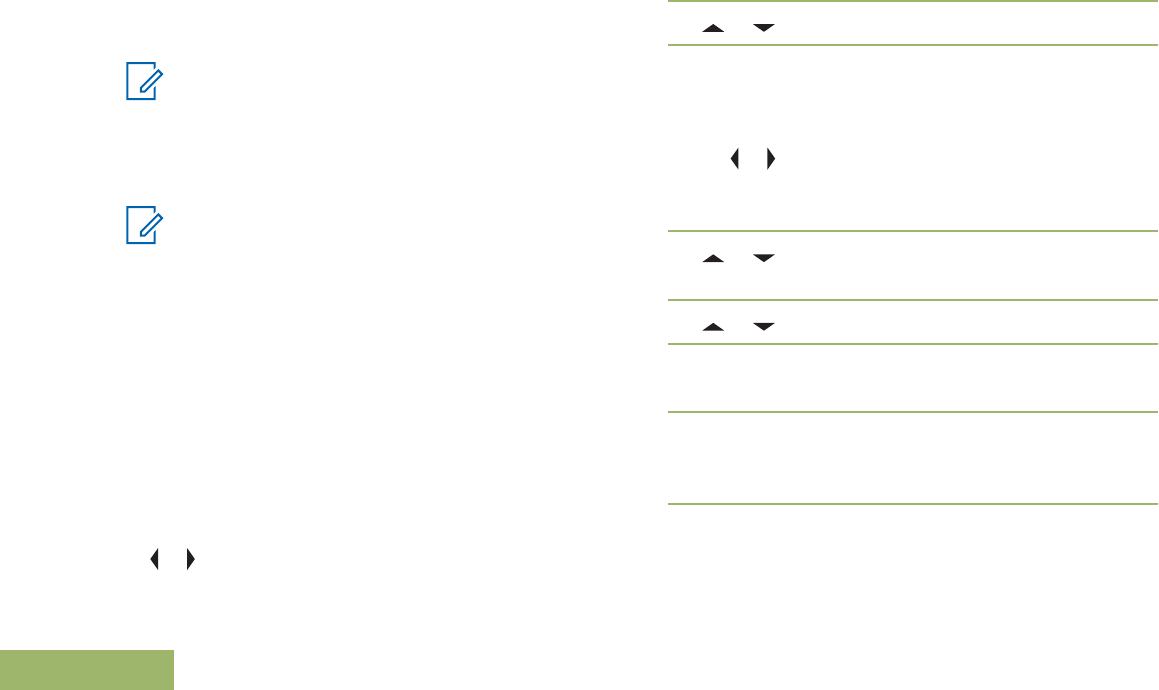
• Call Type (Icon)
• WACN ID (Astro 25 Trunking IDs only)
• System ID
Note:
Your radio must be preprogrammed to allow
you to add, edit, or delete the contact entries.
Your radio also supports a maximum of 50 call lists.
Each list can store up to 100 IDs (numbers).
Note:
Your radio is preprogrammed with a number of
contacts per Call Lists. Check with your dealer
or system administrator for more information.
The radio automatically exits the feature, if the
feature inactivity timer is enabled, when the
radio is left idle and the timer expires. You
hear the Menu Inactive Exit Tone upon feature
exit.
Making a Private Call from Contacts
Your radio must be preprogrammed to allow you to
use this feature.
1 or to Cnts and press the Menu Select button
directly below Cnts.
The entries are alphabetically sorted.
2 or to the required subscriber alias.
3Perform one of the following actions:
• Press the Menu Select button directly below
Optn and proceed to the next step.
• or to scroll through the available IDs for the
selected subscriber alias and proceed to step
6.
4 or to Call and press the Menu Select
button directly below Sel.
5 or to select the call type.
6Hold the radio vertically 1 to 2 inches (2.5 to 5.0
cm) from your mouth.
7Press the PTT button to initiate the call.
During the call, the display shows the subscriber
alias.
8Press and hold the PTT button to talk. Release the
PTT button to listen.
Advanced Features
74
English

The LED lights up solid red when the PTT button
is pressed.
If there is no voice activity for a preprogrammed
period of time, the call ends.
If the call reaches the maximum ring time, the call
ends.
Adding a New Contact Entry
1 or to Cnts and press the Menu Select button
directly below Cnts.
The entries are alphabetically sorted.
2 or to [New Contact] and press the Menu
Select button directly below Sel.
3 or to Name and press the Menu Select
button directly below Edit.
The display shows Edit name and a blinking
cursor appears.
4Use the keypad to enter the name and press the
Menu Select button directly below Ok once you
have entered the name.
To cancel this operation, press the Menu Select
button directly below Cncl to return to the previous
screen.
5 or to [Add Number] and press the Menu
Select button directly below Sel.
6 or to Number 1 and press the Menu Select
button directly below Edit.
The display shows Edit Number 1 and a blinking
cursor appears.
7Use the keypad to enter the number and press
the Menu Select button directly below Ok once
you have entered the number.
To cancel this operation, press the Menu Select
button directly below Cncl to return to the previous
screen.
8Perform one of the following actions per the
information you need to add to current name:
• or to Type 1 and press the Menu Select
button directly below Edit.
or to the required mode and press the
Menu Select button directly below Ok.
Advanced Features
75
English

• Repeat Steps 6 through 7 to enter or edit the
exisitng system IDs.
• Repeat Steps 5 through 7 to add a new
number.
9Press the Menu Select button directly below Done
once you have finished.
The display shows <Entry> Stored, confirming
that the contact entry has been added.
The radio returns to the main Contacts screen.
Deleting a Contact Entry
1 or to Cnts and press the Menu Select button
directly below Cnts.
The entries are alphabetically sorted.
2 or to the entry you want to delete and press the
Menu Select button directly below Optn.
3 or to Del and press the Menu Select button
directly below Sel.
The display shows Delete <Entry> confirm?.
4Select the Menu Select button directly below Yes
to delete the entry, or No to cancel and return to
the main screen of Contacts.
The display shows <Entry> deleted and the
radio returns to the main screen of Contacts.
Adding a Contact to a Call List
1 or to Cnts and press the Menu Select button
directly below Cnts.
The entries are alphabetically sorted.
2 or to the entry you want to add and press
the Menu Select button directly below Optn.
3 or to Add to CallLst and press the Menu
Select button directly below Sel.
4Perform one of the following actions:
• or to the required Call List and press the
Menu Select button directly below Add to add
to the Call List.
• or to Cncl to cancel and return to the
main screen of Contacts.
Advanced Features
76
English

The display shows momentary Please wait
before showing <Entry> added to Call List,
confirming the addition of the contact to the list.
The radio returns to the main display of Contacts.
Removing a Contact from a Call List
1 or to Cnts and press the Menu Select button
directly below Cnts.
The entries are alphabetically sorted.
2 or to the entry you want to delete and press
the Menu Select button directly below Optn.
3 or to Rm frm CallLst and press the Menu
Select button directly below Sel.
The display shows Remove <Entry> frm Call
List?.
4Press the Menu Select button directly below Yes
to remove the entry from the Call List, or No to
cancel and return to the main display of Contacts.
The display shows momentary Please wait
before showing <Entry> removed from Call
List, confirming the removal of the contact from
the list.
The radio returns to the main display of Contacts.
Methods of Contact Editing in a Call List
Editing an Entry Alias
1 or to Cnts and press the Menu Select button
directly below Cnts.
The entries are alphabetically sorted.
2 or to the entry you want to edit and press
the Menu Select button directly below Optn.
3 or to Edit and press the Menu Select
button directly below Sel.
4 or to the entry alias you wish to change and
press the Menu Select button directly below Edit.
A blinking cursor appears.
5Use the keypad to edit the name and press the
Menu Select button directly below Ok once you
have finished.
The display returns to the Edit Contact screen.
Advanced Features
77
English
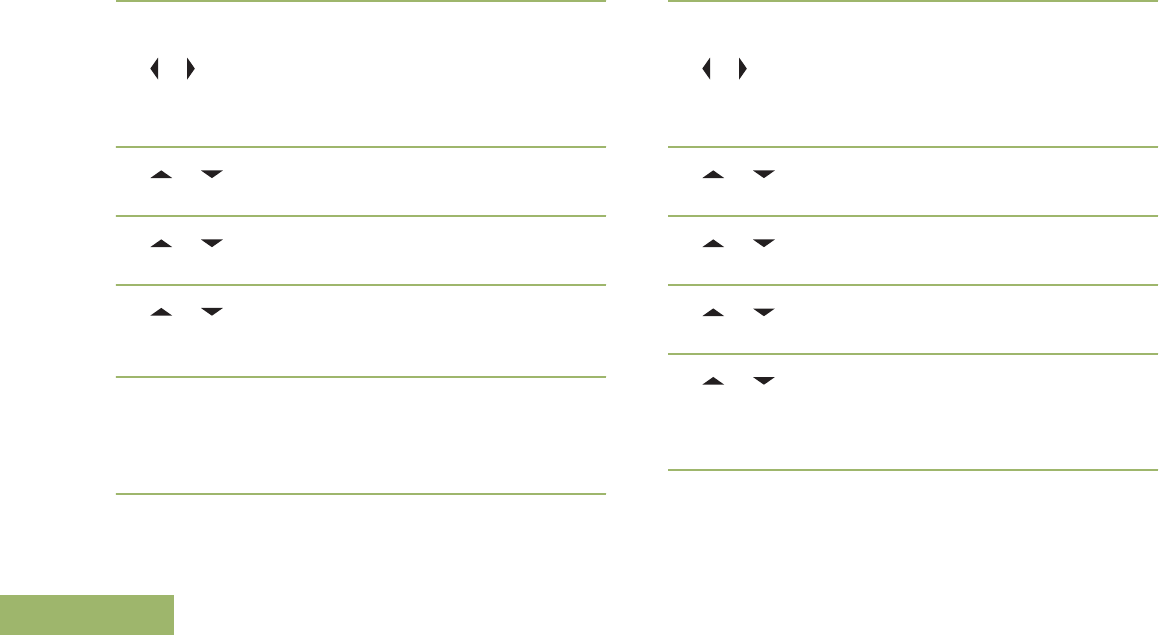
6Press the Menu Select button directly below Done
to save your changes and return to the main
screen of Contacts.
Editing as Entry ID
1 or to Cnts and press the Menu Select button
directly below Cnts.
The entries are alphabetically sorted.
2 or to the entry you want to edit and press
the Menu Select button directly below Optn.
3 or to Edit and press the Menu Select
button directly below Sel.
4 or to the entry ID you wish to change and
press the Menu Select button directly below Edit.
A blinking cursor appears.
5Use the keypad to edit the number and press the
Menu Select button directly below Ok once you
have finished.
The display returns to the Edit Contact screen.
6Press the Menu Select button directly below Done
to save your changes and return to the main
screen of Contacts.
Editing a Call Type
1 or to Cnts and press the Menu Select button
directly below Cnts.
The entries are alphabetically sorted.
2 or to the entry you want to edit and press
the Menu Select button directly below Optn.
3 or to Edit and press the Menu Select
button directly below Sel.
4 or to Type and press the Menu Select
button directly below Edit.
5 or to choose from the list of call types given
and press the Menu Select button directly below
Ok.
The display returns to the Edit Contact screen.
Advanced Features
78
English

6Press the Menu Select button directly below Done
to save your changes and return to the main
screen of Contacts.
Viewing Details of a Contact
1 or to Cnts and press the Menu Select button
directly below Cnts.
The entries are alphabetically sorted.
2 or to the entry you want to view and press
the Menu Select button directly below Optn.
3 or to View and press the Menu Select
button directly below Sel.
The display shows all the numbers associated with
the entry.
Scan Lists
Scan lists are created and assigned to individual
channels/ groups. Your radio scans for voice activity
by cycling through the channel/group sequence
specified in the scan list for the current channel/
group.
Your radio supports different types of Scan Lists:
• Trunking Priority Monitor Scan List
• Conventional Scan List
• Talkgroup Scan List
Please refer to a qualified radio technician for the
maximum number of Scan Lists can be programmed
in your radio. These lists must be preprogrammed by
a qualified radio technician.
Viewing a Scan List
1 or to ScnL and press the Menu Select button
directly below ScnL.
2 or to view the members on the list.
3Press to exit the current display and return to
the Home screen.
Editing the Scan List
This feature lets you change scan list members and
priorities.
1Perform one of the following actions:
Advanced Features
79
English

• Long press the preprogrammed Scan List
Programming button (side button).
• Move the preprogrammed Scan List
Programming switch to programming position.
• or to ScnL then press the Menu Select
button directly below ScnL.
The display shows the lists that can be changed.
2 or to the entry you want to edit.
3Perform one of the following actions:
• Press the Menu Select button directly below
Sel to add and/or change the priority of the
currently displayed channel in the scan list.
• Press the Menu Select button directly below
Del to delete the currently displayed channel
from the scan list.
• Press the Menu Select button directly below
Rcl to view the next member of the scan list.
4Perform one of the following actions to select
another channel that needs to be added or deleted
then repeat step 3. Otherwise, proceed to the next
step.
• or to the desired channel.
• Use the keypad to enter the desired channel
name.
• Use the 16-Position Select knob to select the
channel.
5Perform one of the following actions:
• Move the Scan List Programming switch out
of programming position.
•Press to exit scan list programming and
return to the Home screen.
See Viewing and Changing the Priority Status on
page 81 for more information on how to add and/or
change the priority of the currently displayed channel
in the scan list.
Changing the Scan List Status
1Perform one of the following actions:
• Long press the preprogrammed Scan List
Programming button (side button).
• Move the preprogrammed Scan List
Programming switch to programming position.
The display shows the programming mode icon
and the first list member.
Advanced Features
80
English

2 or to the member you want to edit.
3Perform one of the following actions:
• Press the Select button once to add the
currently displayed channel to the scan list.
• Press the Select button one or more times to
change the scan list status icon of the currently
displayed channel.
4Perform one of the following actions:
• or to select more list members whose
scan status you want to change.
• Use the keypad to go directly to that scan list
member.
• Use the 16-Position Select knob to select
another scan list member.
5Move the Scan List Programming switch out of
programming position.
Viewing and Changing the Priority Status
Perform one of the following actions:
• Press the Menu Select button directly below
Sel one or more times to change the priority
status of the current displayed channel.
• Press the Select button one or more times to
toggle between different status of the Scan List
status icon of the current displayed channel.
The radio shows one of following priority status
icons and scenarios:
• A Scan icon indicates that the current channel
is in the scan list as a non-priority channel. The
LED lights up solid green.
• A Priority-Two Channel Scan icon indicates
that the current channel is in the scan list as
the Priority-Two channel. The LED blinks
green.
• A Priority-One Channel Scan icon indicates
that the current channel is in the scan list as
the Priority-One channel. The LED rapidly
blinks green. You hear all traffic on the Priority-
One channel, regardless of traffic on non-
priority channels.
• No icon indicates that the current channel is
deleted from the scan list.
Advanced Features
81
English

Scan
This feature allows you to monitor traffic on different
channels by scanning a preprogrammed list of
channels.
Turning Scan On or Off
Perform one of the following actions:
• Press the preprogrammed Scan button to
toggle Scan On or Scan Off to initiate or stop
scan.
• Turn the preprogrammed Scan switch to the
Scan on or Scan off position to initiate or stop
scan.
• or to Scan and press the Menu Select
button directly below Scan.
If the scan is enabled, the display shows Scan on
and the scan status icon.
If the scan is disabled, the display shows Scan
Off.
The radio returns to the Home screen.
Making a Dynamic Priority Change (Conventional Scan
Only)
While the radio is scanning, the dynamic priority
change feature allows you to temporarily change any
channel in a scan list (except for the Priority-One
channel) to the Priority-Two channel.
This change remains in effect until scan is turned off.
Scan then reverts to the preprogrammed (original)
setting.
Making a Dynamic Priority Change via the
preprogrammed Dynamic Priority button:
a) When the radio locks onto the channel
designated as the new Priority-Two channel,
press the preprogrammed Dynamic Priority
button.
The radio continues scanning the remaining
channels in the list.
Deleting a Nuisance Channel
If a channel continually generates unwanted calls or
noise (termed a “nuisance” channel), you can
temporarily remove the unwanted channel from the
scan list.
Advanced Features
82
English

This capability does not apply to priority channels or
the designated transmit channel.
When the radio is locked onto the channel to be
deleted, perform one of the following actions:
• Press the preprogrammed Nuisance Delete
button.
• or to Nuis and press the Menu Select
button directly below Nuis.
The radio continues scanning the remaining channels
in the list.
Restoring a Nuisance Channel
To restore the deleted nuisance channel, perform
one of the following actions:
• Stop and restart a scan.
• Mode change to another channel and back to
the original channel.
• Turn off the radio and then turn it on again.
Nuisance mode delete can be disabled by the
system administrator.
Call Alert Paging
This feature allows your radio to work like a pager.
Even if other users are away from their radios, or if
they are unable to hear their radios, you can send
them an individual Call Alert page. You can also
verify if a radio is active on the system.
Depending on how your radio is programmed, when
you make an Enhanced Private Call, the radio either
automatically sends a call alert page if there is no
answer after the maximum ring time, or when you
press the PTT button.
Note:
This feature must be preprogrammed by a
qualified radio technician.
Receiving a Call Alert Page
When you receive a Call Alert page, you hear four
repeating alert tones and the LED blinks green. The
call received icons blinks and the display shows Page
received.
Press any button to clear the Call Alert page.
Advanced Features
83
English

See Making a Talkgroup Call on page 62 or Making a
Private Call (Trunking Only) on page 62 for more
information on returning the call.
Sending a Call Alert Page
The following methods are options on how to send a
call alert page. The result of all the methods is the
same. You can use the options interchangeably
depending on your preference and the programmed
functions.
Note:
If the feature inactivity timer is enabled, your
radio automatically exits the feature when your
radio is left idle long enough for the time to
expire. You hear the Menu Inactive Exit Tone
upon feature exit.
•Sending a call alert page via the preprogrammed
Quick Access (One-Touch) Call Alert Paging
button:
a) Press the preprogrammed Quick Access
(One-Touch) Call Alert Paging button to send
a page to the preprogrammed ID.
The display shows Paging...<Number>.
If the call alert page is sent successfully, you
hear a tone and the display shows Ack
received. The radio returns to the Home
screen.
If the call alert page is not acknowledged, you
hear a low tone and the display shows No
acknowledge. Press the Menu Select button
directly below Ok to return to the main screen
for Contacts.
•Sending a call alert page via the radio menu Page:
a) or to Page.
b) Press the Menu Select button directly below
Page.
c) Press the Menu Select button directly below
Cnts to view the required ID, or to the
required ID, or use the keypad to enter the
required ID.
d) Press the PTT button to send the page.
The display shows Paging...<Number>.
If the call alert page is sent successfully, you
hear a tone and the display shows Ack
received. The radio returns to the Home
screen.
Advanced Features
84
English

If the call alert page is not acknowledged, you
hear a low tone and the display shows No
acknowledge. Press the Menu Select button
directly below Ok to return to the main screen of
Contacts.
•Sending a call alert page via the radio menu Call:
a) or to Call.
b) Press the Menu Select button directly below
Call.
c) or to select the alias or ID, and press the
PTT button to initiate the call.
If the target radio does not respond after a
preprogrammed period of time, the display
shows Send page?.
d) To send the call alert page, press the Menu
Select button directly below Yes. To exit the
screen without sending the call alert page,
press the Menu Select button directly below
No.
The display shows Paging...<Alias>.
If the call alert page is sent successfully, you
hear a tone and the display shows Ack
received. The radio returns to the Home
screen.
If the call alert page is not acknowledged, you
hear a low tone and the display shows No
acknowledge. Press the Menu Select button
directly below Ok to return to the main screen of
Contacts.
Quick Call II (ASTRO P25 Digital Trunking and
Conventional)
This feature allows the user to broadcast a series of
distinct, recognizable tones before a voice
transmission from the dispatcher or a radio.
The broadcasting dispatcher or radio user can select
this alert tone transmission to be sent to an individual
Talkgroup or over the entire system. Specific tone or
series of tones are pre-programmed into the radios to
allow the dispatcher or supervisor to select a list of
tones to broadcast before they make their voice
transmission. Each tone is distinctive to indicate
different situation or different broadcaster. The
transmitting radio also plays back the tones for the
broadcaster to listen.
Note:
The receiving radios must be configured with
the Quick Call II tone in order for the radio to
Advanced Features
85
English

sound the selected tone and also to sound a
preconfigured alert tone after the selected
tone has sound.
Initiating a Quick Call II Transmission
The broadcasting or transmitting radio must be pre-
programmed to see the tone in the Quick Call II tone
list. The receiving radio must also be pre-
programmed to decode the tone to broadcast.
1 or to QCII, and press the Menu Select button
directly below QCII.
2 or to select the tone to broadcast.
3Press the PTT to broadcast the selected tone, or
press and hold the PTT to broadcast the selected
tone and transmit with your vocal transmission.
You hear the radio sounds the selected tone. You
can begin your call after the tone ends.
4Release PTT to listen.
Emergency Operation
The Emergency feature is used to indicate a critical
situation.
If the Top (Orange) button is preprogrammed to send
an emergency signal, this signal overrides any other
communication over the selected channel.
Your radio supports the following Emergency modes:
• Emergency Alarm
• Emergency Call (Trunking Only)
• Emergency Alarm with Emergency Call
• Silent Emergency Alarm
Check with your dealer or system administrator for
more information on the programming of this feature.
Each channel can only assigned one of the
Emergency modes above. The radio responds
differently when pressing the preprogrammed
Emergency button in each channel.
Note:
To exit emergency at any time, press and hold
the preprogrammed Emergency button for
about a second. This timer is programmable
Advanced Features
86
English

from 0 – 6250 milliseconds by a qualified
technician.
The radio operates in the normal dispatch
manner while in Emergency Call, except if
enabled, it returns to one of the following:
Tactical/Non-
Revert
The radio sends
emergency alarm and/or
make emergency call on
the current selected
channel.
Non-Tactical/
Revert for
Conventional
system
The radio reverts to the
preprogrammed
emergency channel to
send alarm and/or make
emergency call.
Non-Tactical/
Revert for
Trunking
system
The radio reverts to the
preprogrammed
emergency talkgroup to
send alarm and/or make
emergency call.
Man Down is an alternate way to activate the
Emergency feature on the condition the Emergency
must be set up for this feature to operate.
See Man Down on page 90 for details.
Sending an Emergency Alarm
This feature allows you to send a data transmission,
which identifies the radio sending the emergency, to
the dispatcher.
Note:
The default timer of Emergency button press
to activate Emergency is 50 milliseconds. This
timer is programmable from 50 – 6200
milliseconds by a qualified technician.
Press the preprogrammed Emergency button.
One of the following scenarios occurs:
•The display shows Emergency on the current
zone and channel. You hear a short medium-
pitched tone and the LED blinks red
momentarily.
• The radio sounds a short low-pitched tone to
indicate that the selected channel does not
support emergency and rejects to launch
emergency mode.
When you receive the dispatcher’s acknowledgment,
the display shows Ack received. Four tones sound,
Advanced Features
87
English

the alarm ends, and the radio exits the Emergency
Alarm mode.
If no acknowledgement is received, the display shows
No acknowledge. The alarm ends when the timer
expires and the radio exits the Emergency Alarm
mode.
Sending an Emergency Call (Trunking Only)
This feature gives your radio priority access to a
talkgroup.
1Press the preprogrammed Emergency button.
One of the following scenarios occurs:
•The display shows Emergency on the current
zone and channel. You hear a short medium-
pitched tone and the LED blinks red
momentarily.
• You hear the radio sounds a short low-pitched
tone to indicate the selected channel does not
support emergency and rejects to launch
emergency mode.
2Hold the radio vertically 1 to 2 inches (2.5 to 5.0
cm) from your mouth.
3Press and hold the PTT button. Speak clearly into
the microphone.
4Release the PTT button to end the transmission
and wait for a response from the dispatcher.
5To exit Emergency Call, press and hold the
preprogrammed Emergency button for about a
second.
Sending an Emergency Alarm with Emergency Call
This feature gives your radio priority access on a
channel for conventional system, and to a talkgroup
for trunking system.
1Press the preprogrammed Emergency button.
If successful, the display shows Emergency on the
current zone and channel. You hear a short,
medium-pitched tone and the LED blinks red
momentarily.
The radio exits Emergency Alarm and enters the
Emergency Call state when one of the following
scenarios occur:
• You receive the dispatcher acknowledgment.
The display shows Ack received.
Advanced Features
88
English

• You receive no acknowledgement. The display
shows No acknowledge.
• You press the PTT button while in the
Emergency Alarm mode.
If unsuccessful, you hear the radio sounds a short
low-pitched tone to indicate the selected channel
does not support emergency and rejects to launch
emergency mode.
2Hold the radio vertically 1 to 2 inches (2.5 to 5.0
cm) from your mouth.
3Press and hold the PTT button. Speak clearly into
the microphone.
4Release the PTT button to end the transmission
and wait for a response from the dispatcher.
5To exit Emergency Call, press and hold the
preprogrammed Emergency button for about a
second.
Turning off the radio also cancels the emergency
state.
Sending a Silent Emergency Alarm
This feature allows you to send an Emergency Alarm
to the system without triggering any audio or visual
indicators.
1Press the preprogrammed Emergency button.
The display shows no changes, the LED does not
light up, and you hear no tones. The silent
emergency state continues until you perform the
next step.
2Perform one of the following actions:
• You press and hold the preprogrammed
Emergency button for about a second to exit
the Silent Emergency Alarm mode.
• Press and release the PTT button to exit the
Silent Emergency Alarm mode and enter
regular dispatch or Emergency Call mode.
Change of Channels during Emergency
For ALL Emergency transmissions, when changing
channels:
• If the new channel is also preprogrammed for
Emergency, you can change channels while in
Advanced Features
89
English

Emergency operation. The emergency alarm or
call continues on the new channel.
• If the new channel is not preprogrammed for
Emergency, the display shows No emergency,
and you hear an invalid tone until you exit the
Emergency state or change to a channel
preprogrammed for Emergency.
Emergency Keep-Alive Feature
This feature, when enabled, prevents the radio from
being turned off via the On/Off Control Knob when
the radio is in the Emergency state.
Note:
The radio only exits the Emergency state
using one of the ways mentioned in the
previous sections.
See Sending an Emergency Alarm on page
87, Sending an Emergency Call (Trunking
Only) on page 88, Sending an Emergency
Alarm with Emergency Call on page 88, or
Sending a Silent Emergency Alarm on page
89.
Man Down
Man Down condition is determined based upon the
radio tilt angle or a combination of radio tilt angle and
the lack of radio motion.
Man Down feature is an alternate way to activate the
Emergency feature if Emergency has been
programmed in your radio.
Note:
This feature could be preprogrammed for all
channels that support Emergency feature or
could be preprogrammed specifically to a zone
and channel which has Emergency feature.
Consult your agent or qualified technician for
more details.
Your radio automatically activates Emergency Alarm
or Call when the radio achieves or passes a tilt angle
threshold or a combination of the angle threshold and
radio motion below the motion sensitivity level,
depending upon how the radio is programmed. The
radio must stay in this condition for a preprogrammed
amount of time before the Emergency Alarm or Call is
activated.
Advanced Features
90
English

Note:
It is recommended that an Emergency button
is preprogrammed in order to allow the user to
exit the emergency condition.
The Man Down feature provides a Clear function to
the user. After a Man Down condition has been
detected, the user can press a preprogrammed Clear
button or preprogrammed Menu Select button to
cancel the Man Down condition. The radio remains in
the Man Down state without triggering an emergency
condition until the radio is moved out of the Man
Down state, at which point Man Down functionality
resumes.
The Man Down feature has three phases:
1The radio senses the Man Down condition and
Pre-Alert Timer is initiated.
2Man Down condition continues for the time
duration defined in the Pre-Alert Timer field. At the
end of this time, the radio alerts the user on the
Man Down status with an audible alert tone and
Man-Down text on the screen. The Post-Alert Timer
also initiates at this point.
3Man Down condition continues for the time
duration defined in the Post-Alert Timer field. Once
the timer expires, the Emergency alarm is
transmitted. The Man Down Clear function is used
in this phase to cancel the Man Down condition.
The following scenarios affect the timers:
• Pressing the PTT button suspends the Man Down
timers; releasing the PTT button re-initiates the
Pre-Alert Timer.
• Pressing other buttons on the radio does not
impact these timers.
• Repositioning the radio exits the Man Down
feature, which stops and resets the timers.
• Pressing a preprogrammed Clear button or
pressing a Menu Select button preprogrammed
for Clear stops and resets the timers. The timers
do not restart until the radio is repositioned.
Note:
Emergency must be set up for this feature to
operate. For details on operating the
Emergency alerts, please see Emergency
Operation on page 86.
If the radio is preprogrammed to horizontal
only, it must be worn in a vertical position
otherwise the Man Down alert may be
inadvertently triggered.
Advanced Features
91
English

When the radio is programmed with Man
Down feature, special care is required when
charging the radio with a wall mounted
charger. See Proper Ways to Handle the
Radio on page 185 for details.
Pre-Alert Timer
This timer sets the amount of time that a Man Down
condition must be present before the radio-user is
warned of the Man Down condition.
When the radio detects that it has returned to the
vertical position or when the radio detects motion, the
Pre-Alert timer stops and is reset.
The Pre-Alert timer reinitiates when the radio detects
it is in the horizontal position or motionless again.
Post-Alert Timer
This timer sets the amount of time the radio needs to
remain in the Man Down condition before the
Emergency alarm is transmitted. When the Post-Alert
Timer is initiated, the radio alerts the user with an
audible tone and displays the “Man-Down” text.
See Exiting Man Down Feature on page 93 to exit
Man Down feature.
Radio Alerts When Man Down Feature is Triggered
The Man Down alert tone volume is directly related to
the radio speaker volume. Ensure that the radio
speaker volume is loud enough so that the user does
not miss the Post-Alert tone.
Note:
If the radio is programmed with Silent
Emergency, the radio inhibits the alert tone
and visual alert associated with the
emergency feature.
If the radio is programmed in Surveillance
Mode, the radio inhibits all tones and lights on
the radio including the Man Down tones.
Triggering Emergency
When the user does not clear the Man Down
condition and the Post-Alert Timer comes to an end,
Emergency Alarm or call is triggered. The radio sends
emergency message to units within the same
Talkgroup. The radio also sends ID number and GPS
coordinates to dispatcher if these features are
enabled. User can exit Emergency following the
Emergency procedure. See Emergency Operation on
page 86 for details.
Advanced Features
92
English

Note:
At this point the Man Down features is
complete. Use normal Emergency procedures
to cancel Emergency transmissions.
Radio Alerts When Man Down Enhanced is Triggered
Note:
This feature is to be preprogrammed
specifically to a zone and channel which
supports Emergency feature.
The volume and repetition duration of Man
Down Enhanced alert tone could be
customized and preprogrammed to suite the
required situation.
Consult your agent or qualified technician for
more details.
When the radio initiates Man Down Enhanced, you
hear the Critical Man Down Continuous alert tone
from the radio speaker. The volume of this tone is set
to the louder of the preprogrammed minimum level or
the current radio speaker level. This acts as a beacon
to find the radio.
Note:
If the radio is programmed with Silent
Emergency, the radio inhibits the alert tone
and visual alert associated with the
emergency feature.
If the radio is programmed in Surveillance
Mode, the alert tone can be heard from the
radio speaker.
Once the alert tone is active, changing to another
channel with different setup triggers a different
response from the radio as described next.
• The alert tone is inhibited when you change to a
channel without Emergency feature.
• The alert tone is inhibited when you change to a
channel with Emergency but no Man Down
feature.
• The current alert tone is inhibited and is replaced
with a different alert tone when you change to a
channel with Emergency and different Man Down
configuration.
• The alert tone continues when you change to a
channel with Emergency and similar Man Down
configuration.
Exiting Man Down Feature
If you are not in a real Man Down situation, you
should exit the Man Down feature and prevent
Advanced Features
93
English

emergency from going off with the following
operation.
Perform one of the following actions:
• Repositioning the radio or shaking the radio
(when motion sensitivity is enabled).
• Press the preprogrammed Man Down Clear
button to exit.
•Press the Menu Select button below Clr to
exit.
Re-Initiating Man Down
After exiting the Emergency Operation when the radio
is still in Man Down condition (tilted achieving
threshold angle or motionless), user must first exit
Man Down condition to then reinitiate the Man Down
feature.
Return the radio to the vertical position or shake
the radio (when motion sensitivity is enabled).
Testing the Man Down Feature
Enable the Emergency feature with Silent Alarm
disabled, but not in Surveillance Mode before running
this test on the radio.
1Turn the radio on and place in the vertical position,
for at least 5 seconds.
2Lay the radio down in the horizontal position.
3Wait for alert tone.
One of the following scenarios occurs:
• The radio alerts with audible tone and displays
Man-Down.
• If no tone is heard, make sure that the Man Down
feature is enabled on your radio. If Man Down
feature was not enabled, please enable it and
repeat 1 to 3.
• If the Man Down feature is enabled and no tone is
heard, send the radio to a qualified technician.
Automatic Registration Service (ARS)
This feature provides an automated data application
registration for the radio. When you turn on the radio,
the device automatically registers with the server.
Data applications within the fixed network can
determine the presence of a device on the system
and send data to the device. For example: Text
Messaging Service (TMS).
Advanced Features
94
English

The Automatic Registration Service for the radio
consists of two (2) modes:
• ARS Server Mode (default mode)
• ARS Non-Server Mode
Note:
The default ARS mode can be changed by a
qualified radio technician using the radio’s
programming software.
Selecting or Changing the ARS Mode
The following methods are options on how to select
or change the ARS Mode. The result of all the
methods is the same. You can use the options
interchangeably depending on your preference and
the programmed functions.
•Selecting or Changing the ARS mode via 16-
Position Select knob:
a) Once the zone you want is displayed, turn the
preprogrammed 16-Position Select knob to
the desired mode.
•Selecting or Changing the ARS mode via the radio
menu:
a) or to Chan.
b) Press the Menu Select button directly below
Chan.
The display shows the current channel name.
c) or to the required channel or mode.
One of the following scenarios occur:
• In ARS Server Mode, the display shows the
zone and ARS server channel.
• In ARS Non-Server Mode, the display
shows the zone and ARS non-server
channel.
• If the channel or mode selected is
unprogrammed, the display shows
Unprogrammed. Repeat this step.
d) Press Sel to confirm the displayed channel.
User Login Feature
This feature allows you as the user to be associated
with the radio. With this association, every data
application (Example: Text Messaging Service) takes
on a friendly username.
You can still send text messages without logging in
as a user. The user login feature only enables the
recipient of your message to identify you as the
sender by assigning a username to your message.
Advanced Features
95
English

Note:
A predefined username that is set more than
the maximum allowed characters is an invalid
name.
Logging In as a User
1Perform one of the following actions:
• Press the preprogrammed User Login button.
• or to User and press the Menu Select
button directly below User.
The display shows the User Login screen.
2Perform one of the following actions:
• or to [ID Entry] and press the Menu
Select button directly below Edit to enter ID. A
blinking cursor appears on the screen. Use the
keypad to type or edit a user name. Press the
Menu Select button directly below Ok to
submit.
• or to scroll through the list of predefined
user names. Press the Menu Select button
directly below Sel to select the predefined user
name.
• Press and hold or to scroll through the
list of predefined user names at a fast scroll
rate. Press the Menu Select button directly
below Sel to select the predefined user name.
If the ID is invalid, the display shows momentary
Invalid ID.
3Enter your Personal Identification Number (PIN)
number.
4Press the Menu Select button directly below
Logn.
One of the following scenarios occurs:
• In ARS Server Mode, the display shows the
User Login Indicator icon, the ID, and In
progress, with Cncl.
• In ARS Non-Server Mode, the display shows
the User Login Indicator icon, the ID, and
Logged in, with Logt and Exit.
• In non-ARS enabled mode, the display shows
Offline, with Logt and Exit.
One of the following scenarios occurs:
Advanced Features
96
English

• If the user name is invalid, login fails and the user
login failure indicator (IP indicator) icon blinks. The
display also shows momentary Login failed.
• If the PIN is invalid, login fails and the user login
failure indicator (IP indicator) icon blinks. The
display also shows momentary Login failed.
• Wait for the logged in confirmation screen. If the
login process is successful, the display shows the
successful user login indicator (IP indicator) icon
and Logged in, with Logt and Exit.
Note:
To cancel the login process and return to the
initial user login screen, press the Menu
Select button directly below Cncl.
Logging Out
When you have logged in or you are using Offline
mode, you can log out.
Note:
Private data refers to all messages in the text
messaging Inbox, Draft, and Sent folder. The
next user is able to access the Inbox, Draft
and Sent messages if private data is not
deleted.
1Press the Menu Select button directly below
Logt.
One of the following scenarios will occur:
•The display shows Clear private data?.
Proceed to the next step.
• If the Delete Messages On Session End
feature is enabled, the radio clears the private
data and returns to User Login screen.
2Perform one of the following actions:
•Select Yes to clear all your private data. The
display shows momentary Private data
cleared.
•Select No to keep your private data.
Text Messaging Service (TMS)
This features allows you to quickly send and receive
messages and run database queries directly from
your radios. The maximum length of characters for a
text message is 200.
The types of text messages available:
• A new text message (free form message).
Advanced Features
97
English
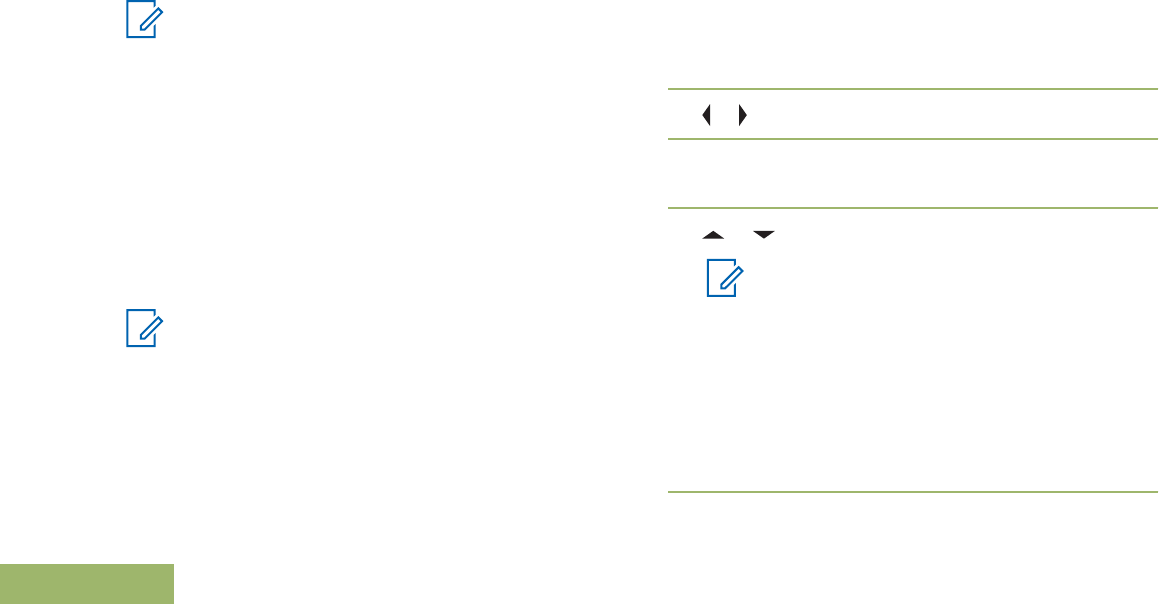
• A predefined message (quick text message).
• An edited quick text message.
• A query (ASTRO 25 Advanced Messaging
Solution).
Note:
Query is only supported within ASTRO 25
Advanced Messaging Solution. See Two-
Factor Authentication on page 109 and
ASTRO 25 Advanced Messaging Solution on
page 108 for details.
The main menu consists of the following options:
• Inbox
• Compose
• Drafts
• Sent
Note:
See Status Icons on page 41 for more
information on the TMS icons and TMS Menu
Options on page 47 for more information on
each menu option.
Accessing the Messaging Features
1Perform one of the following actions:
• Press the Data Feature button or the
preprogrammed TMS Feature button to access
the TMS feature screen.
• Press and hold the Data Feature button or the
preprogrammed TMS Feature button to access
the Inbox.
• Follow the procedure described next to access
this feature via the radio menu.
2 or to TMS.
3Press the Menu Select button directly below TMS
to access the TMS feature screen.
4 or to scroll through the main menu options.
Note:
The radio automatically exits the feature, if
the feature inactivity timer is enabled, when
the radio is left idle and the timer expires.
You will hear the Menu Inactive Exit Tone
upon feature exit.
Press the Menu Select button directly
below Back at any time to return to the
previous screen.
Advanced Features
98
English

Composing and Sending a New Text Message
During the uppercase and lowercase mode, multi-
tapping the keys only scrolls through the letters. For
example, A->B->C, a->b->c.
During the numeric mode, except for , pressing
the keypad only enters the numeric digits.
Subsequent presses of the same key inserts the
same digit to the text message (no multi-tap).
1 or to TMS.
2Press the Menu Select button directly below TMS
to access the TMS feature screen.
3Perform one of the following actions:
• or to Compose and press the Menu
Select button directly below Sel.
• Press the Menu Select button directly below
Exit to return to the Home screen.
4 or to Text Message and press the Menu
Select button directly below Sel to compose a
new message.
A blinking cursor appears on the Compose screen.
5Use the keypad to type or edit your message.
6Press the Menu Select button directly below Optn
once the message is composed.
7 or to Send Message and press the Menu
Select button directly below Sel.
8Perform one of the following actions:
• or to scroll through the address list and
highlight the required address.
• or to [Other Recpnt] and press the
Menu Select button below Edit. When a
blinking cursor appears in the Enter Address
screen, use the keypad to type the address
entry.
9Press the Menu Select button directly below Send
or press the PTT button to send the message.
The display shows the Send Message screen and
Sending msg.
If the message is sent, you hear a tone and the
display shows Msg sent.
Advanced Features
99
English

If the message is not sent, you hear a low tone,
the display shows Send failed and returns to the
main TMS screen.
Note:
You can append a priority status and/or a
request reply to your message. See Priority
Status and Request Reply of a New Text
Message on page 101 for more
information.
You can also select the Save to Drafts
option to save your message in the Drafts
folder to send it at a later time. See
Accessing the Drafts Folder on page 106
for more information.
Sending a Quick Text Message
Quick Text messages are messages that are
predefined and usually consist of messages that are
used most frequently.
Each Quick Text message or Query has a maximum
length of 50 characters. You can select the required
text from the Quick Text or Query.
1Perform one of the following actions:
• To access this feature via a preprogrammed
button, press the preprogrammed Quick Text
button and proceed to Step 4.
• To access this feature via the menu, proceed
to the next step.
2 or to TMS and press the Menu Select button
directly below TMS to access the TMS feature
screen.
3Perform one of the following actions:
• or to Compose and press the Menu
Select button directly below Sel.
• Press the Menu Select button directly below
Exit to return to the Home screen.
4 or to Quick Text and press the Menu
Select button directly below Sel for a predefined
message.
5 or to scroll through the list of messages and
press the Menu Select button directly below Sel
to select the required message.
The message appears on the Compose screen,
with a blinking cursor at the end of it. Use the
keypad to edit the message, if required.
Advanced Features
100
English
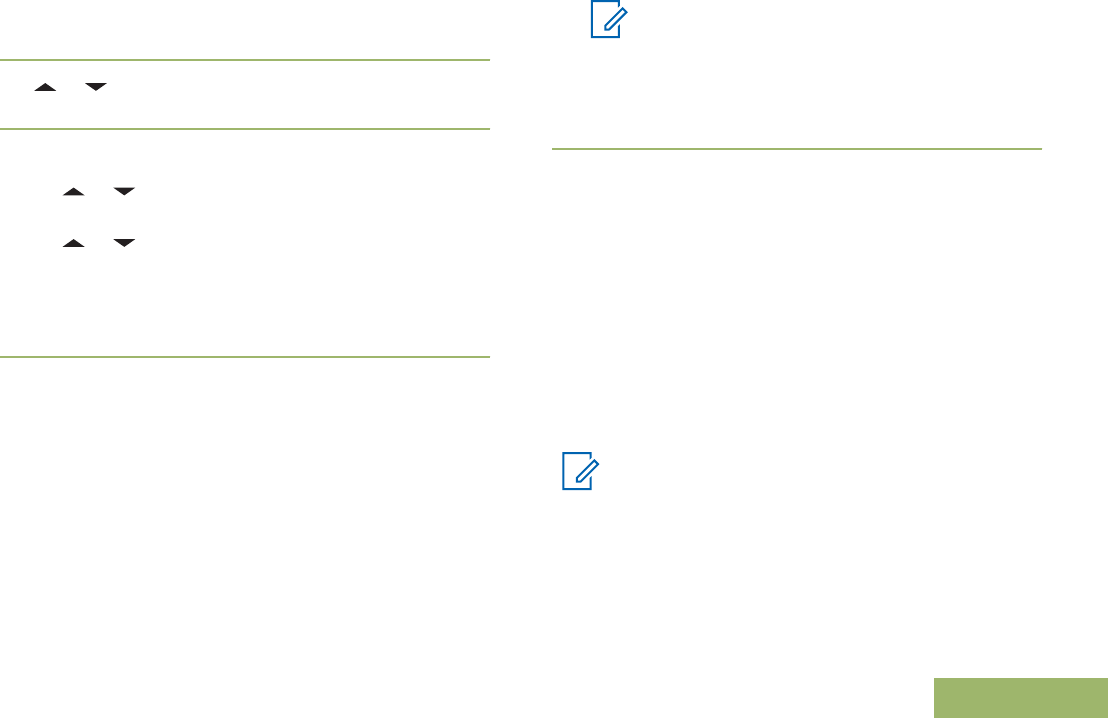
6Press the Menu Select button directly below
Optn.
7 or to Send Message and press the Menu
Select button directly below Sel.
8Perform one of the following actions:
• or to scroll through the address list and
highlight the required address.
• or to [Other Recpnt] and press the
Menu Select button below Edit. When a
blinking cursor appears on the Enter Address
screen. Use the keypad to type the address
entry.
9Press the Menu Select button directly below Send
or press the PTT button to send the message.
The display shows the Send Message screen and
Sending msg.
If the message is sent, you hear a tone and the
display shows Msg sent.
If the message is not sent, you hear a low tone,
the display shows Send failed and returns to the
main TMS screen.
Note:
You can append a priority status and/or a
request reply to your message. See Priority
Status and Request Reply of a New Text
Message on page 101 for more
information.
Priority Status and Request Reply of a New Text
Message
Before sending your message, you can append a
priority status and/or a request reply to your
message.
Appending a Priority Status to a Text Message
Ensure that an outgoing message is composed to
allow you to perform this procedure. See Composing
and Sending a New Text Message on page 99 for
more information.
Note:
The Priority Status icon on a message does
not imply that the message gets higher priority
over the other messages when it is being
transmitted. It is just an indication that can be
embedded into a message to let the receiver
know that the message is important.
Advanced Features
101
English

1Press the Menu Select button directly below
Optn.
2 or to Mark Important and press the Menu
Select button directly below Sel to indicate the
message is important.
The priority status icon appears beside the normal
message icon on the label bar.
Removing a Priority Status from a Text Message
Ensure there is an outgoing message composed to
allow you to perform this procedure. See Composing
and Sending a New Text Message on page 99 for
more information.
1Press the Menu Select button directly below
Optn.
2 or to Mark as Normal and press the Menu
Select button directly below Sel to remove the
priority status from the message.
The display shows the normal message icon on the
label bar.
Appending a Request Reply to a Text Message
Ensure that an outgoing message is composed to
allow you to perform this procedure. See Composing
and Sending a New Text Message on page 99 for
more information
1Press the Menu Select button directly below
Optn.
2 or to Req Reply and press the Menu Select
button directly below Sel to request for a reply.
The request reply icon appears beside the normal
message icon on the label bar.
Removing a Request Reply from a Text Message
Ensure that an outgoing message is composed to
allow you to perform this procedure. See Composing
and Sending a New Text Message on page 99 for
more information.
1Press the Menu Select button directly below
Optn.
2 or to No Req Reply and press the Menu
Select button directly below Sel to remove the
priority status from the message.
Advanced Features
102
English
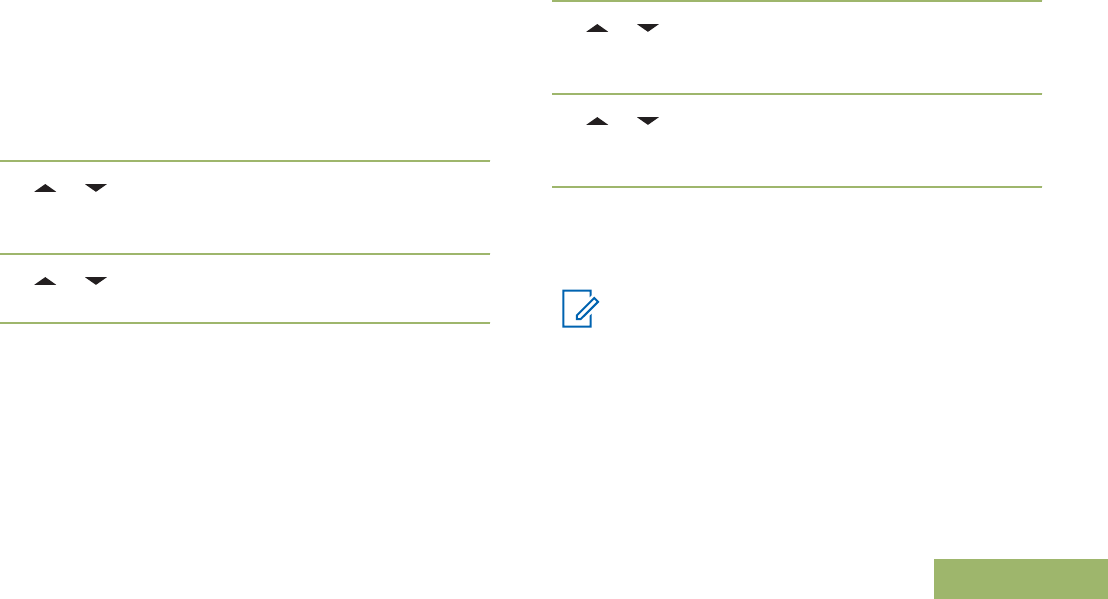
The display shows the normal message icon on the
label bar.
Appending a Priority Status and a Reply Request
to a Text Message
Ensure that an outgoing message is composed to
allow you to perform this procedure. See Composing
and Sending a New Text Message on page 99 for
more information.
1Press the Menu Select button directly below
Optn.
2 or to Mark Important and press the Menu
Select button directly below Sel to indicate the
message is important.
3 or to Req Reply and press the Menu Select
button directly below Sel to request for a reply.
The priority status and request reply icons appear
beside the normal message icon on the label bar.
Removing a Priority Status and a Reply Request
from a Text Message
Ensure that a outgoing message is composed to
allow you to perform this procedure. See Composing
and Sending a New Text Message on page 99 for
more information.
1Press the Menu Select button directly below
Optn.
2 or to Mark Important and press the Menu
Select button directly below Sel to remove the
priority status icon.
3 or to No Req Reply and press the Menu
Select button directly below Sel to remove the
reply status icon.
The display shows the normal message icon on the
label bar.
Receiving a Text Message
Note:
When you receive a message that is flagged
with the “Request Reply” icon, you must
manually respond to the sender that you have
received the message. The system will not
automatically send back a notification that the
radio has received such message.
The following methods are options on how to receive
a text message. The result of all the methods is the
Advanced Features
103
English

same. You can use the options interchangeably
depending on your preference and the programmed
functions.
•Receiving a text message via the Data Feature
button or the TMS Feature button:
a) When you receive a message, press and hold
the preprogrammed Data Feature button or the
TMS Feature button to access the Inbox.
The display shows a list of aliases or IDs, with
the sender of the latest received message on
top.
•Receiving a text message via the radio menu:
a) When the new message icon appears and the
display shows momentary New msg, press the
Menu Select button directly below TMS to
access the Inbox.
The display shows a list of aliases or IDs, with
the sender of the latest received message on
top.
Viewing a Text Message from the Inbox
The Inbox can hold up to thirty (30) messages.
Note:
or to read the message if the content
fills more than one screen.
1Perform one of the following actions:
• Press the preprogrammed Data Feature button
or the TMS Feature button to access the TMS
feature screen. or to Inbox and press the
Menu Select button below Sel.
• Press and hold the preprogrammed Data
Feature button or the TMS Feature button to
access the Inbox.
• or to TMS and press the Menu Select button
directly below TMS to access the TMS feature
screen. or to Inbox and press the Menu
Select button below Sel.
The display shows a list of aliases or IDs, with the
sender of the latest received message on top.
2 or to the required aliases or ID and press
the Menu Select button below Sel to view the
message.
While on the view message screen, press the
Menu Select button directly below Optn, Del, or
Back to access the option.
Advanced Features
104
English

•Select Optn to configure the message settings.
•Select Del to delete the message.
•Select Back to return to the previous screen.
Note:
The icon at the top right corner of the
screen indicates the status of the message.
See Text Messaging Service (TMS)
Indicators on page 45 for more information.
Replying to a Received Text Message
Note:
The original date and time stamp, address and
message content is automatically appended to
the reply message.
1 or to the required aliases or ID and press
the Menu Select button below Sel to view the
message.
2Press the Menu Select button directly below Rply
to reply to a message.
3Perform one of the following actions:
• or to Text Message and press the Menu
Select button directly below Sel.
• or to Quick Text and press the Menu
Select button directly below Sel for a
predefined message.
• or to scroll through the list of messages
and press the Menu Select button directly
below Sel to select the required message.
One of the following scenarios occurs:
•A blinking cursor appears on the Compose
screen.
• The predefined message appears on the
Compose screen, with a blinking cursor at the
end of it.
4Use the keypad to type or edit your message.
5Press the Menu Select button directly below Optn
once you have completed the message.
6 or to Send Message and press the Menu
Select button directly below Sel to send the
message.
The display shows the Send Message screen and
Sending msg.
Advanced Features
105
English

Note:
Press the Menu Select button directly below
Back at any time to return to the previous
screen.
You can append a priority status and/or a
request reply to your message. See Priority
Status and Request Reply of a New Text
Message on page 101 for more information.
Accessing the Drafts Folder
This folder stores the messages that were saved
previously. The Drafts folder can hold up to 10
messages. The oldest draft in the folder is deleted
when the 11th message comes in.
1 or to TMS.
2Press the Menu Select button directly below TMS
to access the TMS feature screen.
3 or to Drafts and press the Menu Select
button below Sel.
The display shows a list of drafts, with the latest
text message drafted on top.
4 or to the required text message and press
the Menu Select button below Sel to view the
message.
Press the Menu Select button directly below
Edit, Del, or Back to access the option.
•Select Edit to edit the message before
sending it.
•Select Del to delete the message.
•Select Back to return to the previous screen.
Sent Text Messages
Once a message is sent to another radio, it is saved
in the Sent folder. The most recent sent text message
is always added to the top of the Sent list.
The Sent folder is capable of storing a maximum of
ten (10) last sent messages. When the folder is full,
the oldest message in the folder is deleted when the
11th message comes in.
Viewing a Sent Text Message
1Perform one of the following actions:
• Press the preprogrammed Data Feature button
or the TMS Feature button to access the TMS
feature screen.
Advanced Features
106
English
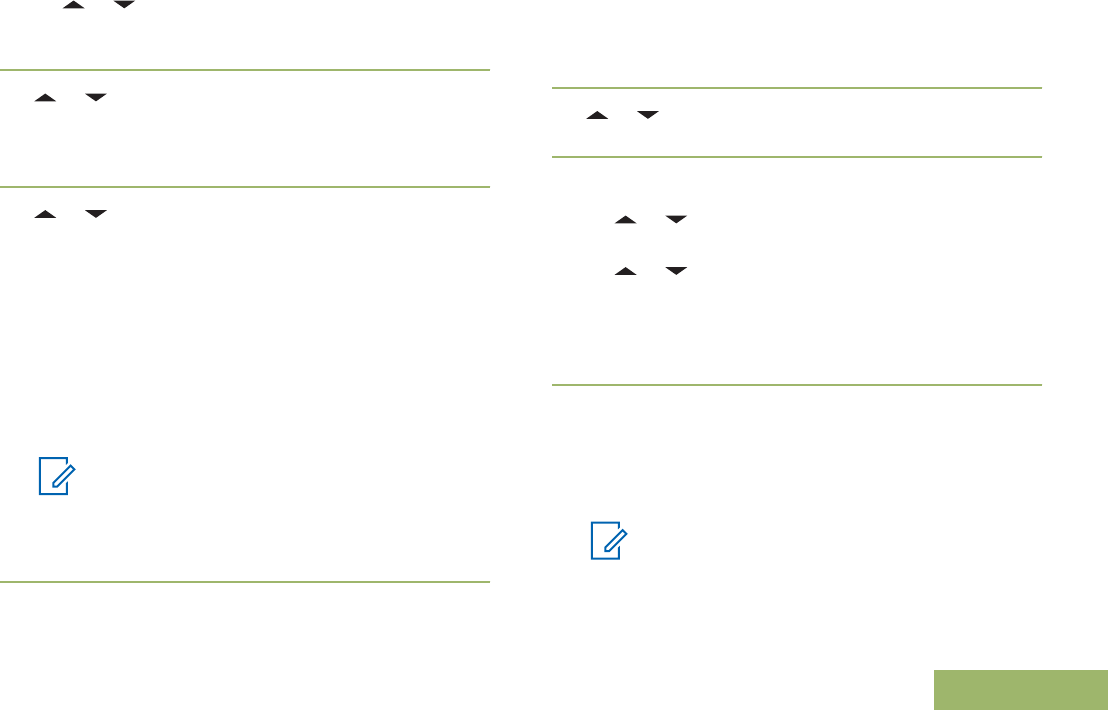
• or to TMS and press the Menu Select
button directly below TMS to access the TMS
feature screen.
2 or to Sent and press the Menu Select
button below Sel.
The display shows a list of aliases or IDs, with the
recipient of latest sent message on top.
3 or to the required aliases or ID and press
the Menu Select button below Sel to view the
message.
While on the view message screen, press the
Menu Select button directly below Optn, Del or
Back to access the option.
•Select Optn to configure the message settings.
•Select Del to delete the message.
•Select Back to return to the previous screen.
Note:
The icon at the top right corner of the
screen indicates the status of the message.
See Text Messaging Service (TMS)
Indicators on page 45 for more information.
Sending a Sent Text Message
1Press the Menu Select button directly below Optn
while viewing the message.
2 or to Send Message and press the Menu
Select button directly below Sel.
3Perform one of the following actions:
• or to scroll through the address list and
highlight the required address.
• or to [Other Recpnt] and press the
Menu Select button below Edit. When a
blinking cursor appears in the Enter Address
screen, use the keypad to type the address
entry.
4Press the Menu Select button below Send or the
PTT button to send the message.
The display shows the Send Message screen and
Sending msg.
Note:
Press the Menu Select button directly
below Back at any time to return to the
previous screen.
Advanced Features
107
English

You can append a priority status and/or a
request reply to your message. See Priority
Status and Request Reply of a New Text
Message on page 101 for more
information.
Deleting a Text Message
1From the Inbox, Draft, or Sent screen, or to
scroll through the messages.
2Press the Menu Select button directly below Del
to delete the current message.
Deleting All Text Messages
1Perform one of the following actions:
• Press the Data Feature button or the
preprogrammed TMS Feature button to access
the Messaging feature screen.
• or to TMS and press the Menu Select button
directly below TMS to access the TMS feature
screen.
2 or to Inbox or Sent then press the Menu
Select button below Clr to select all messages in
the selected folder.
The display shows Del All?.
3Perform one of the following actions:
• Press the Menu Select button directly below
Yes to delete all the messages in the selected
folder.
• Press the Menu Select button directly below
No to return to the main TMS feature screen.
ASTRO 25 Advanced Messaging Solution
The ASTRO 25 Advanced Messaging Solution allows
you to quickly send and receive messages and run
database queries directly from your data-enabled
Motorola two-way radios. Federal mandate requires
Two-Factor Authentication when querying Federal
and State databases. With this advance messaging
solution you have the ability enable Two-Factor
Authentication.
With Query and Two-Factor Authentication, you can
use a secure system logon to initiate and receive key
information on people, vehicles and properties when
doing the regular security patrol. You can access to
local or external databases such as the National
Crime Information Center (NCIC), for "Hot Hits" on
Advanced Features
108
English

priors and warrants. Query and Two-Factor
Authentication has Criminal Justice Information
Services (CJIS) security compliance for queries.
With this Advanced Messaging Solution, ARS
functionality splits between two protocols:
• ARS for Device Registration
• New User Authentication for User Login
TMS functionality splits between two protocols:
• TMS for messaging
• New Service Advertisement for service
availabilities
The radio with Two-Factor capabilities are backward
compatible with the existing device registration
system and TMS servers.
System Setup for ASTRO Advanced Messaging
Solution
Your user name, unit ID and password all need to be
provisioned in PremierOne™. Your user account in
PremierOne needs to be linked to an RSA account
specifying a token to be used with the Two-Factor
passcode.
The radios caches the user name, unit ID and or
Single Factor password in the codeplug, this allows
the radio to automatically log in to use Single Factor
authentication upon power up or mode change. The
Two-Factor passcode is not stored in the codeplug.
You can upgrade the Single Factor session to a Two-
Factor session by entering the Two-Factor passcode
only. After an interruption (for example mode change,
DSR switch over, power loss), the radio is capable of
restoring the active session in its current state as long
as the session is active in the server.
Note:
Power loss and power down are different
activities, power down occurs when the user
intentionally powers off the radio, power loss is
when the battery dies or is removed from the
unit.
Two-Factor Authentication
Two-Factor Authentication is an extension of existing
ARS and TMS operation. This feature allows you to
authenticate yourself with a username, unit ID,
password and passcode.
The purpose of this feature is to allow the sender of a
text message to address a specific user of the radio,
Advanced Features
109
English

so the message is delivered to the user, not to the
radio which may have any user using it at the time.
Secondly, this feature supports query authentication
requirements so the query service knows which user
originated a query.
You can still send text messages without logging in
as a user. The user login feature only enables the
recipient of your message to identify you as the
sender by assigning a username to your message.
Note:
A predefined username that is set more than
the maximum allowed characters is an invalid
name.
Logging in via the Two-Factor Authentication
1Perform one of the following actions:
• Press the preprogrammed User Login button.
• or to User, and press the Menu Select
button directly below User.
The display shows the User Login screen.
2Perform one of the following actions:
• or to [ID Entry] and press the Menu
Select button directly below Edit. A blinking
cursor appears. Use the keypad to type or edit
a username. Press the Menu Select button
directly below Ok to submit.
• or to scroll through the list of predefined
usernames. Press the Menu Select button
directly below Sel to select the predefined
username.
• Press and hold or to scroll through the
list of predefined usernames at a fast scroll
rate. Press the Menu Select button directly
below Sel to select the predefined username.
If the selected predefined username has more
than the maximum allowed characters, or an
invalid character in it, the display shows
momentary Invalid ID.
3For radio enabled with Unit ID, perform one of the
following actions:
• or to [UnitID Entry] and press the
Menu Select button directly below Edit. A
blinking cursor appears. Use the keypad to
type or edit a Unit ID. Press the Menu Select
button directly below Ok to submit.
Advanced Features
110
English

• or to scroll through the list of predefined
Unit IDs. Press the Menu Select button directly
below Sel to select the predefined Unit ID.
• Press and hold or to scroll through the
list of predefined Unit IDs at a fast scroll rate.
Press the Menu Select button directly below
Sel to select the predefined Unit ID.
If the selected predefined Unit ID has more than
the maximum allowed characters, or an invalid
character in it, the display shows momentary
Invalid UnitID.
4Enter your password when you see a blinking
cursor.
5Press the Menu Select button directly below Logn
or Ok.
If only one-factor is enabled, the display shows 1F
logged at the status. The login operation is
complete.
If login fails, the display shows momentary Login
failed. The display returns to User Login
screen.
6For radio enabled with two-factor login, enter your
passcode when you see a blinking cursor.
7Press the Menu Select button directly below
Logn.
The display shows In progress.
If the login fails, the display shows momentary 2F
pscd failed. Press the Menu Select button directly
below Pscd to re-enter passcode. If successful, the
display shows User Login screen with 2F logged
in status to indicate Two-Factor Authentication
complete.
Logging out of Two-Factor Authentication
Note:
Private data refers to all messages in the text
messaging Inbox, Draft, and Sent folder. The
next user is able to access the Inbox, Draft
and Sent messages if private data is not
deleted.
Radio which is successfully logged in to the
secured system receives advertisement from
the server that the access to the data for query
is enabled.
Advanced Features
111
English

1Press the Menu Select button directly below
Logt.
One of the following scenarios occurs:
•The display shows Clear private data?.
• If the Delete Messages On Session End
feature is enabled, the display shows
momentary Private data cleared.
2Select Yes to clear all your private data or select
No to keep your private data.
If you select Yes, the display shows momentary
Private data cleared.
Sending a Query
This feature is available for radio users who have
successfully logged in with the Two-Factor
Authentication. Query is a special form of Quick Text
marked with a flag that is replied or dispatched in
normal TMS message. The query template needs to
be configured in the quick test list of the CPS. You
can choose from the quick text list, including queries
if present.
You shall receive a service advertisement message
to indicate the Query is available after you have
successfully logged in the radio with a Two-Factor
Authentication.
Note:
The query server must be selected as the
destination so that it can receive the query
message and respond the query with text
message. The query server must be an entry
in the data user list in the CPS.
1Perform one of the following actions:
• To access this feature via a preprogrammed
button, press the preprogrammed TMS Query
button and proceed to Step 5.
• To access this feature via the menu, proceed
to the next step.
2 or to TMS and press the Menu Select button
directly below TMS to access the TMS feature
screen.
3Perform one of the following actions:
• or to Compose and press the Menu
Select button directly below Sel.
• Press the Menu Select button directly below
Exit to return to the Home screen.
Advanced Features
112
English
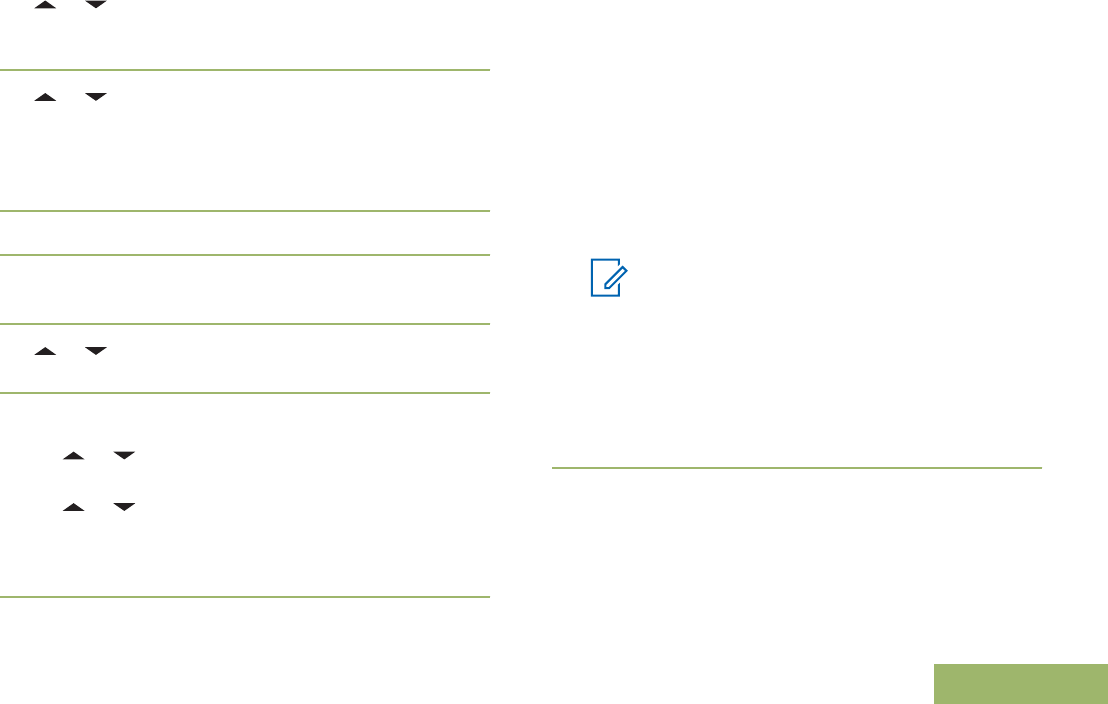
4 or to Query and press the Menu Select
button directly below Sel for a predefined
message.
5 or to scroll through the list of messages and
press the Menu Select button directly below Sel
to select the required message.
The message appears on the Compose screen,
with a blinking cursor at the end of it.
6Use the keypad to edit the message, if required.
7Press the Menu Select button directly below
Optn.
8 or to Send Message and press the Menu
Select button directly below Sel.
9Perform one of the following actions:
• or to scroll through the address list and
highlight the required address.
• or to [Other Recpnt] and press the
Menu Select button below Edit. A blinking
cursor appears on the Enter Address screen.
Use the keypad to type the address entry.
10 Press the Menu Select button below Send or the
PTT button to send the message.
The display shows the Send Message screen and
Sending msg.
If the message is sent, you hear a tone and the
display shows Msg sent.
If the message is not sent, you hear a low tone,
the display shows Send failed and returns to the
main TMS screen.
Note:
The server responds to your query with the
required report in text messages.
You can append a priority status and/or a
request reply to your message. See Priority
Status and Request Reply of a New Text
Message on page 101 for more
information.
Receiving a Query
You shall receive the information you have requested
in TMS format.
When you receive a query, you hear a unique, high-
pitched chirp and the display shows the message
Advanced Features
113
English

icon flagged with “Priority”. The display shows
momentary New msg.
To access the Inbox, press and hold the Data
Feature button or the preprogrammed TMS
Feature button or press the Menu Select button
directly below TMS.
The display shows a list of aliases or IDs, with the
sender of the latest received message on top.
Secure Operations
Secure radio operation provides the highest
commercially available level of voice security on both
trunked and conventional channels.
Unlike other forms of security, Motorola digital
encryption provides signaling that makes it virtually
impossible for others to decode any part of an
encrypted message.
Selecting Secure Transmissions
Turn the preprogrammed Secure/Clear switch to
the secure position.
Note:
If the selected channel is preprogrammed
for clear-only operation, when you press
the PTT button, you hear an invalid mode
tone and the display shows Clear TX
only.
The radio does not transmit until you set
the Secure/Clear switch to the clear
position.
If the “Ignore Secure/Clear Switch when
Strapped” programming option is enabled,
the radio transmits without displaying any
messages in the strapped mode of
operation, regardless of the Secure/Clear
switch setting. This option must be
preprogrammed by a qualified radio
technician.
The Secure/Clear switch only applies
when the radio is transmitting.
Selecting Clear Transmissions
Turn the preprogrammed Secure/Clear switch to
the clear position.
Advanced Features
114
English

Note:
If the selected channel is preprogrammed
for secure-only operation, when you press
the PTT button, you hear an invalid mode
tone and the display shows Secure TX
only.
The radio does not transmit until you set
the Secure/ Clear switch to the secure
position.
You can request to configure the radio to
ignore the clear voice or insecured
transmission when the radio is in secured
transmission. Check with your agent for
details.
If the “Ignore Secure/Clear Switch when
Strapped” programming option is enabled,
the radio transmits without displaying any
messages in the strapped mode of
operation, regardless of the Secure/Clear
switch setting. This option must be
preprogrammed by a qualified radio
technician.
The Secure/Clear switch only applies
when the radio is transmitting.
Managing Encryption
Loading an Encryption Key
Note:
Refer to the key-variable loader (KVL) manual
for equipment connections and setup.
1Attach the KVL to your radio.
The display shows Keyloading, and all other
radio functions, except for power down, backlight,
and volume, are locked out.
2Select the required keys and press the Menu
Select button directly below LOAD on the KVL.
This loads the encryption keys into your radio.
When the key has been loaded successfully, one of
the following scenarios occurs:
• You hear the radio sounds a short tone for single-
key radios.
• You hear the radio sounds an alternating tone for
multikey radios.
The KVL indicates that keyload is successful.
Advanced Features
115
English

Multikey Feature
This feature allows the radio to be equipped with
different encryption keys and supports the DES-OFB
algorithm.
There are two types:
Conventional
Multikey
The encryption keys can be tied
(strapped), on a one-per-channel
basis, through Customer
Programming Software. In addition,
you can have operator-selectable
keys, operator-selectable keysets,
and operator-selectable key
erasure. If talkgroups are enabled
in conventional, then the encryption
keys are strapped to the talkgroups.
Trunked
Multikey
If the radio is used for both
conventional and trunked
applications, strap the encryption
keys for trunking on a per-talkgroup
or announcement-group basis. In
addition, a different key can be
strapped to other features, such as
dynamic regrouping, failsoft, or
emergency talkgroup. You can
have operator-selectable key
erasure.
Selecting an Encryption Key
1 or to Key.
2Press the Menu Select button directly below Key.
The display shows the last user-selected and
stored encryption key, and the available menu
selections.
3 or to scroll through the encryption keys or
use the keypad to enter the number of the desired
key.
4Perform one of the following actions:
• Press the Menu Select button directly below
Sel to save the newly selected key and return
to the Home screen.
•Press , the PTT button, or the Menu Select
button directly below Exit.
• Turn the 16-Position Select knob to exit.
Advanced Features
116
English

Note:
When the selected key is erased, you hear
a momentary keyfail tone and the display
shows Key fail.
When the selected key is not allowed, you
hear a momentary illegal key tone and the
display shows Illegal key.
Selecting a Keyset
This feature allows you to select one or more groups
of several encryption keys from among the available
keys stored in the radio.
For example, you could have a group of three keys
structured to one keyset, and another group of three
different keys structured to another keyset; by
changing keysets, you would automatically switch
from one set of keys to the other.
Every channel to which one of the original keys was
tied now has the equivalent new key instead.
1 or to KSet and press the Menu Select button
directly below KSet.
The display shows the last user-selected and
stored keyset, and the available keyset menu
selections.
2 or to scroll through the keysets or use the
keypad to enter the number of the desired keyset.
3Press the Menu Select button directly below Sel
to save the newly selected keyset.
The radio exits keyset selection and returns to the
Home screen.
Note:
Press , the PTT button, or the Exit
menu selection, or turn the 16-Position
Select knob to exit this menu at any time
without changing the keyset selection.
Erasing the Selected Encryption Keys
This feature allows you to erase all or selected
encryption keys.
The following methods are options on how to erase
the selected encryption keys. The result of all the
methods is the same. You can use the options
interchangeably depending on your preference and
the programmed functions.
Advanced Features
117
English

•Erasing the selected encryption keys via the radio
menu:
a) or to Eras and press the Menu Select
button directly below Eras.
The display shows the last user-selected and
stored encryption key, and the available menu
selections.
b) or to the desired encryption key or use
the keypad to enter the number of the desired
key.
c) Press the Menu Select button directly below
Optn.
The display shows the available key erase
options.
d) or to the required option and press the
Menu Select button directly below Sel.
e) Select Erase all keys? or Erase single
key? by pressing the Menu Select button
below Yes to erase the encryption key(s) in the
radio.
You can return to the previous screen by
pressing the Menu Select button below No.
•Erasing the single key in radios with the single-key
option and erasing all keys in radios with the
multikey option via the preprogrammed Top Side
(Select) button and Top (Orange) button:
a) Press and hold the Top Side (Select) button.
b) While holding Top Side (Select) button down,
press the Top (Orange) button.
The display shows Please wait. When all the
encryption keys have been erased, the display
shows All keys erased.
Note:
Do not press the Top (Orange) button
before pressing the Top Side (Select)
button, unless you are in an emergency
situation as this sends an emergency
alarm.
Requesting an Over-the-Air Rekey (ASTRO
Conventional Only)
Ensure that the Unique Shadow Key (USK) is loaded
into the radio with the key-variable loader (KVL)
before the rekey request can be sent. Refer to your
local key management supervisor for more
information.
This feature, also known as OTAR, allows the
dispatcher to reprogram the encryption keys in the
radio remotely. The dispatcher performs the rekey
Advanced Features
118
English

operation upon receiving a rekey request from the
user.
1 or to Reky.
2Press the Menu Select button directly below
Reky.
3Perform one of the following actions:
• Press the PTT button to send the rekey
request.
•Press the PTT button again, or the or
Emergency button, to exit the feature and
transmit in normal mode.
If the rekey operation fails, you hear a bad-key
tone and the display shows Rekey fail.
Note:
The rekey operation failure indicates that
your radio does not contain the Unique
Shadow Key (USK).
MDC Over-the-Air Rekeying (OTAR) Page
This feature allows you to view or define MDC Over-
the-Air Rekeying (OTAR) features. It is applied only
when operating in secure encrypted mode and only
for conventional communications. In additional to
Rekey Requests, OTAR transmissions include
Delayed Acknowledgements, and Power-up
Acknowledgements.
Some of the options selected may also need to be set
up at the Key Management Controller (KMC) site to
work properly.
Note:
This feature must be preprogrammed by a
qualified radio technician. Check with your
dealer or system administrator for more
information.
Infinite UKEK Retention
This feature enables Unique Key Encryption Key
(UKEK) to be permanently stored in the radio even
when all of the encryption keys is erased. Without this
UKEK key, the radio could not be over the air
rekeyed.
Note:
This feature must be preprogrammed by a
qualified radio technician. Check with your
dealer or system administrator for more
information.
Advanced Features
119
English

Hear Clear
Note:
This feature must be preprogrammed by a
qualified radio technician. Check with your
dealer or system administrator for more
information.
There are two components of Hear Clear.
Companding Reduces the channel noise, e.g.
OTA transmission, that is
predominantly present in UHF2 and
900 MHz channel with the following
features.
Compressor Reduces the
background noise
flow and the speech
signal at
transmitting radio.
Expander Expands the speech
while the noise flow
remains the same at
receiving radio.
Random FM
Noise
Canceller
(Flutter
Fighter)
Reduces the unwanted effects of
random FM noise pulses caused by
channel fading under high Signal-to-
Noise (S/N) conditions such as in a
moving transportation. The fading
effects, heard as audio pops and
clicks, are cancelled without
affecting the desired audio signal.
The Random FM Noise Canceller
operates only in receive mode.
Security
Radio Lock
This feature changes your radio to a more robust
security system that protects the use of the secure
encryption keys.
If this feature is enabled in your radio by a qualified
radio technician, when you turn the radio on, the
display shows Radio locked.
Unlocking Your Radio
1Enter your numeric password.
Secure-equipped radios – 6 to 8 characters.
Advanced Features
120
English

Clear radios – 0 to 8 characters.
2Perform one of the following actions:
• Press the Menu Select button directly below
Sel to enter the code.
• Press the Menu Select button directly below
Del to delete any unwanted characters.
• Press the Menu Select button directly below
Cncl to exit the feature.
If the password is correct, the radio unlocks.
If the password is incorrect, the display show
Incorrect password and the radio remains
locked.
If you enter three incorrect passwords in a row, the
display shows Deadlock. Turn the radio off and
then on, and begin again at Step 1.
Important:
For Secure Radios Only – After a total of
17 consecutive incorrect passwords
(turning the radio off and on does not reset
this number), the radio erases all of its
encryption keys and shows Deadlock. See
a qualified radio technician.
If you forget the password, enter ******** to
erase all keys and revert the password in
the radio back to the default password of
01234567.
Changing Your Password
1 or to Pswd.
2Press the Menu Select button directly below
Pswd.
The display shows Change Password screen.
3 or to Unlock Pswd.
4Press the Menu Select button directly below Sel.
5Enter the old password.
6Press the Menu Select button directly below Ok.
7Enter the new password.
8Press the Menu Select button directly below Sel.
9Re-enter the new password.
10 Press the Menu Select button directly below Sel.
Advanced Features
121
English
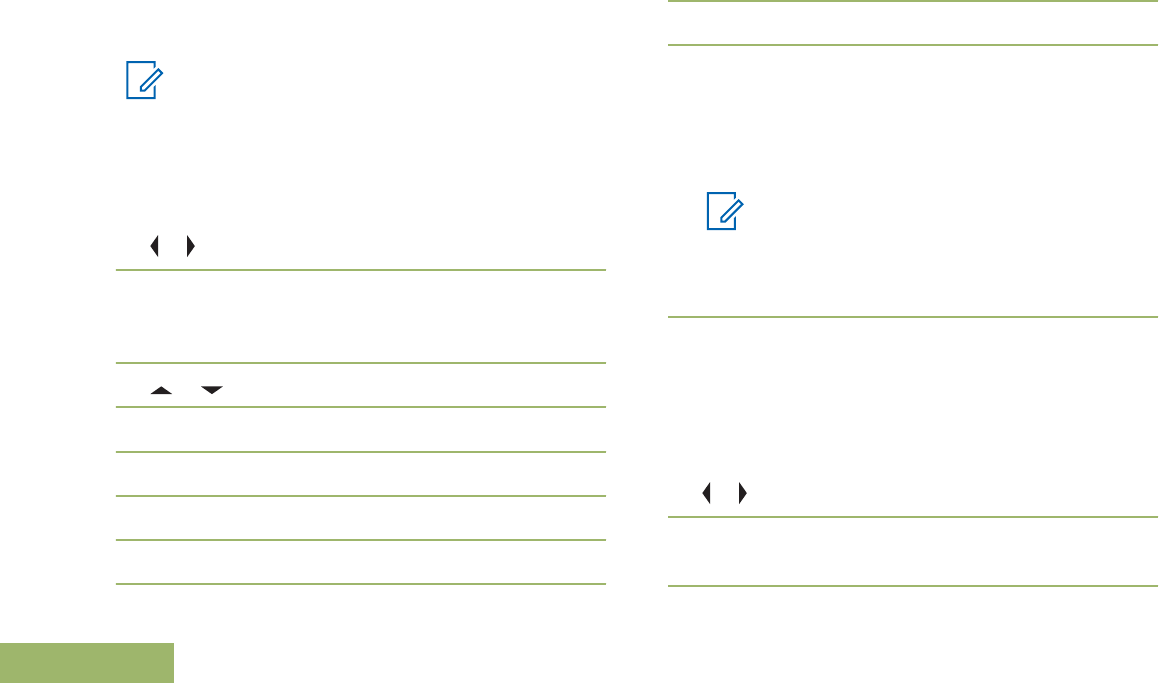
The password is updated.
If the two passwords do not match, repeat Steps 5
through 10.
Note:
If you enter three incorrect old passwords, the
radio exits the password feature. You cannot
access this feature again until you turn the
radio off and on.
Changing Your Tactical Inhibit Password
1 or to Pswd.
2Press the Menu Select button directly below
Pswd.
The display shows Change Password screen.
3 or to Tactical Inh Encode Pswd.
4Press the Menu Select button directly below Sel.
5Enter the old password.
6Press the Menu Select button directly below Ok.
7Enter the new password.
8Press the Menu Select button directly below Sel.
9Re-enter the new password.
10 Press the Menu Select button directly below Sel.
The password is updated.
If the two passwords do not match, repeat Steps 5
through 10.
Note:
If you enter three incorrect old passwords,
the radio exits the password feature. You
cannot access this feature again until you
turn the radio off and on.
Enabling or Disabling the Radio Lock Feature
(Secure Radios Only)
This feature allows you to enable or disable the radio
lock feature. It is programmable by a qualified radio
technician.
1 or to Logf.
2Press the Menu Select button directly below
Logf.
Advanced Features
122
English

One of the following results occur.:
•The display shows Pswd enabled, indicating that
the radio lock feature is enabled.
•The display shows Pswd disabled, indicating that
the radio lock feature is disabled.
Radio Stun and Kill
Radio Stun
This feature allows you to stun another radio by
sending an over the air command using the menu on
your radio. This feature prevents an unauthorized
user from using the radio. Once the radio is stunned,
a password is required to re-activate the stunned
radio.
Using Radio Stun
1 or to Stun.
2Press the Menu Select button directly below
Stun.
The display shows Enter Password.
3Use the keypad to enter your Tactical Inhibit
Encode Password.
4Press the Menu Select button directly below Ok.
The display shows radio Contact IDs.
5Perform one of the following actions:
• or to the required ID.
• Press the Menu Select button directly below
LNum to go to the last number dialed.
• Use the keypad to enter the required ID.
• Press the Menu Select button directly below
Send to initiate command.
If the receiving radio does not have encryption key
to decrypt the received command, your radio
display shows Ack received.
If the receiving radio does not have encryption key
to decrypt the received encrypted command, your
radio display shows Decrypt failed.
If the receiving radio is powered off, your radio
display shows No Acknowledgement.
Once the receiving radio received the command, its
screen locked and request for password.
Note:
To un-stun a radio, follow the procedure in
Unlocking Your Radio on page 120.
Advanced Features
123
English

Radio Kill
This feature allows you to render your radio or
another radio inoperable if the radio is misplaced or
lost. When a radio is killed, the display turns blank
and all functions of the radio are not usable.
The killed radio can only be recovered from KILL with
a special device. Consult an authorized and qualified
technician for details.
Using Remote Kill to Kill Another Radio
Remote Kill allows you to render another radio
inoperable by sending an over the air command using
the menu on your radio.
1 or to Kill.
2Press the Menu Select button directly below
Kill.
The display shows Enter Password.
3Use the keypad to enter your Tactical Inhibit
Encode Password.
4Press the Menu Select button directly below Ok.
The display shows radio Contact IDs.
5Perform one of the following actions:
• or to the required ID.
• Press the Menu Select button directly below
LNum to go to the last number dialed.
• Use the keypad to enter the required ID.
• Press the Menu Select button directly below
Send to initiate command.
If the receiving radio received the command, your
radio display shows Ack received.
If the receiving radio does not have encryption key
to decrypt the received encrypted command, your
radio display shows Decrypt failed.
If the receiving radio is powered off or already
killed, your radio display shows No
Acknowledgement.
Once the receiving radio received the command, its
screen turns blank, the killed radio is inoperable.
Using Direct Kill to Kill Your Own Radio
Direct Kill allows you to make your own radio
inoperable.
Advanced Features
124
English

Press and hold the Top Side button then press
the Orange button until the display turns blank
and becomes inoperable.
Global Positioning System / Global
Navigation Satellite System
The Global Navigation Satellite System (GNSS) in the
radio uses information from the Global Positioning
System (GPS) to determine the approximate
geographical location of your radio. The geographical
location is expressed as latitude and longitude or
Military Grid Reference System (MGRS) format per
request from customers.
Note:
This feature is addressed as GPS across the
manual as the naming convention of the
buttons and strings remain the same as the
legacy feature of GPS.
The availability and accuracy of this location
information (and the amount of time that it takes to
calculate it) varies depending on the environment in
which you are using the GPS feature.
For example, GPS location fixes are difficult to obtain
indoors, in covered locations, between high buildings,
or in situations where you have not established a
clear broad view of the sky.
Once GPS is enabled, the radio displays the GPS
icon on the screen. The dispatcher can always
request the system to determine the real-time location
coordinates of the radio.
GPS Operation
The GPS technology uses radio signals from earth
orbiting satellites, to establish the location
coordinates, maximizing your view of clear
unobstructed sky is essential for optimum
performance.
Where adequate signals from multiple satellites are
not available (usually because you cannot establish a
view of a wide area of the sky), the GPS feature of
your radio will not work. Such situations include but
are not limited to:
• Underground locations
• Inside of buildings, trains, or other covered
vehicles
• Under any other metal or concrete roof or
structure
• Between tall buildings or under dense tree-cover
Advanced Features
125
English

• In temperature extremes outside the operating
limits of your radio
Even where location information can be calculated in
such situations, it may take longer to do so, and your
location estimate may not be as accurate. Therefore,
in any emergency situation, always report your
location to your dispatcher.
Keep in mind that the accuracy of the location
information and the time it takes to obtain it varies
depending upon circumstances, particularly the ability
to receive signals from an adequate number of
satellites.
Note:
Even where adequate signals from multiple
satellites are available, your GPS feature only
provides an approximate location, usually
within 10 meters from your actual location, but
sometimes farther away.
The satellites used by the GPS feature are controlled
by the U.S. government and are subject to changes
implemented in accordance with the Department of
Defense GPS user policy and the Federal Radio
Navigation Plan. These changes may affect the
performance of the GPS feature on your radio.
GPS Performance Enhancement
Sometimes, the GPS feature may be unable to
complete a location calculation successfully. You then
see a message indicating that your radio cannot
connect to enough visible satellites.
To maximize the ability of your radio to determine a
fix, take note of the following guidelines:
• For your initial fix, hold the radio in the face
position.
• Stay in the open. The GPS feature works best
where there is nothing between your radio and a
large amount of open sky.
The Outdoor Location Feature (Using GPS)
This feature allows you to determine your current
location using a location menu, as well as your
current distance and bearing in relation to another
location. Radio location may be requested and
reported over-the-air.
Your radio stores up to a maximum of sixty (60)
programmable location coordinates, also known as
waypoints. When the memory is full, the next
waypoints automatically replaces the oldest
waypoints in the radio.
Advanced Features
126
English
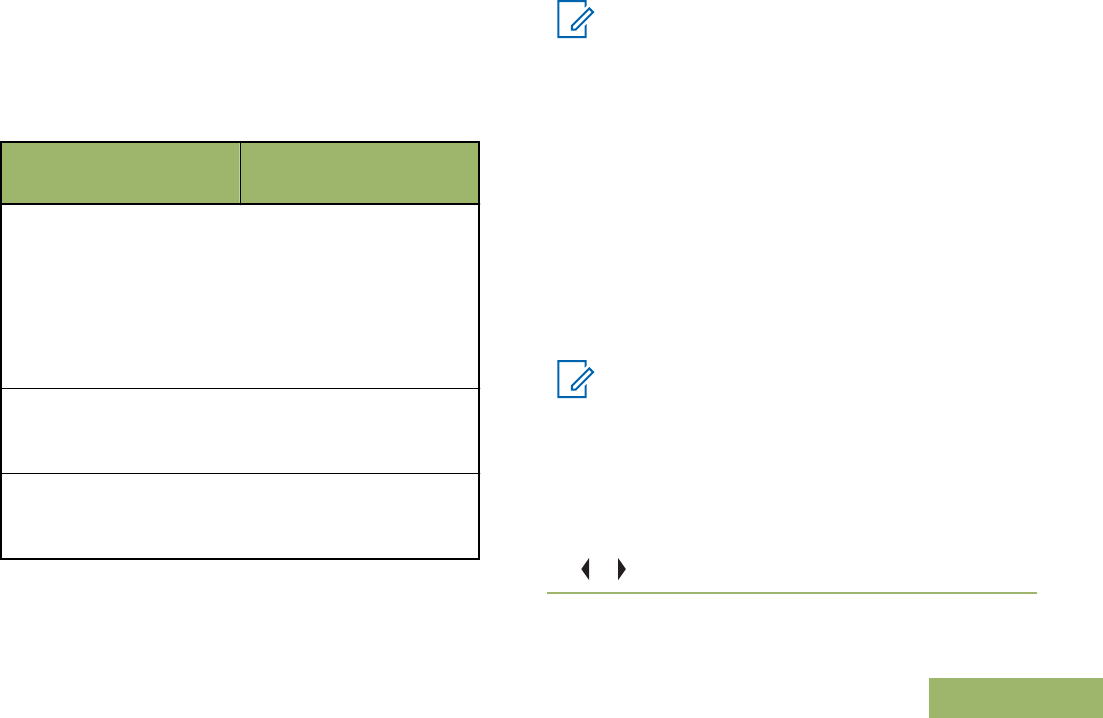
The radio also stores four (4) preprogrammed
waypoints. These coordinates cannot be deleted.
The following table shows the differences between
programmable waypoints and preprogrammed
waypoints.
Programmable Way-
points
Preprogrammed Way-
points
User-configurable loca-
tion coordinates.
Fixed location coordi-
nates:
• Home
• Emergency
• Last Known Location
• Destination
Only the alias is editable,
not the coordinates.
The Home and Destina-
tion coordinates are edit-
able.
Coordinates can be de-
leted one at a time, or all
at once.
Coordinates cannot be
deleted.
Note:
The radio automatically exits the feature, if the
feature inactivity timer is enabled, when the
radio is left idle and the timer expires. You
hear the Menu Inactive Exit Tone upon feature
exit.
Military Grid Reference System (MGRS) Coordinates
This feature can only be enabled through CPS
configuration. When the MGRS coordinate is
enabled, all location coordinates are displayed in
MGRS format, including the editable locations in
GPS.
Accessing the Outdoor Location Feature
Note:
An ON radio menu may be present on the
Location menu screen if it is preprogrammed
by the dealer or system administrator.
Press the preprogrammed GPS button to toggle the
Outdoor Location feature to on or follow the following
procedure to access this feature via the radio menu.
1 or to Loc.
2Press the Menu Select button directly below Loc.
Advanced Features
127
English

The display shows Location off.
3Perform one of the following actions:
• To obtain a location fix, press the Menu Select
button directly below On .
• Press the Menu Select button directly below
Optn. or to Turn On GPS and press the
Menu Select button directly below Sel.
The front display shows the MGRS or latitude/
longitude location, time, and date of the last
successful location fix.
4To obtain a new location fix, press the Menu
Select button directly below Rfsh.
The top line temporarily displays Please wait
while the new location is being determined. While
the new location is being determined, the location
signal can be a solid or blinking icon.
Once the location coordinates are fixed, the
display shows the current location along with the
UTC (Zulu) time and date that the location fix was
obtained.
The location coordinates are updated
automatically every 5 seconds while the location
signal is present.
If the radio fails to get a location fix, the display
shows No service and returns to the previous
display.
5To return to the Home screen, press , the PTT
button, the preprogrammed GPS button or the
Menu Select button directly below Exit.
Saving a Waypoint
Ensure that your radio shows the current location on
the screen.
1Press the Menu Select button directly below
Optn.
2Perform one of the following actions:
• or to Save as Waypt and press the
Menu Select button directly below Sel.
• or to Save as Home and press the Menu
Select button directly below Sel and proceed
to step 5.
• or to Save as Dest. and press the
Menu Select button directly below Sel and
proceed to step 5.
A blinking cursor appears in the screen.
Advanced Features
128
English

3Use the keypad to edit the auto-generated
waypoint, if required, or press the Menu Select
button directly below Cncl to return to the Location
main screen.
4Press the Menu Select button directly below Ok
once you are done.
One of the following scenarios occur:
•The display shows Current loc saved as
<Waypoint name>.
•The display shows Current loc saved as
[Home].
•The display shows Current loc saved as
[Destination].
5To return to the Home screen, press , the PTT
button, the preprogrammed GPS button or the
Menu Select button directly below Exit.
Viewing a Saved Waypoint
Ensure your radio shows the current location on the
screen.
1Press the Menu Select button directly below
Optn.
2 or to Waypoints and press the Menu Select
button directly below Sel.
The display shows a list of waypoints.
3Perform one of the following actions:
• or to scroll through the list.
• or to select a waypoint to view the
location information in full.
4Press the Menu Select button directly below
Optn.
5To view the MGRS or latitude/longitude location,
time and date of the selected waypoint, or to
View and press the Menu Select button directly
below Sel.
6To return to the previous screen, press the Menu
Select button directly below Back, or to return to
the Home screen, press , the PTT button, or the
preprogrammed GPS button.
Editing the Alias of a Waypoint
Ensure your radio shows the current location on the
screen.
Advanced Features
129
English
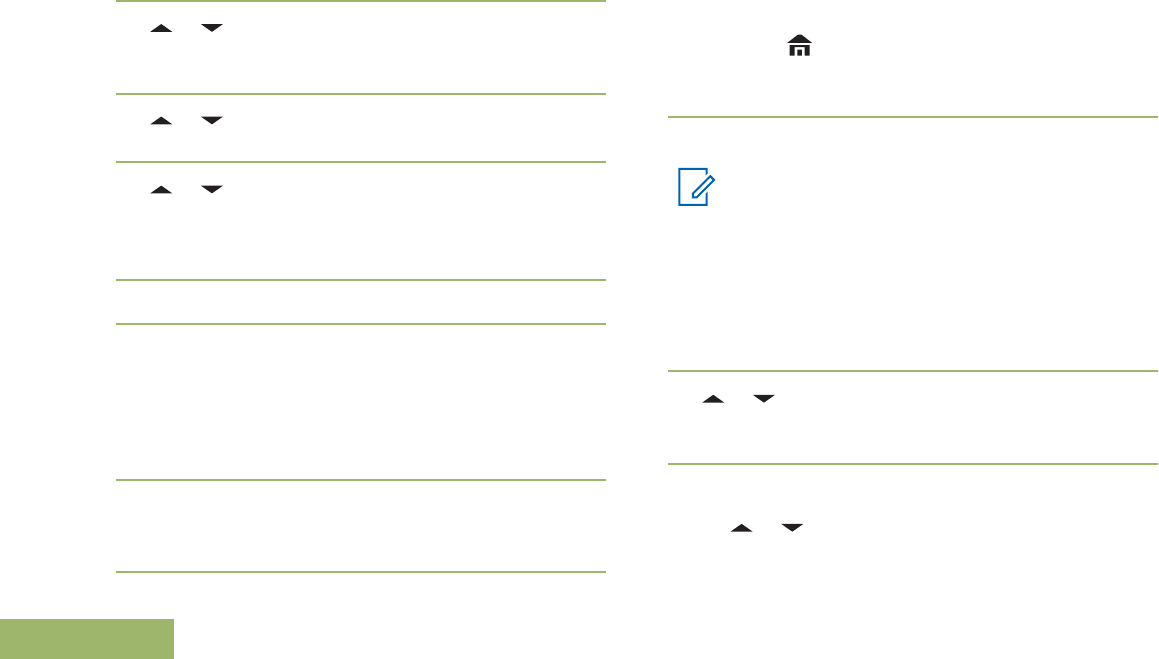
1Press the Menu Select button directly below
Optn.
2 or to Waypoints and press the Menu Select
button directly below Sel.
The display shows a list of waypoints.
3 or to the required saved waypoint, and press
the Menu Select button directly below Optn.
4 or to Edit name and press the Menu Select
button directly below Sel.
A blinking cursor appears in the Edit Name
screen.
5Use the keypad to edit the alias.
6Perform one of the following actions:
• Press the Menu Select button directly below
Ok once you are done.
• Press the Menu Select button directly below
Cncl to return to the Waypoints main screen.
7The display shows <Waypoint name> Updated
and the radio returns to the Waypoints main
screen.
8Perform one of the following actions:
• Press the Menu Select button directly below
Back to return to the previous screen.
•Press , the PTT button, or the
preprogrammed GPS button to return to the
Home screen.
Editing the Coordinates of a Waypoint
Note:
Only the preprogrammed coordinates of Home
and Destination can be edited by the user.
Ensure your radio shows the current location on the
screen.
1Press the Menu Select button directly below
Optn.
2 or to Waypoints and press the Menu Select
button directly below Sel.
The display shows a list of waypoints.
3Perform one of the following actions:
• or to [Home] and press the Menu Select
button directly below Optn.
Advanced Features
130
English

• or to [Destination] and press the
Menu Select button directly below Optn.
4 or to Edit location and press the Menu
Select button directly below Sel.
The first number blinks.
5Utilize the following control buttons to select the
number/coordinates if required, then press the
Menu Select button directly below Edit to change
the number/coordinates.
•Press to move to the previous number/
coordinates.
•Press to move to the next number/
coordinates.
A blinking cursor appears in the Edit Location
screen.
6Utilize the following control buttons or menu to
change the number/coordinates if required then
press the Menu Select button directly below Ok
once.
•Press to move one space to the left.
•Press to move one space to the right.
• Press the Menu Select button directly below
Del to delete any unwanted characters.
• Press the Menu Select button directly below
Cncl to return to the previous screen
7Press the Menu Select button directly below Ok
once complete setting up the new Home or
Destination.
One of the following scenarios occurs:
•The display shows [Home] Updated and the
radio returns to the Waypoints main screen.
•The display shows [Destination] Updated
and the radio returns to the Waypoints main
screen.
Deleting a Single Saved Waypoint
Ensure your radio shows the current location on the
screen.
1Press the Menu Select button directly below
Optn.
2 or to Waypoints and press the Menu Select
button directly below Sel.
The display shows a list of waypoints.
Advanced Features
131
English

3Perform one of the following actions:
• or to the required saved waypoint, and
press the Menu Select button directly below
Optn. or to Edit name and press the
Menu Select button directly below Del.
• Press the Menu Select button directly below
Del.
4The display shows Delete <Waypoint name>
Confirm?.
5Press the Menu Select button directly below Yes
to delete the waypoint or press the Menu Select
button directly below No to return to the Waypoints
main screen.
The display shows <Waypoint name>deleted .
Deleting All Saved Waypoints
Ensure your radio shows the current location on the
screen.
Note:
You cannot delete any of the preprogrammed
waypoints.
1Press the Menu Select button directly below
Optn.
2 or to Waypoints and press the Menu Select
button directly below Sel.
The display shows a list of waypoints.
3 or to the required saved waypoint, and press
the Menu Select button directly below Optn.
4 or to Delete All and press the Menu
Select button directly below Sel.
The display shows Delete All saved waypnts
Confirm?.
5Press the Menu Select button directly below Yes
to delete all waypoints or press the Menu Select
button directly below No to return to the Waypoints
main screen.
The display shows All saved waypnts deleted.
Measuring the Distance and Bearing from a Saved
Waypoint
Ensure your radio shows the current location on the
screen.
Advanced Features
132
English

1Press the Menu Select button directly below
Optn.
2 or to Dist frm here and press the Menu
Select button directly below Sel.
The display shows a list of waypoints.
3 or to the required waypoint and press the
Menu Select button directly below Sel.
The display shows the distance and bearing from the
current to the selected coordinates.
Location Feature in Emergency Mode
When the Emergency feature is activated by pressing
the emergency button, the radio exits the Location
menu and returns to the Home (default) screen so
that you can see which channel the emergency signal
is going out on.
However, you may re-enter the Location menu while
still in emergency mode, provided that Silent
Emergency has not been activated.
If you have turned Location off using the ON/OFF
menu key, it automatically turns back on when
Emergency is activated.
If there is a solid location signal during Emergency,
the current location and the location information
received is saved as Emergency and Last Known
Location waypoints, respectively.
Peer-Location on the Display (ASTRO Conventional
only)
This feature is only available for radio-to-radio voice
transmissions, dispatch call and selective call in
conventional ASTRO system. For radio-to-radio
transmission, in order to allow the radio to show peer-
location, the voice should be directly sent from one
radio to another radio without passing through any
infrastructure facility such as repeaters, phone or
DVRS system. Both the transmitting radio and
receiving radio must be configured to enable them to
send and/or receive the GPS coordinates. You can
check with your nearest qualified technician for more
details.
Note:
If the receiving radio is operating in a Mixed
Mode channel, only if its voice transmission is
via conventional ASTRO system then it can
receive the location coordinates of its peers.
This feature is also operable in a Scan Active channel
or Scan Talkback channel.
Advanced Features
133
English

Upon receiving a voice transmission with GPS
coordinates enabled on the receiving radio, the
display shows the coordinates available in full or in
short coordinates. There are two different formats
available. Refer to the following list for the details
shown in the Peer-Location quick text. Consult your
agent to pick the best format to configure to your
radio.
Full location
coordinates • PTT ID (This is optional.)
• Longitude and latitude
• Relative distance or
direction.
Short location
coordinates • PTT ID (This is optional.)
• Longitude and latitude
Note:
If the transmitting radio is stale at its location
after a period of time, the receiving radio
display shows ID:<PTT ID> Last Knwn
Loc: <Coordinates>. The ID:<PTT ID> and
<distance> are optional details depending on
the requirements of usage.
If the transmitting radio does not have GPS or
the receiving radio could not decode the GPS
signal of the received signal, the receiving
radio display shows ID:<PTT ID> Unknown
Loc. The PTT ID is optional to be shown on
the display per requirements of usage.
Geofence (ASTRO 25 Trunking System)
Geofence is a virtual perimeter based on the GPS to
define a geographical area on earth.
When the radio enters the predefined Geofence area,
your radio receives the Dynamic Regroup command
from the system and immediately connects to a
Dynamic Regroup talkgroup. The radio display shows
the new selected Dynamic Regrouped talkgroup with
green intelligent light for your attention.
On top of that, additional features are Voice
Announcement of the new channel, and also direct
content display of a text message to indicate that you
are currently at Geofence area. Check with your
nearest qualified technician on the requirements for
these enhancements to work in Geofence.
Advanced Features
134
English

Any new text messages received at Geofence shall
have its content displayed immediately on the radio
display.
Note:
If the radio is set up in DVRS, only mobile
radio is supported for this feature.
Entering the Geofence Area
The Voice Announcement and TMS display in this
feature are optional. They must be configured to
enable you to hear and see these indicators.
When the radio enters a Geofence area, the radio
immediately sends a message ACK back to the
system.
The radio searches the current zone for the channel
with same talkgroup assigned as the Dynamic
Talkgroup and also with same system ID of current
trunk system. Once matched, the radio display shows
the first matched and connected channel alias.
If there is no channel with matched Talkgroup ID and
trunk system ID, the radio display shows the channel
alias of <DYNAMIC talkgroup>.
Once the radio is connected, you hear a dynamic
regroup tone, the radio display shows <DYNAMIC
channel> with temporary green color intelligent
backlight and you hear a Voice Announcement.
Note:
When the radio loss the GPS signal the GPS
icon blinks and the radio sounds two high-
pitched tones repetitively to indicate GPS fails
to operate. The radio display shows red
intelligent light.
Note:
If the first matched channel is not configured
with Voice Announcement, no Voice
Announcement is played.
The system sends a message to your radio. The
radio display shows a direct text message content
without any user operation. This message indicates
you are currently present in a Geofence area. This
TMS remains open on the display until user presses
exit/home to exit this screen.
Note:
If there is another incoming text message
before you exit the previous message, the
message screen shall be refreshed to show
the latest message.
Advanced Features
135
English

The following procedure guides you to exit the text
message received.
Press the Menu Select button below Exit or
to return to Home screen.
The other operations are the same as normal
dynamic regroup command.
When the radio exits the Geofence area, your radio
reverts to original channel or newly assigned
talkgroup. The radio display shows the new channel
together with Voice Announcement to indicate the
changes. Voice Announcement of the new channel
only works if that channel is configured with Voice
Announcement.
Trunking System Controls
Operating in Failsoft System
The failsoft system ensures continuous radio
communications during a trunked system failure. If a
trunking system fails completely, the radio goes into
failsoft operation and automatically switches to its
failsoft channel.
During failsoft operation, your radio transmits and
receives in conventional operation on a
predetermined frequency. You hear a medium-
pitched tone and the display shows Failsoft.
When the trunking system returns to normal
operation, your radio automatically leaves failsoft
operation and returns to trunked operation.
To continue, in Failsoft, to communicate with other
talkgroups, refer to the following procedure.
1Rotate the Mode Knob to change to a different
repeater frequency.
2Press the PTT button to talk, and release the
button to listen.
Out-of-Range Radio
When your radio goes out of the range of the system,
it can no longer lock onto a control channel.
You hear a low-pitched tone and/or the display shows
the currently selected zone/channel combination and
Out of range. Your radio remains in this out-of-
range condition until it locks onto a control channel, it
locks onto a failsoft channel, or it is turned off.
Advanced Features
136
English

Site Trunking Feature
If the zone controller loses communication with any
site, that site reverts to site trunking.
The display shows the currently selected zone/
channel combination and Site trunking.
Note:
When this occurs, you can communicate only
with other radios within your trunking site.
Locking and Unlocking a Site
This feature allows your radio to lock onto a specific
site and not roam among wide-area talkgroup sites.
This feature should be used with caution, since it
inhibits roaming to another site in a wide-area
system.
You can toggle the lock state between locked and
unlocked by pressing the preprogrammed Site Lock/
Unlock button.
Follow the following procedure to lock and unlock a
site via the radio menu.
1 or to Site.
2Press the Menu Select button directly below
Site.
3Perform one of the following actions:
• To lock the site, press the Menu Select button
directly below Lock. The display shows Site
locked.
• To unlock the site, press the Menu Select
button directly below Unlk. The display shows
Site unlocked.
The radio saves the new site lock state and returns to
the Home screen.
Site Display and Search Button
The Site Display and Site Search button allows you
to view the name of the current site or force your
radio to change to a new one.
Viewing the Current Site
Perform one of the following actions:
• Press the preprogrammed Site Displ/Srch
button.
Advanced Features
137
English

• or to RSSI and press the Menu Select
button directly below RSSI.
The display shows momentary the name of the
current site and its corresponding received signal
strength indicator (RSSI).
Changing the Current Site
Perform one of the following actions:
• Press and hold down the preprogrammed Site
Displ/Srch button.
• Press and hold down the Menu Select button
directly below RSSI.
You hear a tone and the display shows
momentary Scanning site.
When the radio finds a new site, it returns to the
Home screen.
Mission Critical Wireless - Bluetooth®-
This feature allows your radio to extend its
functionality by connecting to external proprietary
Motorola accessories.
Note:
It is recommended to use Motorola proprietary
Mission Critical Wireless (MCW) devices with
APX radios during Mission Critical operations
as other Bluetooth® devices may or may not
meet the mission critical standard.
Your radio must be preprogrammed to allow
you to use this feature.
The use of this feature requires the "Full
Feature" expansion board together with the
Bluetooth Software.
The default setting for Bluetooth-enabled radio is
Bluetooth on. See Turning Off the Bluetooth on page
139 to turn off the Bluetooth.
Currently your radio supports the following Bluetooth
devices or profiles.
• Headset (HSP)
• Dial Up Networking (DUN)
• Personal Area Networking (PAN)
• Serial Port (SPP)
Advanced Features
138
English

Turning On Bluetooth
The following methods are options on how to turn on
the Bluetooth. The result of all the methods is the
same. You can use the options interchangeably
depending on your preference and the programmed
functions.
•Turning on the Bluetooth via the radio menu BT:
a) or to BT. To access the Bluetooth feature
screen, press the Menu Select button directly
below BT.
b) or to Status and press the Menu Select
button directly below On.
The display shows Status On, and
appears.
If Bluetooth fails to launch, the display shows
Bluetooth on failed.
c) To return to the Home screen, press the Menu
Select button directly below Exit.
•Turning on the Bluetooth via the preprogrammed
button:
a) Press the preprogrammed button to turn on the
Bluetooth.
You hear a short, medium-pitched tone. The
display shows momentary Bluetooth on, and
appears.
If Bluetooth fails to launch, the display shows
Bluetooth on failed.
Turning Off the Bluetooth
The following methods are options on how to turn off
the Bluetooth. The result of all the methods is the
same. You can use the options interchangeably
depending on your preference and the programmed
functions.
•Turning off the Bluetooth via the radio menu BT:
a) or to BT. To access the Bluetooth feature
screen, press the Menu Select button directly
below BT.
b) or to Status and press the Menu Select
button directly below Off.
The display shows Status Off, and
disappears.
c) To return to the Home screen, press the Menu
Select button directly below Exit.
Advanced Features
139
English

•Turning off the Bluetooth via the preprogrammed
button:
a) Press the preprogrammed button to turn off the
Bluetooth.
You hear a short, medium-pitched tone. The
display shows momentary Bluetooth off and
disappears.
Re-Pair Timer
There are two options for configuring the Bluetooth
pairing type of the radio. The type defines the
duration the radio and the accessory retain the
pairing information.
Immediate (For MCW accessories only.) When the
radio and/or device is turned off after
pairing, the keys are lost. Due to this,
when your radio and your device are
turned on again, they are unable to re-
connect. The user must re-pair the
devices to re-establish a new set of
pairing keys. See Pairing with Low
Frequency-Motorola Proximity Pairing
(LF-MPP) Feature on page 142 and
Standard Pairing Feature on page 143.
Infinite (For all Bluetooth devices.) When the
radio and/or device are turned off after
pairing, keys are not lost. When the
radio and the device are turned on
again, they can resume the Bluetooth
connection without user intervention.
Re-Pair Tim-
er Options
Re-Pair Timer Scenarios
Immediate
(For MCW Ac-
cessories on-
ly)
• When the radio is powered off,
pairing key is lost immediately,
and accessory attempts to pair
again. If pairing is unsuccessful
within the Drop Timer value, the
accessory automatically powers
off.
• When the accessory is powered
off, all keys are lost immediately,
and the user must re-pair the de-
vices.
• When the device loses Bluetooth
connection, the device will at-
tempt to re-establish Bluetooth
Connection within the Drop Tim-
er value.
Advanced Features
140
English

Re-Pair Tim-
er Options
Re-Pair Timer Scenarios
Infinite (For all
Bluetooth de-
vices)
• When the radio is powered off,
the accessory attempts to re-es-
tablish the Bluetooth Connection
for a period of time depending
upon the Drop Timer value. If the
device fails to reconnect within
the period, the accessory then
powers off.
Bluetooth Drop Timer
The Bluetooth Drop Timer has two different settings
and functions, depending upon the selection of the
Re-Pair Timer.
Re-Pair Timer
Options
Description
Immediate
(For MCW Ac-
cessories only)
0 – 15 minutes programmable buf-
fer time to re-establish the Blue-
tooth Connection when the Blue-
tooth signal is out of range.
Re-Pair Timer
Options
Description
If either device powers off, the pair-
ing keys are immediately cleared
from both devices and the devices
must re-pair.
Infinite (For all
Bluetooth devi-
ces)
This Timer only applies to the ac-
cessory. The programmable timer
choices are: 0 – 15 minutes, 2
hours, 4 hours or 8 hours.
Do note there are exceptions for
Operation Critical Wireless (OCW)
headset and PTT which are pre-
programmed to 8 hours.
This timer is a "stay alive" timer
where the accessory remains on
without the device reconnecting be-
fore powering off. The radio re-
mains on until the user powers off
the radio. The radio and accessory
remains paired indefinitely. Once
the device re-connect, the timer is
reset.
Advanced Features
141
English

The radio could not control the Drop Timer of
Personal Area Networking (PAN), Dial-Up Networking
(DUN), Commercial Off- The-Shelf (COTS) and data
services. It depends on the specifications of these
external devices.
Check with your dealer or system administrator for
more information about these timers.
To establish the Bluetooth Connection, see Pairing
with Low Frequency-Motorola Proximity Pairing (LF-
MPP) Feature on page 142 or Standard Pairing
Feature on page 143 .
Pairing with Low Frequency-Motorola Proximity Pairing
(LF-MPP) Feature
Ensure that Bluetooth feature of your radio is on and
the Bluetooth tones are enabled.
Bluetooth tones, Bluetooth menu and preprogrammed
buttons must be preprogrammed by a qualified radio
technician. Check with your dealer or system
administrator for more information.
The range of Bluetooth operation when using a MCW
accessory is 10 meters line-of-sight communication.
This is an unobstructed path between the location of
the signal transmitter (your radio) and the location of
the receiver (your device or accessory).
Obstacles that can cause an obstruction in the line-of-
sight include trees, buildings, mountains, cars and
etc.
It is not recommended that you leave your radio
behind and expect your accessory to work with a high
degree of reliability when they are separated.
At the fringe areas of reception, both voice and tone
quality will start to sound "garbled" or "broken". To
correct this problem, simply position the accessory
and radio closer to each other (within the 10 meter
defined range) to re-establish clear audio reception.
Note:
Once a COTS headset is paired to your radio,
it is always connected. Therefore the battery
life of the accessory is aligned with the Talk
Time power consumption, not the Standby
Time consumption.
Turn on the accessory. Then, place it close to the
radio aligning the Bluetooth Pairing Location (a
blue dot) on the radio to the Bluetooth Pairing
Location (a blue dot) on the accessory.
If the pairing process is successful, you hear an
incremental-pitched tone. The radio begins to
connect to the device.
Advanced Features
142
English
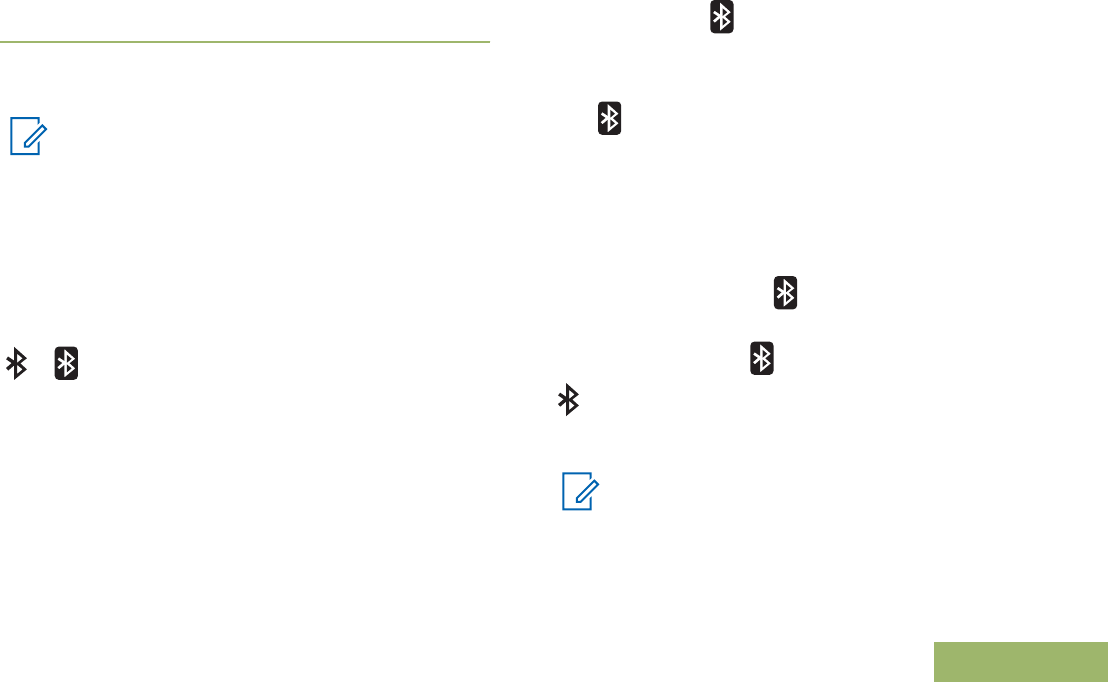
If the pairing process fails, you hear a short, low-
pitched tone. The display shows Bluetooth
pairing failed. Repeat this step.
The radio tries to establish connection with the device
once paired.
Note:
If the connection fails within 6 seconds, you
hear a decremental-pitched tone to indicate
that the device is unpaired. The display shows
<Device Type> unpaired. Repeat this step
to re-initiate the pairing process.
If the connection is successful, you hear an
incremental-pitched tone. The display shows <Device
Type> connected and the Bluetooth icon turns from
to .
If the radio has the pairing record of the device and
the connection fails, you hear a short, low-pitched
tone. The display shows <Device Type> connect
failed.
Radio Indications of Lost Bluetooth Connection
The radio shows when the device has a Bluetooth
connection. Below is the scenario and radio
indications when the connection is interrupted.
The starts blinking for up to 10 seconds. You hear
a decremental-pitched tone. The display shows
<Device Type> alternating with disconnected.
If the Bluetooth device successfully re-connects
before the Bluetooth 10 second Re-Connection Timer
expires, the display shows momentary <Device
Type> connected, and stops blinking, or if the
Bluetooth device fails to re-connect within 10
seconds, the blinking is replaced by a persistent
.
Standard Pairing Feature
Note:
Bluetooth tones, Bluetooth menu and
preprogrammed buttons must be
preprogrammed by a qualified radio
Advanced Features
143
English

technician. Check with your dealer or system
administrator for more information.
Once a COTS headset is paired to your radio,
it is always connected. Therefore the battery
life of the accessory is aligned with the Talk
time power consumption, not the Standby time
consumption.
The Bluetooth Standard Pairing feature enables your
Bluetooth enabled radio to search for other Bluetooth
enabled and discoverable device. Once the device is
discovered, you can initiate your radio to send a
pairing request to pair with the device.
This feature also enables your Bluetooth enabled
radio to be visible to another Bluetooth enabled
device and receive request to pair from other device.
The Standard Pairing feature supports pairing
Authentication Personal Pairing Number or PIN which
ensure your radio recognizes the correct device to
pair. The PIN must be exchanged with the radio or
the device before the pairing completes. Your radio
prompts for the Authentication PIN when needed.
Refer to your device’s manual for details about the
Bluetooth Authentication PIN of your device if
needed.
Searching and Pairing the Bluetooth Device
Ensure the Bluetooth on your device is turned on and
is set to Discoverable in order to enable your radio to
detect your device in Bluetooth.
Bluetooth Search in Bluetooth Standard Pairing
method is used to scan for other Bluetooth devices
nearby. It is set to off by default.
1Perform one of the following actions:
• Press the preprogrammed Bluetooth Search
button .
• or to BT. Press the Menu Select button
directly below BT to access the Bluetooth
feature screen. or to Search Devices
and press the Menu Select button directly
below On.
If successful, the display shows Searching for
BT devices followed by the names of Bluetooth
devices found, if any. When the search timer
expires, Available Dev screen shows a list of
Bluetooth devices found. To stop the search
before the search timer expires, press the
preprogrammed Bluetooth Search button or the
Menu Select button below Stop.
Advanced Features
144
English

If the feature fails to initiate, the radio sounds a
short, low-pitched tone. The screen shows BT
Search failed. Press the Menu Select button
below Back to return to Bluetooth feature screen,
or press or the Menu Select button below
Exit to return to Home screen.
2 or to the device name and press the Menu
Select button directly below Sel to connect to the
device.
The radio starts pairing to the device.
To continue with Bluetooth pairing, see Pairing with
Low Frequency-Motorola Proximity Pairing (LF-MPP)
Feature on page 142.
Turning On Bluetooth Visibility
Turning Bluetooth visibility to on enables other
Bluetooth devices to search for your radio. The
visibility of the Bluetooth is set to off by default.
The following methods are options on how to turn on
Bluetooth visibility. The result of all the methods is the
same. You can use the options interchangeably
depending on your preference and the programmed
functions.
•Turn on Bluetooth visibility via radio menu BT:
a) or to BT. Press the Menu Select button
directly below BT to access the Bluetooth
feature screen.
b) or to Visibility and press the Menu
Select button directly below On.
The status changes to Visible to all.
Visibility mode is enabled.
When the timer expires, the status changes to
Visibility failed. Repeat the procedure to
turn on Bluetooth visibility.
•Turn on Bluetooth visibility via the preprogrammed
button.
a) Press the preprogrammed button to enable the
Bluetooth visibility feature.
You hear a short, medium-pitched tone. The
display shows momentary Visible to all.
Visibility mode is enabled.
When the timer expires, the display shows
momentary Visibility failed. Repeat the
procedure to turn on Bluetooth visibility.
Note:
Press the preprogrammed button to
toggle the Bluetooth visibility on or off.
Advanced Features
145
English

Receiving Pairing Request from other Devices
When your radio receives a pairing request from
other device, the display shows <Device Friendly
Name>pair request.
Press the Menu Select button below Ok to accept
or Cncl to refuse pairing request.
Turning Off Bluetooth Visibility
Ensure that Bluetooth Visibility is turned on.
The following methods are options on how to turn off
Bluetooth visibility. The result of all the methods is the
same. You can use the options interchangeably
depending on your preference and the programmed
functions.
•Turn off Bluetooth visibility via radio menu BT:
a) or to BT. Press the Menu Select button
directly below BT to access the Bluetooth
feature screen.
b) or to Visibility and press the Menu
Select button directly below Off.
The display shows Visibility Off.
When the timer expires, the status changes to
Visibility off failed. Repeat this step to
turn off Bluetooth visibility.
c) To return to the Home screen, press the Menu
Select button directly below Exit.
•To disable the Bluetooth visibility, press the
preprogrammed button.
You hear a short, medium-pitched tone. The
display shows momentary Visibility Off.
Visibility mode is disabled.
When the timer expires, the status changes to
Visibility off failed. Repeat this step to
turn off Bluetooth visibility.
PIN Authentication in Pairing
For the security of your radio, Bluetooth Pairing PIN
feature is designed to enable your radio to verify the
correct device to pair before initiating the pairing.
Authentic PIN is used for the verification.
Note:
The compare PIN authentication method is
only applicable for Bluetooth version 2.1 and
above.
Advanced Features
146
English

Pairing the Authentication PIN when Receiving a
Pairing Request
1When the radio display shows <Device Friendly
Name> pair request, perform one of the
following actions:
• To accept, press the Menu Select button
below Ok.
• To reject, press the Menu Select button below
Cncl
Your radio only supports HSP, DUN, PAN and
SPP Bluetooth profiles.
When the pairing timer expires, the display shows
<Device Friendly Name> pair canceled and
return to Home screen.
If you choose to accept the pairing process, the
display shows Compare PIN: XXXXXX.
If you choose to reject the pairing process, the
display shows Cancel pairing in
progress... followed by <Device Friendly
Name> pair canceled and return to Home
screen.
2Perform one of the following actions when the
display shows Compare PIN: XXXXXX.:
•Press the Menu Select button below Ok if the
PIN is correct.
•Press the Menu Select button below Cncl to
reject if the PIN number is incorrect. The
display shows Cancel pairing in
progress... followed by <Device Friendly
Name> pair canceled and return to Home
screen.
When the PIN authentication timer expires, the
display shows <Device Friendly Name>pair
canceled and return to Home screen.
If successful, the display shows Pairing in
progress...., <Device Friendly Name>
paired followed by <Device Friendly
Name>connected.
If unsuccessful, one of the following scenarios will
occur:
•The display shows <Device Friendly Name>
pair failed (if the pairing timer expires).
Advanced Features
147
English

•The display shows <Device Friendly Name>
connect failed (if the connecting timer
expires).
If the PIN is correct but the profiles are not
supported, the display shows BT profiles not
supported. The display returns to Home screen.
Pairing the Authentication PIN with the Generated
Numeric PIN
Follow the procedure inSearching and Pairing the
Bluetooth Device on page 144 to search for available
Bluetooth devices. Start pairing with the
Authentication PIN by following the steps described
next.
1 or to the required device. Press the Menu
Select button directly below Sel to initiate pairing.
Your radio only supports HSP, DUN, PAN and
SPP Bluetooth profiles.
If successful, the display shows Pairing in
progress... followed by a randomly generated
numeric PIN, Compare PIN: XXXXXX.
If unsuccessful, the display shows BT profiles
not supported. The display returns to Available
Dev screen.
2Press Ok to continue pairing the radio and the
device.
The pairing process can be canceled by pressing
the Menu Select button below Cncl.
If successful, the display shows Pairing in
progress,<Device Friendly Name> paired,
Connecting in progress... followed by
<Device Friendly Name>connected. The
display returns to the Bluetooth feature screen.
If unsuccessful, one of the following scenarios will
occur:
•The display shows <Device Friendly Name>
pair failed (if the PIN numbers are
different).
•<Device Friendly Name> connect failed
(if the connection fails).
The display returns to Available Dev screen.
Advanced Features
148
English

Pairing the Authentication PIN by Manually
Keying in the Same PIN
Follow the procedure in Searching and Pairing the
Bluetooth Device on page 144 to search for available
Bluetooth devices. Start pairing with the
Authentication PIN by following the steps described
next.
1 or to the required device. Press the Menu
Select button directly below Sel to initiate pairing.
Your radio only supports HSP, DUN, PAN and
SPP Bluetooth profiles.
If successful, the display shows Pairing in
progress... followed by a request for PIN
number. A blinking cursor appears below the
Enter PIN:.
If unsuccessful, the display shows BT profiles
not supported. The display returns to Available
Dev screen.
2Use the keypad to enter the PIN. Press to move
one space to the left. Press to move one space
to the right. Press the Menu Select button directly
below Del to delete.
3Press Ok to continue pairing the radio and the
device. Enter the same PIN number on the device.
The pairing process can be canceled by pressing
the Menu Select button below Cncl.
If successful, the display shows Pairing in
progress,<Device Friendly Name> paired,
Connecting in progress... followed by
<Device Friendly Name>connected. The
display returns to the Bluetooth feature screen.
If unsuccessful, one of the following scenarios will
occur:
•The display shows <Device Friendly Name>
PIN auth fail (if the PIN numbers are
different).
•<Device Friendly Name> connect failed
(if the connection fails).
The display returns to Available Dev screen.
Turning On the Bluetooth Audio (Routing the Audio
from the Radio to the Headset)
The following methods are options on how to turn on
the Bluetooth audio. The result of all the methods is
the same. You can use the options interchangeably
Advanced Features
149
English

depending on your preference and the programmed
functions.
•Turning on the Bluetooth audio via radio menu BT:
a) or to BT. Press the Menu Select button
directly below BT to access the Bluetooth
feature screen.
b) or to Bluetooth spkr and press the
Menu Select button directly below On.
The display shows On.
c) To return to the Home screen, press the Menu
Select button directly below Exit.
•Turning on the Bluetooth audio via the
preprogrammed button:
a) To route the audio routing from the radio to the
headset, short press the preprogrammed
button.
You hear a short, medium-pitched tone. The
display shows Headset on.
Turning Off the Bluetooth Audio (Routing the Audio
from the Headset to the Radio)
The following methods are options on how to turn off
the Bluetooth Audio. The result of all the methods is
the same. You can use the options interchangeably
depending on your preference and the programmed
functions.
•Turning off the Bluetooth audio via radio menu BT:
a) or to BT. Press the Menu Select button
directly below BT to access the Bluetooth
feature screen.
b) or to Bluetooth spkr and press the
Menu Select button directly below Off.
The display shows Off.
c) To return to the Home screen, press the Menu
Select button directly below Exit.
•Turning off the Bluetooth audio via the
preprogrammed button:
a) To route the audio routing from the headset to
the radio, press the preprogrammed button.
You hear a short, medium-pitched tone. The
display shows Speaker on.
Adjusting the Volume of the Radio from Bluetooth
Audio Device
Ensure that the Bluetooth audio device is connected
to the radio.
Advanced Features
150
English

Your radio can only control the volume of MCW and
OCW Bluetooth enabled audio device. If the radio is
paired with other Bluetooth enabled audio device, its
volume is independent from the APX radio. In this
case, the volume is only adjustable on the device.
Adjust volume up/down on the Bluetooth audio
device.
The radio display shows Volume XX, and you hear
a short, medium-pitched tone.
Viewing and Clearing the Bluetooth Device Information
1 or to BT. Press the Menu Select button directly
below BT to access the Bluetooth feature screen.
2 or to Devices.
Once the display highlights the Devices, the
display shows XX connected alternates with XX
paired.
3Press the Menu Select button directly below Sel.
4If there are devices being paired or connected,
or along the list of <Device Friendly Name>
to see the status of each device.
If there are no active Bluetooth devices being
paired or connected, the display shows No
devices.
5Perform one of the following actions:
• To clear the device from the list, or to the
required device, press the Menu Select button
directly below Clr.
• To exit from this function, press the Menu
Select button directly below Back to return to
the previous screen without deleting the device
name.
If Clr is selected, the display shows <Device
Friendly Name> clear?.
6Press the Menu Select button directly below Yes
or No to proceed delete the device or to exit this
function and return to previous screen..
If the device is deleted successfully, the display
shows <Devlice Friendly Name> cleared to
indicate clearing is successful.
If the device is not deleted successfully, you hear the
radio sounds a short, low-pitched tone. The display
Advanced Features
151
English

shows <Devlice Friendly Name> clear failed.
The display returns to previous screen.
Note:
If Re-Pair Timer is set to infinite and you clear
keys on the radio, you must clear keys on all
previously paired devices as well. (Please see
your accessories manual for further details.)
Clearing All Bluetooth Devices Information
The following methods are options on how to clear all
Bluetooth devices information. The result of all the
methods is the same. You can use the options
interchangeably depending on your preference and
the programmed functions.
•Clearing all Bluetooth devices information via the
preprogrammed Bluetooth On/Off button:
a) Long press the preprogrammed Bluetooth
On/Off button.
You hear a short, medium-pitched tone. The
display shows Please wait to indicate
clearing is in progress.
If successful, the display shows All BT
devices cleared.
If unsuccessful, you hear the radio sounds a
short, low-pitched tone. The display shows
Clear all BT devices failed. The display
returns to Bluetooth feature screen.
•Clearing all Bluetooth devices information via the
radio menu Clr:
a) or to Devices and press the Menu
Select button directly below Clr.
You hear a short, medium-pitched tone. The
display shows Clear all BT devices?.
b) Press the Menu Select button directly below
Yes to proceed.
The display shows Please wait to indicate
clearing is in progress.
If successful, the display shows All BT
devices cleared.
If unsuccessful, you hear the radio sounds a
short, low-pitched tone. The display shows
Clear all BT devices failed. The display
returns to Bluetooth feature screen.
Note:
If Re-Pair Timer is set to infinite and you clear
keys on the radio, you must clear keys on all
Advanced Features
152
English

previously paired devices as well. (Please see
your accessories manual for further details.)
Editing the Bluetooth Friendly Name
Your radio must be preprogrammed to allow you to
use this feature.
1 or to BT. Press the Menu Select button directly
below BT to access the Bluetooth feature screen.
2 or to Friendly name and press the Menu
Select button directly below Edit.
A blinking cursor appears in the Friendly Name
screen.
3Use the keypad to edit the text.
4Perform one of the following actions:
• Press the Menu Select button directly below
Ok to save the new Friendly Name and return
to the Bluetooth feature screen.
• Press the Menu Select button directly below
Cncl to return to the Bluetooth feature screen.
Over-the-Air Programming (POP 25, ASTRO
25, ASTRO Conventional)
This feature enables configuration data and firmware
to be upgraded to your radio over-the-air. Full use of
the radio is retained during the data transfer without
interrupting communication. For ASTRO 25 and
ASTRO Conventional, the upgrade pauses to give
priorities to voice call, and continues after the voice
call ended. For Wi-Fi®, the upgrade process runs
concurrently with voice calls.
Once a configuration upgrade is downloaded to your
radio, you can install new changes immediately or
delay changes to be installed on the radio when it is
being powered up.
Your radio can also be configured to allow you to
accept or reject an upgrade.
Note:
This feature must be preprogrammed by a
qualified radio technician. Check with your
dealer or system administrator for more
information.
Advanced Features
153
English

Responding to the Notification of Upgrade
1The display shows Upgrade? and two short,
medium- pitched tones sounds every 30 seconds
until the user makes a choice of accepting,
delaying, or rejecting the request
2Perform one of the following actions:
•Press the Menu Select button below Acpt to
accept the request to upgrade immediately.
•Press the Menu Select button below Dlay to
delay the request to upgrade.
•Press the Menu Select button below Rej to
reject the request to upgrade.
One of the following scenarios occurs:
• If you choose to accept, the display shows
Programming Dont power off to indicate the
upgrade is about to begin. The radio resets to
install the upgrade. In the case of configuration
data upgrade, this process only takes a few
seconds. In the case of firmware upgrade, the
installation takes several minutes.
Note:
The radio cannot be used while the
upgrade is being installed. Therefore, make
sure to only accept the upgrade at a
convenient time when immediate radio use
is not required.
• If you choose to delay, a configuration data
upgrade is installed automatically at the next
power up. However, in the case of a firmware
upgrade, the radio prompts Upgrade? again at the
next power up.
•If you choose to reject, the display shows Upg
Aborted. The radio continues to function with the
current configuration until it gets reprogrammed.
Note:
If your radio has problems upgrading over-the-
air, consult a qualified technician for details.
Voice Announcement
This feature enables the radio to audibly indicate the
current feature mode, zone or channel the user has
just assigned. This audio indicator can be customized
per customer requirements. This is typically useful
when the user is in a difficult condition to read the
content shown on the display.
Advanced Features
154
English

Each voice announcement is within a limit of three
seconds maximum. The sum duration of all different
voice announcements in a radio shall be no more
than 1000 seconds.
Note:
This feature must be preprogrammed by a
qualified radio technician.
Check with your agent if Voice Announcement
is available for the feature you need.
The two options of priority for the Voice
Announcement available are:
High Enables the voice of the feature to announce
even when the radio is receiving calls.
Low Disables the voice of the feature from
announcing when the radio is receiving calls.
You hear a voice announcement when the features
below are preprogrammed in the radio.
• The radio powers up. The radio announces the
current zone and channel it is transmitting.
• Press the preprogrammed voice announcement
button (which specifically programmed to playback
the current zone and channel). The radio
announces the current zone and channel it is
transmitting.
Note:
Pressing this preprogrammed playback
button enables the voice feature to
announce in High priority.
All the three programmable buttons at the
side of the radio support this feature.
• Change to a new zone. The radio announces the
current zone and channel it is transmitting.
• Change to a new channel remaining within the
current zone. The radio announces the current
channel.
• Press either the Menu Select button or
preprogrammed button or switch of the radio to
launch or terminate Scan, PL Disabled,
Talkaround/Direct or Transmit Inhibit. The radio
announces the corresponding feature activation or
deactivation.
Site Selectable Alerts (ASTRO 25)
A Site Selectable Alert (SSA) is an Intelligent Lighting
indicator together with audio alert sent to radios at a
site or a few sites to notify the users when there is a
Advanced Features
155
English

special situation that they need to be aware of. Only
authorized radios are enabled to send SSA.
Upon the activation of a SSA, the receiving radios
display the alert alias and generate the periodic alert
tone.
Note:
Alert alias, alert tone, and alert period can be
preprogrammed. Alert period is the duration
for the radio to repeat the alert tone. An
interval of 5 seconds might impact the battery
life of the radio. Check with your dealer or
system administrator for more details.
When mixing SSA with received voice audio,
the SSA alert is reduced in volume to ensure
that the voice message is still heard clearly.
Therefore, it is important that the SSA audio
files are created with clear loud audio to
ensure they can still be heard clearly when
played at reduced levels.
Sending SSA Notification to Single Site
1 or to SSA.
2Press the Menu Select button directly below SSA.
The display shows the Site Alert screen.
3 or to Start Alert and press the Menu
Select button directly below Sel.
The display shows the Select Site screen.
4 or to the desired Site Alias. Press the Menu
Select button directly below Sel.
The display shows the Select Alert screen.
5 or to select the desired Alert Alias and press
the Menu Select button directly below Send.
The display shows Sending req.
If radio is out of range, roaming to a foreign
system or in a failsoft situation, the display shows
Req failed.
If the request is successful, the display shows Req
successful.
If the site is not available, the display shows <Site
Alias> not available.
If the site does not exist, the display shows <Site
Alias> does not exist.
6To return to the Home screen, press the Menu
Select button directly below Exit.
Advanced Features
156
English

If you are at the site designated to receive this alert,
you can hear an alert tone repeated periodically. The
display shows the <Alert Alias> with the intelligent
lighting at Home screen.
Sending SSA Notification to Single Site Via Manual
Entry
1 or to SSA.
2Press the Menu Select button directly below SSA.
The display shows the Site Alert screen.
3 or to Start Alert and press the Menu
Select button directly below Sel.
The display shows the Select Site screen.
4 or to [SiteID Entry] to send alert via
manual entry. Press the Menu Select button
directly below Edit.
The display shows the Enter SiteID screen.
5Key in the desired Site ID and press the Menu
Select button directly below Ok.
If a correct Site ID is entered, the display shows
the Select Alert screen.
If a wrong Site ID is entered, the display shows
Invalid ID and prompts to enter the Site ID
again.
6 or to select the desired Alert Alias and press
the Menu Select button directly below Send.
The display shows Sending req.
If radio is out of range, roaming to a foreign
system or in a failsoft situation, the display shows
Req failed.
If the request is successful, the display shows Req
successful.
If the site is not available, the display shows <Site
ID> not available.
If the site does not exist, the display shows <Site
ID>does not exist.
7To return to the Home screen, press the Menu
Select button directly below Exit.
If you are at the site designated to receive this alert,
you can hear an alert tone repeated periodically. The
display shows the <Alert Alias> with the intelligent
lighting at Home screen.
Advanced Features
157
English

Sending SSA Notification to All Sites
1 or to SSA.
2Press the Menu Select button directly below SSA.
The display shows the Site Alert screen.
3 or to Start Alert and press the Menu
Select button directly below Sel.
The display shows the Select Site screen.
4 or to [All Sites] and press the Menu
Select button directly below Sel.
The display shows the Select Alert screen.
5 or to select the desired Alert Alias and press
the Menu Select button directly below Send.
The display shows Sending req.
If radio is out of range, roaming to a foreign
system or in a failsoft situation, the display shows
Req failed.
If the request is successful, the display shows Req
successful.
If one or more sites are not available, the display
shows Not all sites available. Repeat 3.
6To return to the Home screen, press the Menu
Select button directly below Exit.
If you are at the site designated to receive this alert,
you can hear an alert tone repeated periodically. The
display shows the <Alert Alias> with the intelligent
lighting at Home screen.
Sending SSA Notification to All Available Sites
1 or to SSA.
2Press the Menu Select button directly below SSA.
The display shows the Site Alert screen.
3 or to Start Alert and press the Menu
Select button directly below Sel.
The display shows the Select Site screen.
4 or to [All Avail] and press the Menu
Select button directly below Sel.
The display shows the Select Alert screen.
5 or to select the desired Alert Alias and press
the Menu Select button directly below Send.
The display shows Sending req.
Advanced Features
158
English

If radio is out of range, roaming to a foreign
system or in a failsoft situation, the display shows
Req failed.
If the request is successful, the display shows Req
successful.
6To return to the Home screen, press the Menu
Select button directly below Exit.
If you are at the site designated to receive this alert,
you can hear an alert tone repeated periodically. The
display shows the <Alert Alias> with the intelligent
lighting at Home screen.
Stopping SSA Notification of a Single Site
1 or to SSA.
2Press the Menu Select button directly below SSA.
The display shows the Site Alert screen.
3 or to Stop Alert and press the Menu
Select button directly below Sel.
The display shows the Select Site screen.
4 or to select the desired Site Alias and press
the Menu Select button directly below Send.
The display shows Sending req.
If radio is out of range, roaming to a foreign
system or in a failsoft situation, the display shows
Req failed.
If the request is successful, the display shows Req
successful.
If the site is not available, the display shows <Site
Alias> not available.
If the site does not exist, the display shows <Site
Alias>does not exist.
5To return to the Home screen, press the Menu
Select button directly below Exit.
The SSA Alert for the designated site stops.
Stopping SSA Notification of a Single Site Via Manual
Entry
1 or to SSA.
2Press the Menu Select button directly below SSA.
The display shows the Site Alert screen.
Advanced Features
159
English

3 or to Stop Alert and press the Menu
Select button directly below Sel.
The display shows the Select Site screen.
4 or to [SiteID Entry] and press the Menu
Select button directly below Edit.
The display shows the Enter SiteID screen.
5Key in the required Site ID and press the Menu
Select button directly below Send.
One of the following scenarios occur:
• If a wrong Site ID is entered, the display shows
Invalid ID and prompts to enter the Site ID
again.
• If a correct Site ID is entered, the display
shows Sending req.
• If the request is successful, the display shows
Req successful.
• If the single site is not available, the display
shows <Site ID> not available.
• If the single site does not exist, the display
shows <Site ID> does not exist.
6To return to the Home screen, press the Menu
Select button directly below Exit.
The SSA Alert for the designated site stops.
Stopping SSA Notification of All Sites
1 or to SSA.
2Press the Menu Select button directly below SSA.
The display shows the Site Alert screen.
3 or to Stop Alert and press the Menu
Select button directly below Sel.
The display shows the Select Site screen.
4 or to [All Sites] and press the Menu
Select button directly below Send.
The display shows Sending req.
If radio is out of range, roaming to a foreign
system or in a failsoft situation, the display shows
Req failed.
If the request is successful, the display shows Req
successful.
If one or more sites are not available, the display
shows Not all sites available. Repeat step
3.
Advanced Features
160
English
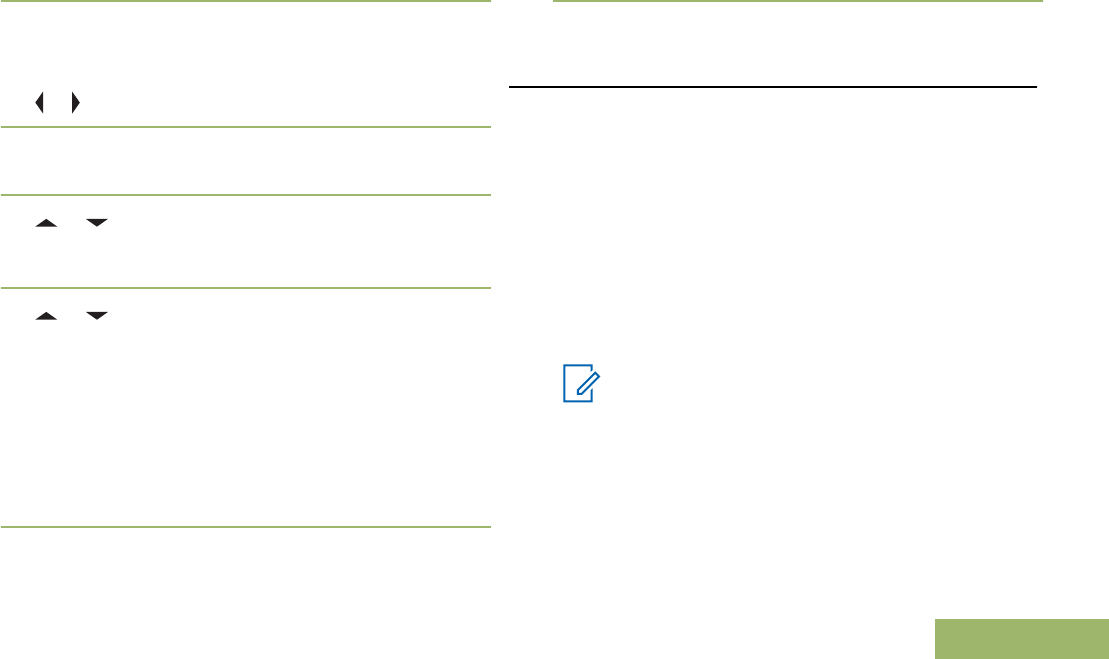
5To return to the Home screen, press the Menu
Select button directly below Exit.
The SSA Alert for all sites stop.
Stopping SSA Notification of All Available Sites
1 or to SSA.
2Press the Menu Select button directly below SSA.
The display shows the Site Alert screen.
3 or to Stop Alert and press the Menu
Select button directly below Sel.
The display shows the Select Site screen.
4 or to [All Avail] and press the Menu
Select button directly below Send.
The display shows Sending req.
If radio is out of range, roaming to a foreign
system or in a failsoft situation, the display shows
Req failed.
If the request is successful, the display shows Req
successful.
5To return to the Home screen, press the Menu
Select button directly below Exit.
The SSA Alert for all available sites stop.
Utilities
Viewing Recent Calls
This feature allows you to view the recent incoming
and outgoing call information of the following call
types:
• Call Alert
• Selective Call
• Private Call
• Phone Call (Outgoing Only)
• Emergency Call (Incoming Only)
Note:
The radio can also be preprogrammed to log
only the radio IDs associated with incoming
Dispatch Calls. Check with your dealer or
system administrator for more information.
The following methods are options on how to view
recent calls. The result of all the methods is the same.
Advanced Features
161
English

You can use the options interchangeably depending
on your preference and the programmed functions.
•Viewing recent calls via the preprogrammed
Recent Calls button:
a) Press the preprogrammed Recent Calls
button.
b) or to scroll through the list.
c) To return to the Home screen, press the Menu
Select button directly below Exit, press or
the PTT button.
•Viewing recent calls via the radio menu:
a) or to Rcnt.
b) Press the Menu Select button directly below
Rcnt to access the Recent Calls feature
screen.
c) or to scroll through the list.
d) To return to the Home screen, press the Menu
Select button directly below Exit, or the
PTT button.
The radio automatically exits the feature, if the feature
inactivity timer is enabled, when the radio is left idle
and the timer expires. You will hear the Menu Inactive
Exit Tone upon feature exit.
Using the Flip Display
This feature allows you to flip the content of the top
display upside down. It is particularly useful when you
would like to read the top display while the radio is
still in the carry holder attached to your belt.
To flip the display, press and hold the
preprogrammed Light/Flip button
Selecting a Basic Zone Bank
The Basic Zone Select feature must to be
preprogrammed to the 3-position A-B-C switch,
while the Basic Zone Bank feature must be
preprogrammed to any side button or Top (Orange)
button before you can use this feature.
This feature allows twice as many zones to be
accessed from a switch, doubling the amount of
switch positions.
Use the preprogrammed Basic Zone Bank button
to toggle the position between Bank 1 and Bank 2.
Advanced Features
162
English

The top display shows the status icons (A, B, C, D,
E or F) or the zone name based on the bank and
switch position selected.
Note:
See the Basic Zone Bank 1 and Basic
Zone Bank 2 icons for more information on
the status icons.
Selecting an Enhanced Zone Bank
This feature is created in order to allow users to
communicate in more zones. An Enhanced Zone
Bank (EZB) consists of three zones. This also means
each icon A, B, C, ... or Y consist of three zones. You
can use the preprogrammed 3-position A-B-C switch
to select the first, second or third zone in an EZB.
This feature allows user to navigate from up to 75
zones in 25 EZBs.
Note:
The Zone Select feature must to be
preprogrammed to the 3-position A-B-C
switch, while the Enhanced Zone Bank feature
must be preprogrammed to any side button or
Top (Orange) button before you can use this
feature.
1Press the preprogrammed EZB Up or EZB Down
button to scroll the EZB up or down or press and
hold the preprogrammed EZB Up or EZB Down
button to fast scroll the EZB up or down.
2Turn the 3-Position A/B/C Switch to select the
first, second or third zone in the selected EZB.
Selecting the Power Level
Note:
This feature must be preprogrammed by a
qualified radio technician.
This feature enables you to reduce the transmit
power level for specific case that requires a lower
power level. You can select the power level at which
your radio transmits. The radio always turns on to the
default setting. These reduced transmit power level
settings do not affect the receiving performance of
your radio, nor diminish the overall quality of the
audio and data functionality of the radio given the
following conditions.
Power level Low enables a shorter transmitting
distance and to conserve power. Power level High
enables a longer transmitting distance.
Advanced Features
163
English
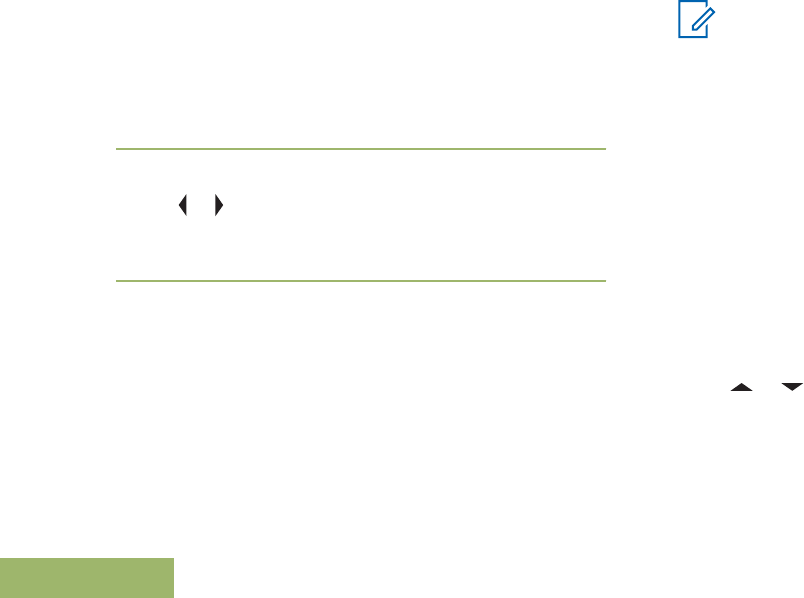
The following methods are options on how to select
the power level. The result of all the methods is the
same. You can use the options interchangeably
depending on your preference and the programmed
functions.
•Selecting the Power Level via the Transmit
Power Level switch:
a) Use the preprogrammed Transmit Power
Level switch to toggle the power level between
low and high power.
•Selecting the Power Level via the radio menu:
a) or to Pwr.
b) Press the Menu Select button directly below
Pwr.
The display shows Low power and the low power
icon or the display shows High power and the high
power icon.
Selecting a Radio Profile
This feature allows you to manually switch the visual
and audio settings of the radio. The display, backlight,
alert tones, and audio settings are defined according
to the preprogrammed radio settings of each radio
profile.
Please refer to a qualified technician for more
information.
Note:
The radio automatically exits the feature, if the
feature inactivity timer is enabled, when the
radio is left idle and the timer expires. You will
hear the Menu Inactive Exit Tone upon feature
exit.
The following methods are options on how to select a
radio profile. The result of all the methods is the
same. You can use the options interchangeably
depending on your preference and the programmed
functions.
•Selecting a radio profile via the preprogrammed
Profile button:
a) Press the preprogrammed Profile button.
b) or to scroll through the menu selections.
c) Press the Menu Select button directly below
Sel to select the required radio profile, or press
the Menu Select button directly below Exit to
exit the screen without making any changes.
Advanced Features
164
English

The radio returns to the Home screen. The profile
name on the Home screen indicates the current
selected radio profile.
•Selecting a radio profile via the radio menu:
a) or to Prfl and press the Menu Select
button directly below Prfl to access the
Profiles feature screen.
b) or to scroll through the menu selections.
c) Press the Menu Select button directly below
Sel to select the required radio profile, or press
the Menu Select button directly below Exit to
exit the screen without making any changes.
The radio returns to the Home screen. The profile
name on the Home screen indicates the current
selected radio profile.
Enabling and Disabling the Radio Alias
This feature allows you to display or hide the radio
alias (name).
Press the Menu Select button directly below
MyID.
The display shows momentary Radio ID off, and
the radio alias disappears from the Home screen or
the display shows momentary Radio ID on, and the
radio alias appears on the Home screen.
Selecting the Audio Speaker
Your radio must be preprogrammed to allow you to
use this feature.
This feature allows you to select the speaker route for
the radio's audio from either the main or the
secondary speaker using the radio profile settings.
While both speakers function together with the
secondary speaker enhancing intelligibility of the
received audio during typical radio operation, each
speaker has an independently-tuned frequency
response and volume level operation.
The secondary speaker also has a "whisper" mode
with a modified volume taper for quieter modes of
operation.
Note:
If an external speaker or microphone
accessory is attached to the radio, neither
internal speaker is operational as audio is
routed to the accessory.
The following methods are options on how to select
the audio speaker. The result of all the methods is the
same. You can use the options interchangeably
Advanced Features
165
English

depending on your preference and the programmed
functions.
•Select the audio speaker via the preprogrammed
Profile button:
a) Press the preprogrammed Profile button.
b) or to scroll through the menu selections.
c) Press the Menu Select button directly below
Sel to select the radio profile with the required
speaker routing or press the Menu Select
button directly below Exit to exit the screen
without making any changes.
The radio returns to the Home screen. The
profile name on the Home screen indicates the
current selected radio profile.
•Select the audio speaker via the radio menu Prfl:
a) or to Prfl.
b) To access the Profiles feature screen, press
the Menu Select button directly below Prfl.
c) or to scroll through the menu selections.
d) Press the Menu Select button directly below
Sel to select the radio profile with the required
speaker routing or press the Menu Select
button directly below Exit to exit the screen
without making any changes.
The radio returns to the Home screen. The
profile name on the Home screen indicates the
current selected radio profile.
Controlling the Display Backlight
You can enable or disable the radio’s display
backlight as needed, if poor light conditions make the
display or keypad difficult to read.
Depending on how your radio is preprogrammed, you
can also maintain a minimum backlight level on the
radio's front display.
Note:
The backlight setting also affects the Menu
Select buttons, the Navigation button and the
keypad backlighting accordingly.
The backlight remains on for a
preprogrammed time before it automatically
turns off completely or returns to the minimum
backlight level.
The preprogrammed Light/Flip button of the
accessories connected to the radio such as
Advanced Features
166
English

Display Remote Speaker Microphone (DRSM)
is disabled when the radio is in Night Vision
Goggles (NVG) display mode.
Perform one of the following actions:
• To toggle the backlight on or off, press the
preprogrammed Light/Flip button.
• To turn the backlight on, press any key of the
keypad, the Menu Select or Navigation
button, or any programmable radio controls or
buttons.
Setting Up the Radio Display and Visual Indicators to
Suit Night Vision Goggles
During tactical nighttime operations of military entities
worldwide, the Night Vision Goggles (NVG) is used to
see in the dark. Your radio is 3rd generation NVG
compatible. When the radio is in NVG display mode,
the radio's front display and top display emit a very
low illumination backlight to allow the user to operate
the radio with the goggles on.
Caution:
Remove your NVG if you operate the radio in
non-NVG compatible display mode. Wearing
the NVG to operate in non-NVG compatible
display mode might injure your eyes.
Accessory connected to the radio that is in NVG
display mode such as Display Remote Speaker
Microphone (DRSM) has its backlight always in off
state.
Intelligent lighting indicators, TX LED and RX LED
are all disabled on both the radio and the connected
accessory when the radio is in NVG display mode.
Note:
Get familiar with your radio NVG feature and
operation before you use it with your Night
Vision Goggles.
The following methods are options on how to set up
the radio display and visual indicators. The result of
all the methods is the same. You can use the options
interchangeably depending on your preference and
the programmed functions.
•Setting up the radio display and visual indicators
via the preprogrammed Profile button:
a) Press the preprogrammed Profile button.
b) or to the designated NVG profile.
Advanced Features
167
English

c) To select the required radio profile, press the
Menu Select button directly below Sel or to
exit the screen without making any changes,
press the Menu Select button directly below
Exit.
The radio returns to the Home screen with
NVG display mode. The profile name on the
Home screen indicates the current selected
radio profile.
•Setting up the radio display and visual indicators
via the radio menu Prfl:
a) or to Prfl.
b) To access the Profiles screen, press the
Menu Select button directly below Prfl.
c) or to the designated NVG profile.
d) To select the required radio profile, press the
Menu Select button directly below Sel or to
exit the screen without making any changes,
press the Menu Select button directly below
Exit.
The radio returns to the Home screen with
NVG display mode. The profile name on the
Home screen indicates the current selected
radio profile.
Locking and Unlocking the Keypad and Controls
You can lock the keypad, programmable buttons,
rotary knobs, and switches of your radio to avoid
inadvertent entry. Check with your dealer or qualified
technician for best selection to suit your usage.
1Toggle the preprogrammed Keypad/Control Lock
button or switch to on.
The display shows Kypd/Ctrl Lock.
2Toggle again to unlock the controls.
Turning the Controls and Keypad Buttons Tones On or
Off
You can enable and disable the tones of Navigation
buttons, controls and keypad if needed.
•Turning the tones on or off via the preprogrammed
Mute button:
a) To turn the tones off or on, press the
preprogrammed Mute button.
•Turning the tones on or off via the radio menu:
a) or to Mute.
b) Press the Menu Select button directly below
Mute.
Advanced Features
168
English

The display shows momentary Tones off,
indicating that the tones are disabled or the
display shows momentary Tones on, and you
hear a short tone indicating that the tones are
enabled.
Turning Voice Mute On or Off
You can enable and disable voice transmission, if
needed.
The following methods are options on how to turn
Voice Mute on or off. The result of all the methods is
the same. You can use the options interchangeably
depending on your preference and the programmed
functions.
•Turning Voice Mute off or on via the
preprogrammed Voice Mute button:
a) To turn the feature off or on, press the
preprogrammed Voice Mute button.
•Turning Voice Mute on or off via the radio menu:
a) or to VMut.
b) Press the Menu Select button directly below
VMut.
The display shows momentary Voice mute off, and
you hear a short tone, indicating that the feature is
disabled or the display shows momentary Voice
mute on, and you hear a short tone, indicating that
the feature is enabled.
Using the Time-Out Timer
This feature turns off the transmitter of your radio.
You cannot transmit longer than the preset timer
setting.
If you attempt to do so, the radio automatically stops
your transmission, and you hear a talk-prohibit tone.
The timer is defaulted at 60 seconds, but it can be
preprogrammed from 3 to 120 seconds, in 15-second
intervals, or it can be disabled entirely for each radio
mode, by a qualified radio technician.
Note:
You hear a brief, low-pitched, warning tone
four seconds before the transmission times
out.
1Hold down the PTT button longer than the
preprogrammed time.
Advanced Features
169
English

You hear a short, low-pitched warning tone, the
transmission is cut-off, and the LED goes out until
you release the PTT button.
2Release the PTT button.
The timer resets.
3To re-transmit, press the PTT button.
The time-out timer restarts and the LED lights up
solid red.
Time and Date Setup
You can set the time and date for your radio.
Settings:
• The default time setting is a 12-hour clock. The
display shows 12:00AM.
• The AM/PM selection is not available for the 24-
hour clock setting.
• The default setting for the domestic date shows
MDY.
Note:
Check with your dealer or system
administrator for additional programmable
settings for this feature.
Editing the Time and Date
1 or to Clck.
2Press the Menu Select button directly below
Clck.
The display shows the current setting of the radio.
3Press the Menu Select button directly below
Edit.
The first item blinks.
4Perform one of the following actions:
• or to change the selected item.
• or one or more times to move to an item you
wish to change. or to change the
selected item.
• Press the Menu Select button directly below
Exit to exit the screen without making any
changes and return to the Home screen.
5Perform one of the following actions:
• Press the Menu Select button directly below
Ok once you have finished to save your
changes and return to the Home screen.
Advanced Features
170
English

• Press the Menu Select button directly below
Cncl to discard all changes and return to the
Home screen.
Press at any time to return to the Home screen
without saving your changes.
Note:
If a call arrives while the radio is in the
clock-setting menu, the radio exits clock
setting and displays the call information.
Any changes made before the call is not
saved.
Using Conventional Squelch Operation Features
This feature filters out unwanted calls with low signal
strength or channels that have a higher than normal
background noise.
Analog Options
Tone Private Line (PL), Digital Private-Line (DPL),
and carrier squelch can be available
(preprogrammed) per channel.
Mode Result
Carrier squelch (C) You hear all traffic on a
channel.
Mode Result
PL or DPL The radio responds only
to your messages.
Digital Options
One or more of the following options may be
preprogrammed in your radio. Check with your dealer
or system administrator for more information.
Option Result
Digital Carrier-Operated
Squelch (COS)
You hear any digital traf-
fic.
Normal Squelch You hear any digital traf-
fic having the correct net-
work access code.
Selective Switch You hear any digital traf-
fic having the correct net-
work access code and
correct talkgroup.
Using the PL Defeat Feature
This feature allows you to override any coded squelch
(DPL or PL) that might be preprogrammed to a
Advanced Features
171
English

channel. The radio also unmutes to any digital activity
on a digital channel.
Place the preprogrammed PL Defeat switch in the
PL Defeat position.
One of the following scenarios occurs:
• You hear any activity on the channel.
• The radio is muted if no activity is present.
Note:
When this feature is active, the Carrier
Squelch status indicator is displayed.
Digital PTT ID Support
This feature allows you to see the radio ID (number)
of the radio from whom you are currently receiving a
transmission. This ID, consisting up to a maximum of
eight characters, can be viewed by both the receiving
radio and the dispatcher.
The ID number of your radio is also automatically sent
every time the PTT button is pressed. This is a per-
channel feature. For digital voice transmissions, the
ID of your radio is sent continuously during the voice
message.
Smart PTT Feature (Conventional Only)
Smart PTT is a per-personality, programmable
feature used in conventional radio systems to keep
radio users from talking over other radio
conversations.
When smart PTT is enabled in your radio, you cannot
transmit on an active channel.
If you try to transmit on an active smart-PTT channel,
you hear an alert tone, and the transmission is
inhibited. The LED lights up solid yellow to indicate
that the channel is busy.
The following table shows the variations of smart
PTT:
Mode Description
Transmit Inhibit
on Busy Chan-
nel with Carrier
You cannot transmit if any traffic
is detected on the channel.
Transmit Inhibit
on Busy Chan-
nel with Wrong
Squelch Code
You cannot transmit on an active
channel with a squelch code or (if
secure-equipped) encryption key
other than your own. If the PL
Advanced Features
172
English
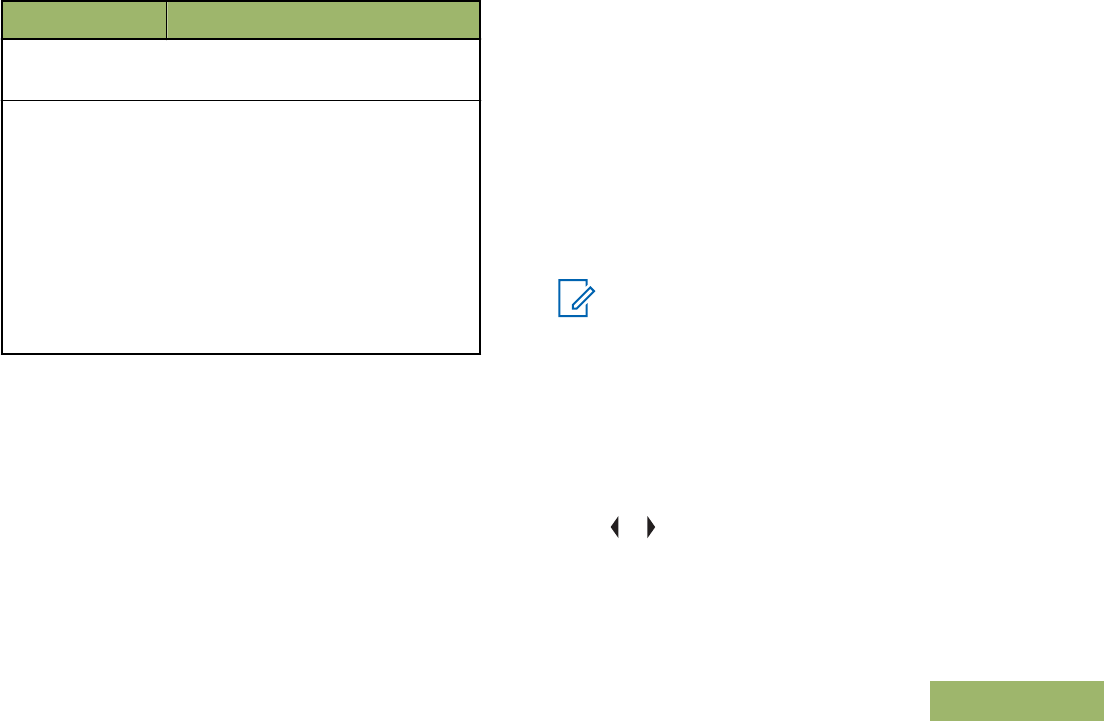
Mode Description
code is the same as yours, the
transmission is not prevented.
Quick-Key Over-
ride
Your radio must be preprogram-
med to allow you to use Quick-
Key Override. This feature can
work in conjunction with either of
the two above variations. You
can override the transmit-inhibit
state by quick-keying the radio. In
other words, two PTT button
presses within the preprogram-
med time limit.
Transmit Inhibit
This feature is available for APCO 25 trunking, Type II
trunking and Conventional operations for all APX
radios.
When Transmit Inhibit feature is enabled, the radio
stops all transmission including voice and data. The
radio could receive messages but not replying the
acknowledgement request of the received message.
User could physically control the transmission of the
radio especially during operation in hazardous
environments with this feature. An environment is
considered hazardous when the power emitted by the
radio power amplifier could initiate an explosion or
other dangerous reactions.
When the Transmit Inhibit feature is disabled, the
radio functions according to its normal operations.
The radio sounds alert tone when user enters or exits
this feature and also when PTT is pressed.
Note:
Acknowledgement of any messages required
from the radio is not transmitted if the Transmit
Inhibition is enabled.
Enabling Transmit Inhibition
Perform one of the following actions:
• Switch the preprogrammed Transmit Inhibit
switch to Transmit Inhibit enabled.
• or to TxIn. Press the Menu Select button
below TxIn.
• Press the Transmit Inhibit programmable
button.
Advanced Features
173
English

Note:
If the user has disabled TX Inhibit via the
menu and then moves the switch to the
position where TX Inhibit is enabled, the
new value overwrites the menu value.
The display shows Tx inhibit on. You hear a
sequence of short, low‐high tones to indicate
transmission is inhibited.
Pressing PTT triggers the radio sounds a constant
short, low‐pitched tone (reject tone).
Note:
The status of the Transmit Inhibit does not
change after the radio powers up.
Disabling Transmit Inhibition
Perform one of the following actions:
• Switch the preprogrammed Transmit Inhibit
switch to Transmit Inhibit disabled position.
• or to TxIn. Press the Menu Select button
below TxIn.
• Press the Transmit Inhibit programmable
button.
Note:
If the user has disabled TX Inhibit via the
softkey and then moves the switch to the
position where TX Inhibit is enabled, the
new value overwrites the menu value.
The display shows Tx inhibit off. You hear a
sequence of short, high‐low tone (Transmit Inhibit
Off tone) to indicate transmission is back to normal
operation.
IMPRES Battery Annunciator
This feature displays the current capacity and
charges cycles of your battery when an IMPRES™
Battery is powering your radio. This feature must be
enabled in your radio to see the information.
The information shown are:
Charge
Percentage
Percentage of current battery
capacity.
Remaining
Capacity
Remaining power of the battery
in mAh.
Estimated
Charges
Number of charges cycles the
battery has gone through.
Advanced Features
174
English

Accessing the Battery Info screen
1 or to Batt.
2Press the Menu Select button directly below
Batt.
The display shows the details of the battery.
3To return to the Home screen, press the Menu
Select button directly below Exit.
General Radio Information
Your radio contains information on the following:
• Radio Information
• IP Display
• Control Assignments
• Soft ID (If enabled)
Note:
The radio automatically exits the feature, if the
feature inactivity timer is enabled, when the
radio is left idle and the timer expires. You
hear the Menu Inactive Exit Tone upon feature
exit.
Accessing the Radio Information
This feature displays the following radio information:
• Host Version
• Secure Version
• Model Number
• ESN
• Flash Code
• Tuning Version
• Option Board Type (optional)
• Option Board Bluetooth Address (optional)
• Expansion Board Type (optional)
• DSP Version
• KG (Secure Algorithm)
• Serial Number
• Flash Size & Type
• RF Band(s)
• Processor Version
• Option Board Serial Number (optional)
• Option Board Software Version (optional)
• Language Pack ID and Version (only when the
language of the display is set to non-English)
Advanced Features
175
English
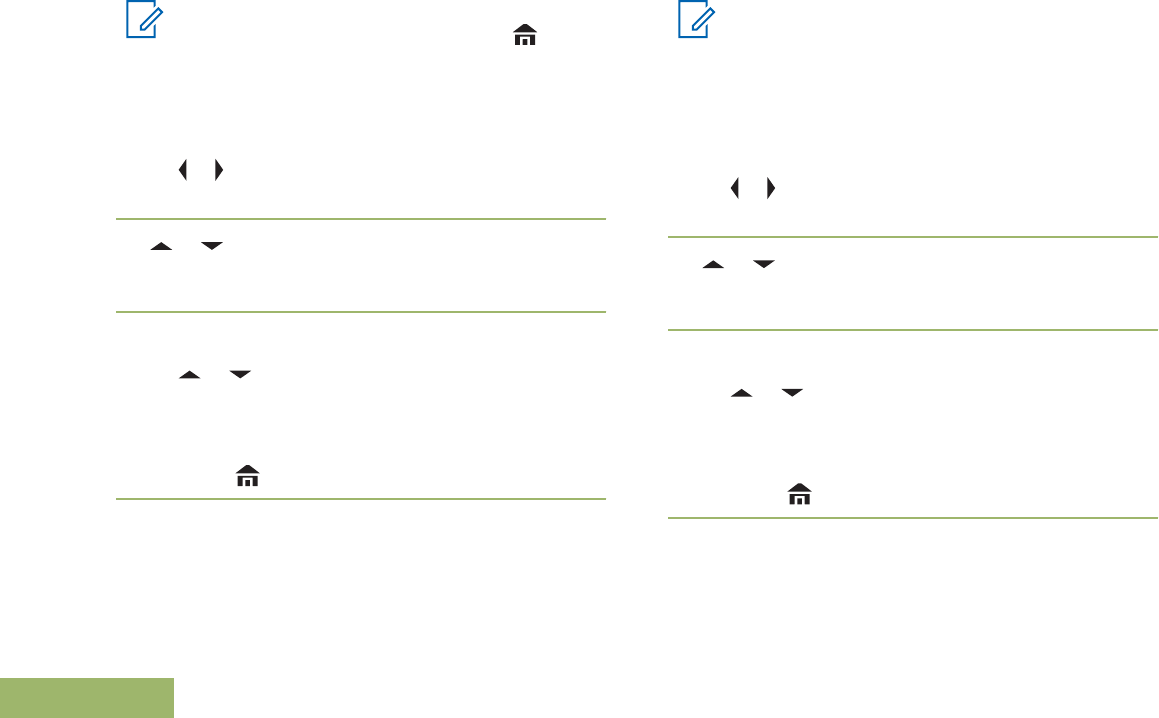
Note:
To return to the Home screen, press at any
time.
1Perform one of the following actions:
•Press the preprogrammed Info button.
• or to Info and press the Menu Select
button directly below Info.
2 or to Radio Info and press the Menu
Select button directly below Sel.
The display shows the Information screen.
3Perform one of the following actions:
• or to scroll through the various
information.
• To return to the previous screen, press the
Menu Select button directly below Back.
•Press to return to the Home screen .
Viewing the IP Information
This feature displays the device name, IP address,
and status of your radio.
Note:
The device name of your radio is
preprogrammed. Check with your dealer or
system administrator for more information.
1Perform one of the following actions:
• Press the preprogrammed Info button.
• or to Info and press the Menu Select
button directly below Info.
2 or to IP Info and press the Menu Select
button directly below Sel.
The display shows the IP Info screen.
3Perform one of the following actions:
• or to scroll through the various
information.
• Press the Menu Select button directly below
Back to return to the previous screen.
•Press to return to the Home screen.
Viewing the Control Assignments
This feature displays the programmable radio
functions assigned to the controls of your radio for the
currently selected channel.
Advanced Features
176
English

See Programmable Features on page 29 for more
information on the various programmable features of
your radio.
1Perform one of the following actions:
•Press the preprogrammed Info button.
• or to Info and press the Menu Select
button directly below Info.
2 or to Control map and press the Menu
Select button directly below Sel.
The display shows the Control Map screen.
3Perform one of the following actions:
• or to scroll through the various
information.
• Press the Menu Select button directly below
Back to return to the previous screen.
•Press to return to the Home screen.
Editing the Soft ID
Your radio must be preprogrammed to allow you to
use this feature.
This feature allows you to change your username.
1Perform one of the following actions:
• Press the preprogrammed Info button.
• or to Info and press the Menu Select
button directly below Info.
2 or to Soft ID and press the Menu Select
button directly below Sel.
The display shows the current Soft ID.
3Perform one of the following actions:
• Press the Menu Select button directly below
Edit to edit the current Soft ID.
• Press the Menu Select button directly below
Back to return to the previous screen.
A blinking cursor appears in the Edit Soft ID
screen.
4Use the keypad to edit the text.
5Perform one of the following actions:
• Press the Menu Select button directly below
Ok to save the new Soft ID and return to the
previous screen.
Advanced Features
177
English

• Press the Menu Select button directly below
Cncl to return to the previous screen.
Advanced Features
178
English
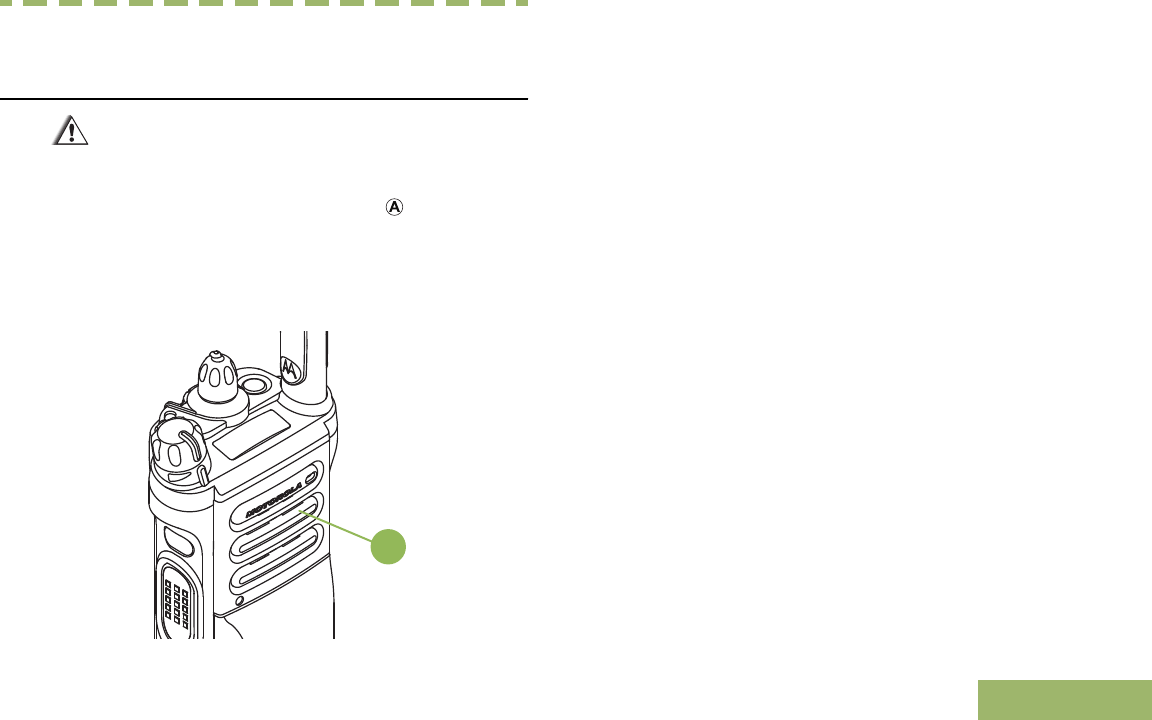
Helpful Tips
Radio Care
Caution:
• Your radio casting has a vent port that
allows for pressure equalization in the
radio. Never poke this vent with any
objects, such as needles, tweezers, or
screwdrivers.This could create leak paths
into the radio and the radio’s submergibility
will be lost.
A
• Your radio is designed to be submerged to
a maximum depth of 6 feet, with a
maximum submersion time of 2 hours.
Exceeding either maximum limit may result
in damage to the radio.
• Elastomer technology materials used for
seals in rugged portable radios can age
with time and environmental exposure.
Therefore, Motorola recommends that
rugged radios be checked annually as a
preventive measure in order to assure the
watertight integrity of the radio. Motorola
details the disassembly, test, and
reassembly procedures along with
necessary test equipment needed to
inspect, maintain and troubleshoot radio
seals in the radio’s service manual.
• If the radio battery contact area has been
submerged in water, dry and clean the
radio battery contacts before attaching a
battery to the radio. Otherwise, the water
could short-circuit the radio.
• If the radio has been submerged in water,
shake the radio well so that any water that
may be trapped inside the speaker grille
and microphone port can be removed.
Helpful Tips
179
English

Otherwise, the water will decrease the
audio quality of the radio.
• Do not disassemble the radio. This could
damage radio seals and result in leak
paths into the radio. Any radio
maintenance should be performed only by
a qualified radio technician.
Cleaning Your Radio
Caution:
Do not use solvents to clean your radio as
most chemicals may permanently damage the
radio housing and textures.
Do not submerge the radio in the detergent
solution.
To clean the external surfaces of your radio, follow
the procedure described next.
1Combine one teaspoon of mild dishwashing
detergent to one gallon of water (0.5% solution).
2Apply the solution sparingly with a stiff, non-
metallic, shortbristled brush, making sure excess
detergent does not get entrapped near the
connectors, controls or crevices. Dry the radio
thoroughly with a soft, lint-free cloth.
3Clean battery contacts with a lint-free cloth to
remove dirt or grease.
Preparation for Washing the Radio and Parts
You can detach the battery and Universal Connector
Cover of the radio and have them and the radio
brushed and washed with detergent and water.
Prepare the following material, apparatus or
equipment before you begin washing the radio and
parts.
• A bucket of tap water (water height must be at
least 2 inches higher than radio height).
• A bucket of 0.5% liquid detergent solution (1
teaspoon of recommended liquid detergent to 1
gallon of water or 1 part recommended liquid
detergent to 200 parts water; water height must be
at least 2 inches higher than radio height).
• A small brush
• A toothbrush
• Source of running water
• Drying towel
Helpful Tips
180
English
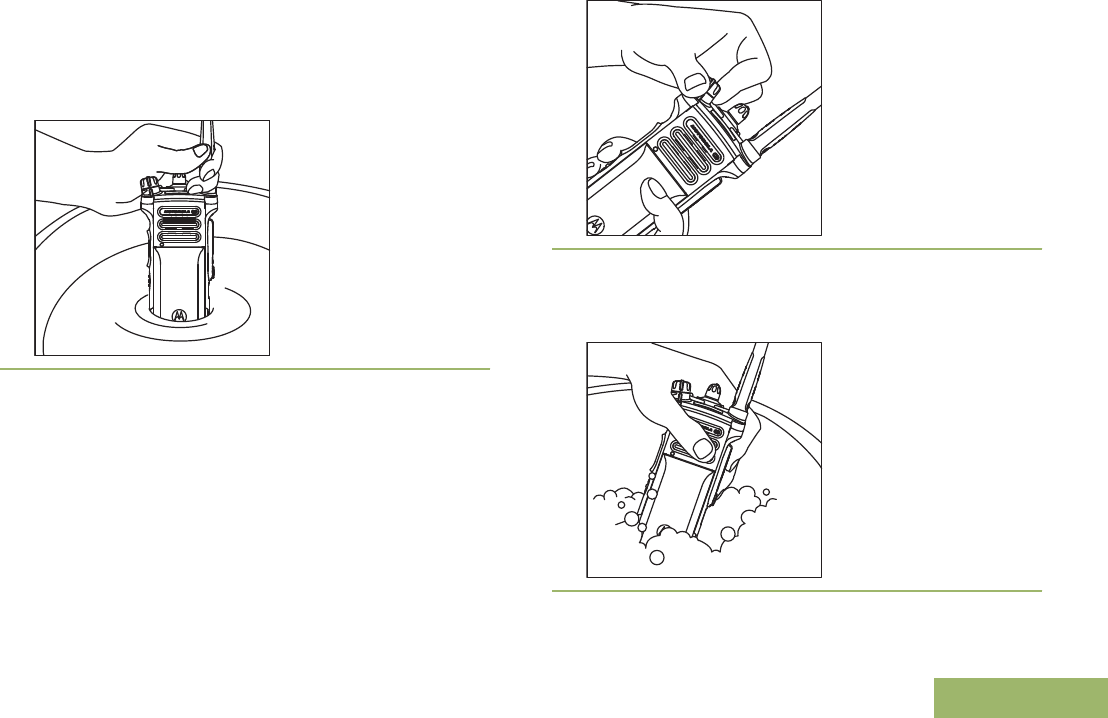
Washing The Radio
1Submerge the radio (with battery attached)
completely into the tap water while shaking it for
approximately 20 seconds.
2Remove the radio from the water and perform the
following. Turn the frequency knob all the way
from position 1 to 15 and back to position 1 twice.
a) Turn the volume knob all the way from the
minimum off position to its maximum volume
position and back twice.
b) Turn the 3-Position A/B/C switch from A to C
and back to A twice.
c) Slide the Secure Switch back and forth twice.
Dip the radio into the water one more time.
3Dip the radio completely into the detergent
solution and repeat turning action for both knobs,
3-Position A/B/C and the Secure Switch.
Helpful Tips
181
English
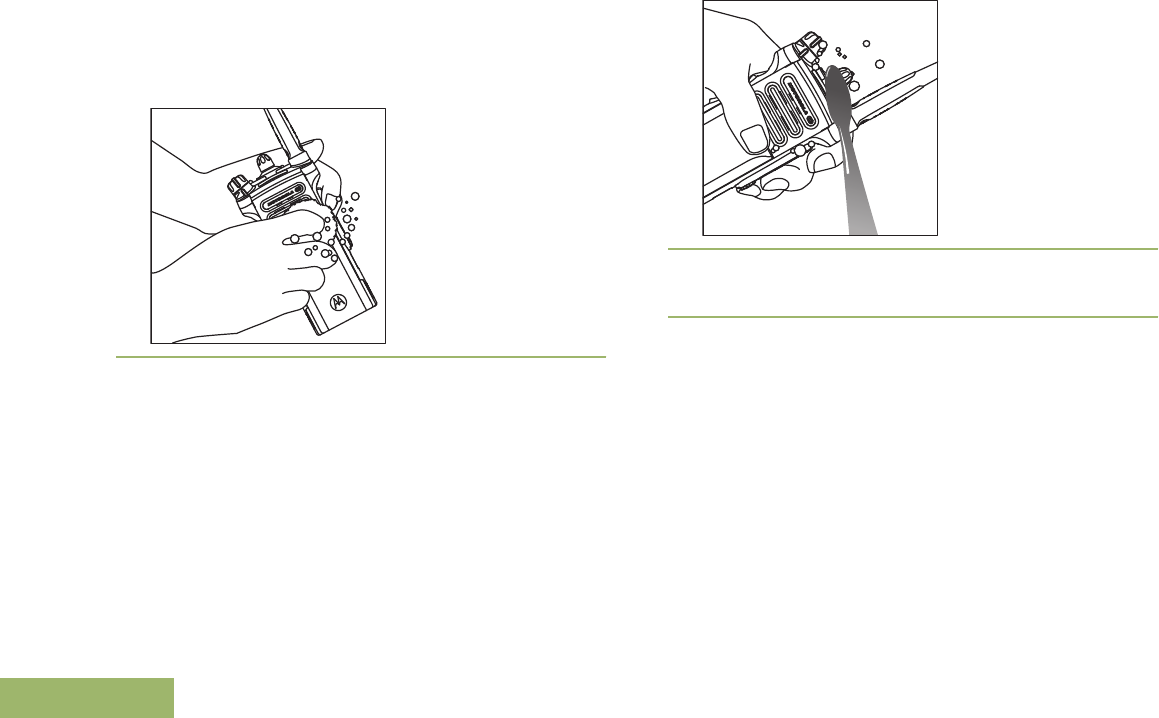
4Lightly scrub the plastic area (front, back, bottom,
top and side planes) of the radio with the small
brush.Take extra care around the Speaker Grill
and Microphone port openings.
5Use the toothbrush to lightly brush the gaps at the
base of the knobs and around the switches. Take
extra care around the Speaker Grill and
Microphone port openings.
6Submerge the radio into tap water and shake it to
remove the detergent.
7After removing the radio from the water, rinse the
radio under running water to remove any excess
detergent. Take extra care to thoroughly rinse out
any trapped detergent solution from the speaker
grill area.
Helpful Tips
182
English
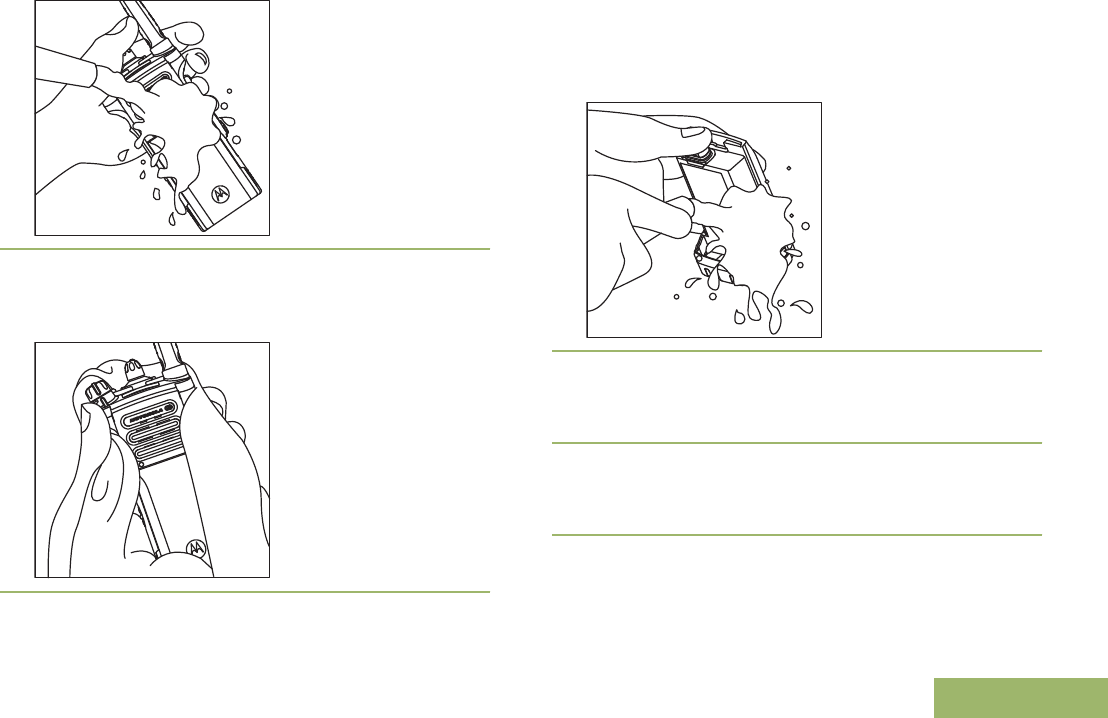
8Shake off excess water and pat dry the radio with
a dry towel. Take extra care to tap/shake out any
trapped water from the speaker grill area.
Washing the Battery
1Rinse the battery under running water to remove
any excess debris.
2Using the small brush dipped in the detergent
solution, lightly scrub the front, botom and sides of
the battery.
3Use the toothbrush to brush the back and top of
the battery. Exercise caution to avoid scratching
the battery contacts.
4Using the small brush, scrub the latches
thoroughly to remove any accumulated deposits
between the latch and housing.
Helpful Tips
183
English
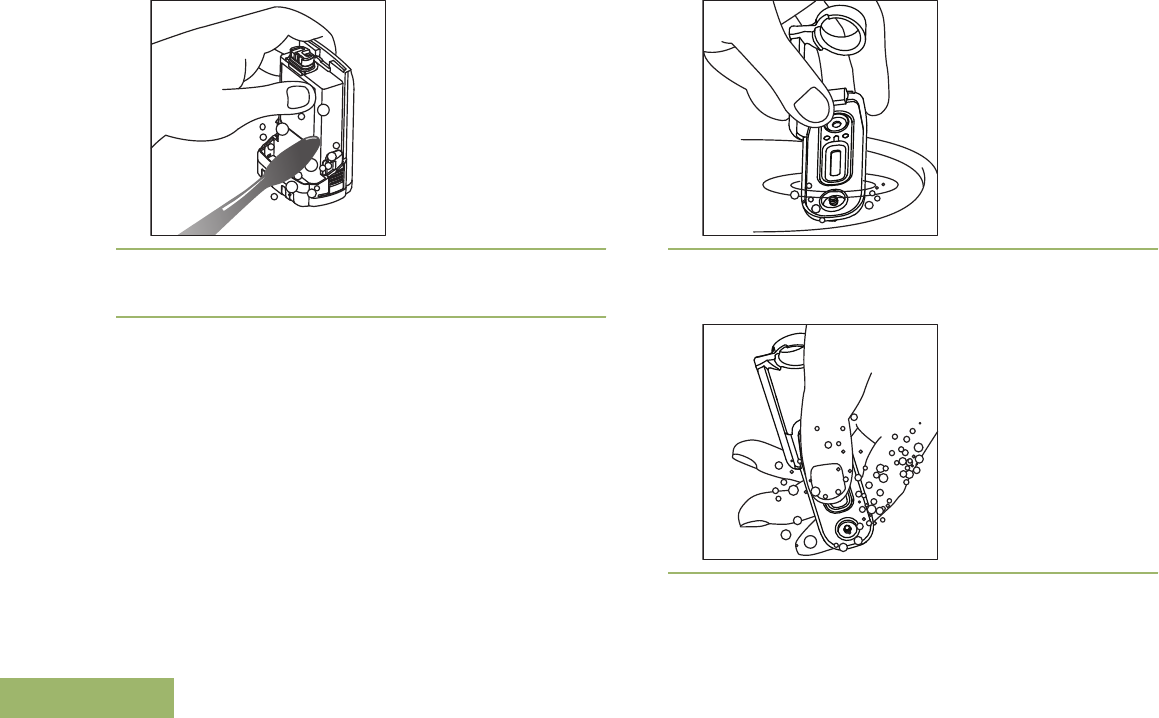
5Rinse the battery under running water to remove
any excess detergent.
Washing the Universal Connector Cover
1Dip the universal connector cover into tap water
followed by the detergent solution.
2Use your thumb or finger to lightly rub clean the
rubber seal.
Helpful Tips
184
English
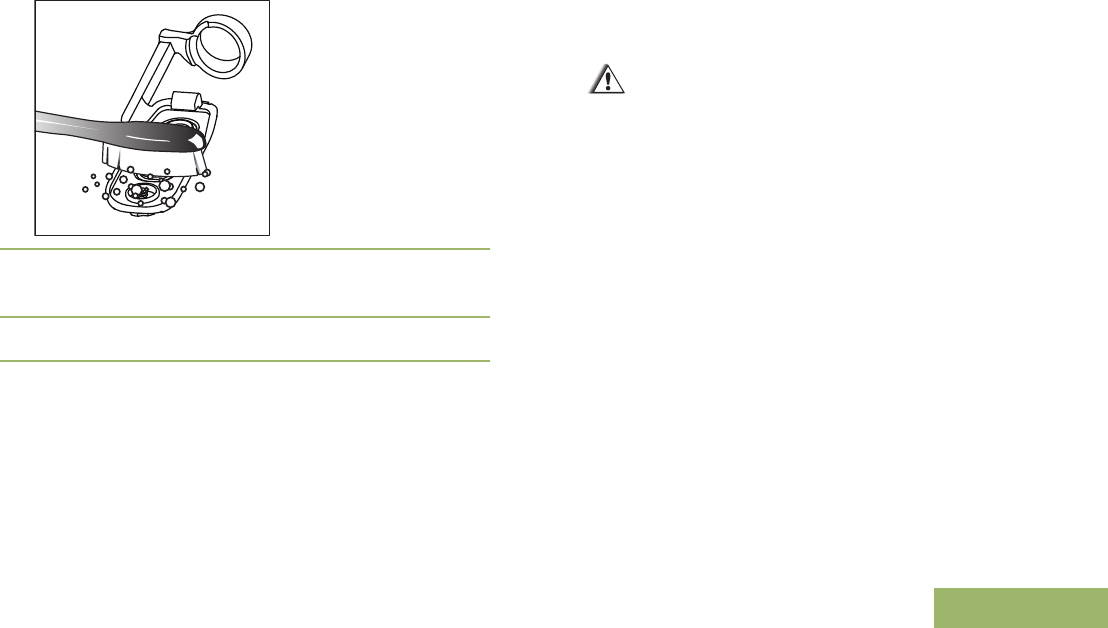
3Use the toothbrush to scrub off any dirt or foreign
matter from the niches of the top catch and thumb
screw.
4Rinse the cover under running waer to wash off
the detergent.
5Pat dry with a towel.
Proper Ways to Handle the Radio
• Do not pound, drop, or throw the radio
unnecessarily. Never carry the radio by the
antenna.
• Avoid subjecting the radio to an excess of liquids.
Do not submerge the radio unless it is a
ruggedized.
• Avoid subjecting the radio to corrosives, solvents
or chemicals.
• Do not disassemble the radio.
•Caution:
Do not use the radio without an accessory
connector or a dust cover in place as
contamination can build up on the contacts.
• When charging the radio using a wall mounted
charger, the radio must be turned off. Otherwise,
the Man Down Alert and Emergency may be
accidentally triggered.
Radio Service and Repair
Proper repair and maintenance procedures will
assure efficient operation and long life for this
product. A Motorola maintenance agreement will
provide expert service to keep this and all other
communication equipment in perfect operating
condition. A nationwide service organization is
provided by Motorola to support maintenance
services. Through its maintenance and installation
program, Motorola makes available the finest service
to those desiring reliable, continuous communications
Helpful Tips
185
English
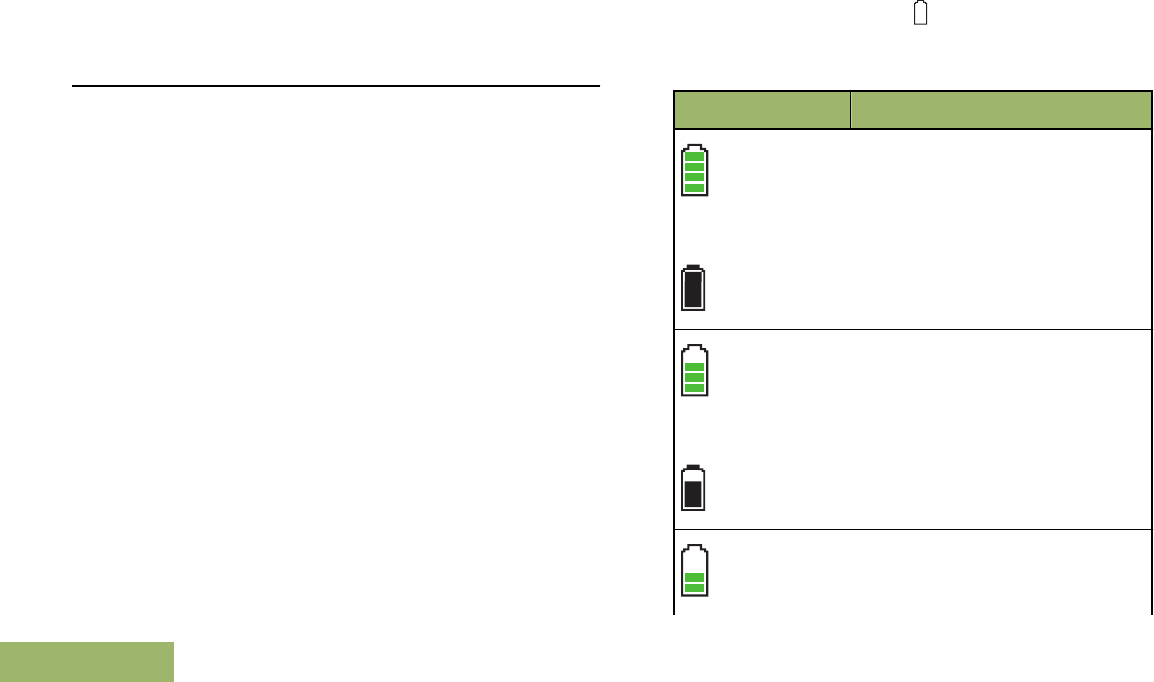
on a contract basis. For a contract service agreement,
please contact your nearest Motorola service or sales
representative, or an authorized Motorola dealer.
Battery Care
Battery Charge Status
Your radio can indicate the battery’s charge status
through:
• the LED and sounds.
• the fuel gauge icon on the display.
You can also check the battery charge status via the
menu entry. See IMPRES Battery Annunciator on
page 174 for more information.
LED and Sounds
When your battery is low:
• the LED blinks red when the PTT button is
pressed.
• you hear a low-battery “chirp” (short, high-pitched
tone).
Fuel Gauge Icons
A blinking fuel gauge icon ( ) is displayed only when
the battery voltage drops to low level. In this case,
replace the battery with a fully charged one.
Gauge Battery Charge
Top Display:
76% to 100% full[3]
Top Display:
51% to 75%[3]
26% to 50%[3]
Helpful Tips
186
English
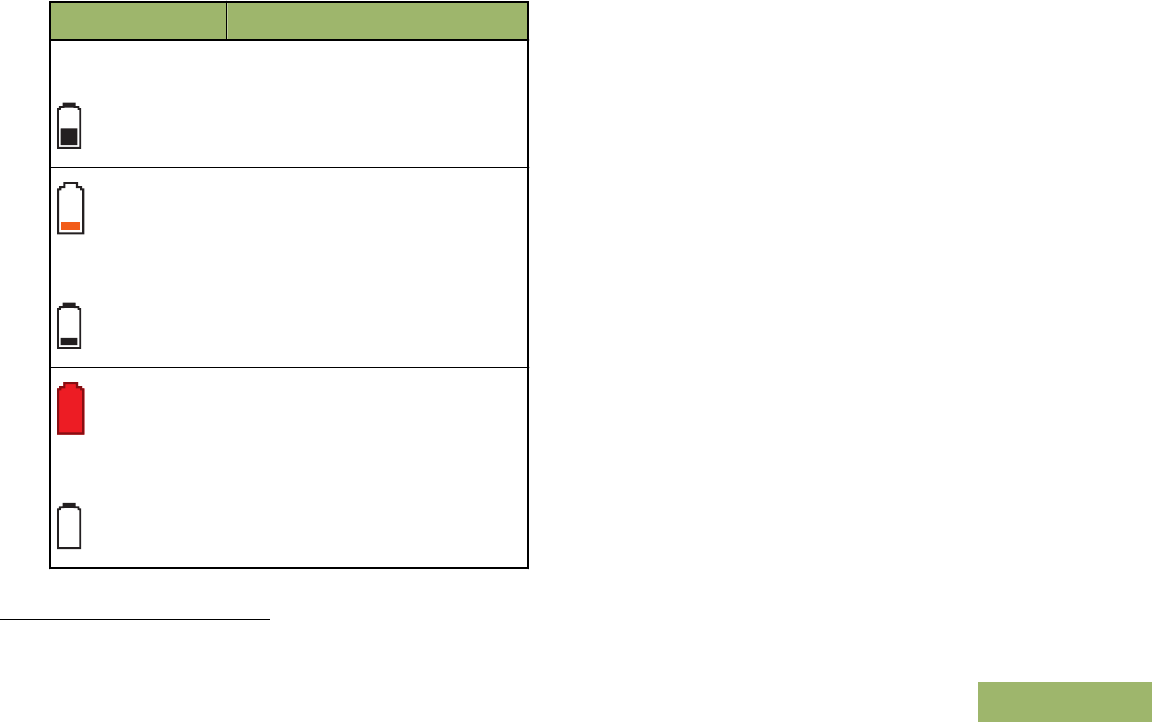
Gauge Battery Charge
Top Display:
Top Display:
11% to 25%[3]
Top Display:
10% or less (at 10%, the gauge
begins blinking)
Battery Recycling and Disposal
In the U.S. and Canada, Motorola participates in the
nationwide Rechargeable Battery Recycling
Corporation (RBRC) program for battery collection
and recycling. Many retailers and dealers participate
in this program.
For the location of the drop-off facility closest to you,
access RBRC's Internet web site at www.rbrc.com or
call 1-800-8-BATTERY. This internet site and
telephone number also provide other useful
information concerning recycling options for
consumers, businesses, and governmental agencies.
3These are for IMPRES™ battery operation only.
Helpful Tips
187
English

Accessories
The accessory link below is for APX radios. Not all
accessories are FCC certified to operate with all APX
models and/or bandsplits. Please refer to the specific
APX radio price pages for a list of FCC certified
accessories or contact your sales representative for
accessory compatibility.
http://www.motorolasolutions.com/APX
Note:
GPS only antenna is only used in either a
single band UHF or 700/800 application where
the Public Safety Microphone (PSM) is used
with the corresponding PSM antenna. This
antenna is only for GPS reception and cannot
be used for receive/transmit operation at UHF,
VHF or 700/800. This antenna is never to be
used on the PSM.
Accessories
188
English

Maritime Radio Use in the VHF
Frequency Range
Special Channel Assignments
Emergency Channel
If you are in imminent and grave danger at sea and
require emergency assistance, use VHF Channel 16
to send a distress call to nearby vessels and the
United States Coast Guard. Transmit the following
information, in this order:
1“MAYDAY, MAYDAY, MAYDAY.”
2“THIS IS _____________________, CALL SIGN
__________.” State the name of the vessel in
distress 3 times, followed by the call sign or other
identification of the vessel, stated 3 times.
3Repeat “MAYDAY” and the name of the vessel.
4“WE ARE LOCATED AT
_______________________.” State the position
of the vessel in distress, using any information that
will help responders to locate you, e.g.:
• latitude and longitude
• bearing (state whether you are using true or
magnetic north)
• distance to a well-known landmark
• vessel course, speed or destination
5State the nature of the distress.
6Specify what kind of assistance you need.
7State the number of persons on board and the
number needing medical attention, if any.
8Mention any other information that would be
helpful to responders, such as type of vessel,
vessel length and/or tonnage, hull color, etc.
9“OVER.”
10 Wait for a response.
11 If you do not receive an immediate response,
remain by the radio and repeat the transmission at
intervals until you receive a response. Be
prepared to follow any instructions given to you.
Non-Commercial Call Channel
For non-commercial transmissions, such as fishing
reports, rendezvous arrangements, repair scheduling,
or berthing information, use VHF Channel 9.
Operating Frequency Requirements
A radio designated for shipboard use must comply
with Federal Communications Commission Rule Part
80 as follows:
Maritime Radio Use in the VHF Frequency Range
189
English
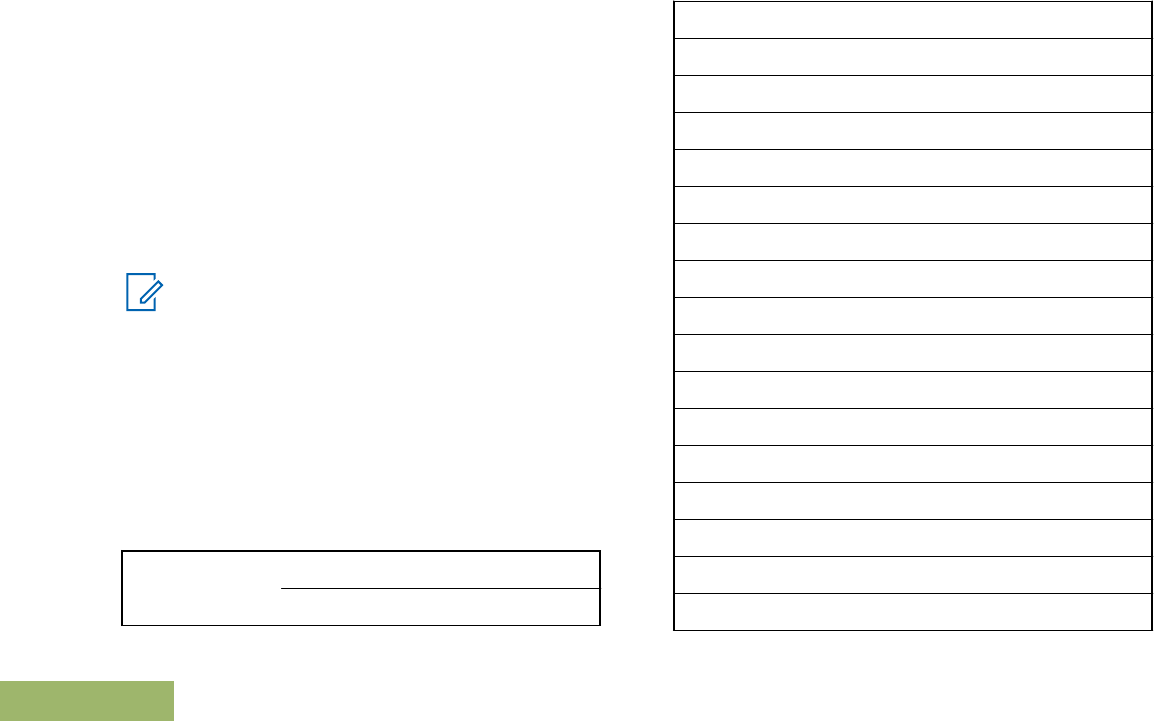
• on ships subject to Part II of Title III of the
Communications Act, the radio must be capable of
operating on the 156.800 MHz frequency.
• on ships subject to the Safety Convention, the
radio must be capable of operating:
• in the simplex mode on the ship station
transmitting frequencies specified in the
156.025 – 157.425 MHz frequency band, and
• in the semiduplex mode on the two frequency
channels specified in the table below.
Note:
Simplex channels 3, 21, 23, 61, 64, 81, 82,
and 83 cannot be lawfully used by the general
public in US waters.
Additional information about operating
requirements in the Maritime Services can be
obtained from the full text of FCC Rule Part 80
and from the US Coast Guard.
Table 1: VHF Marine Channel List
Channel Num-
ber
Frequency (MHz)
Transmit Receive
1 156.050 160.650
2 156.100 160.700
* 156.150 160.750
4 156.200 160.800
5 156.250 160.850
6 156.300 –
7 156.350 160.950
8 156.400 –
9 156.450 156.450
10 156.500 156.500
11 156.550 156.550
12 156.600 156.600
13** 156.650 156.650
14 156.700 156.700
15** 156.750 156.750
16 156.800 156.800
17** 156.850 156.850
Maritime Radio Use in the VHF Frequency Range
190
English

18 156.900 161.500
19 156.950 161.550
20 157.000 161.600
* 157.050 161.650
22 157.100 161.700
* 157.150 161.750
24 157.200 161.800
25 157.250 161.850
26 157.300 161.900
27 157.350 161.950
28 157.400 162.000
60 156.025 160.625
* 156.075 160.675
62 156.125 160.725
63 156.175 160.775
* 156.225 160.825
65 156.275 160.875
66 156.325 160.925
67** 156.375 156.375
68 156.425 156.425
69 156.475 156.475
71 156.575 156.575
72 156.625 –
73 156.675 156.675
74 156.725 156.725
75 *** ***
76 *** ***
77** 156.875 –
78 156.925 161.525
79 156.975 161.575
80 157.025 161.625
* 157.075 161.675
* 157.125 161.725
* 157.175 161.775
Maritime Radio Use in the VHF Frequency Range
191
English
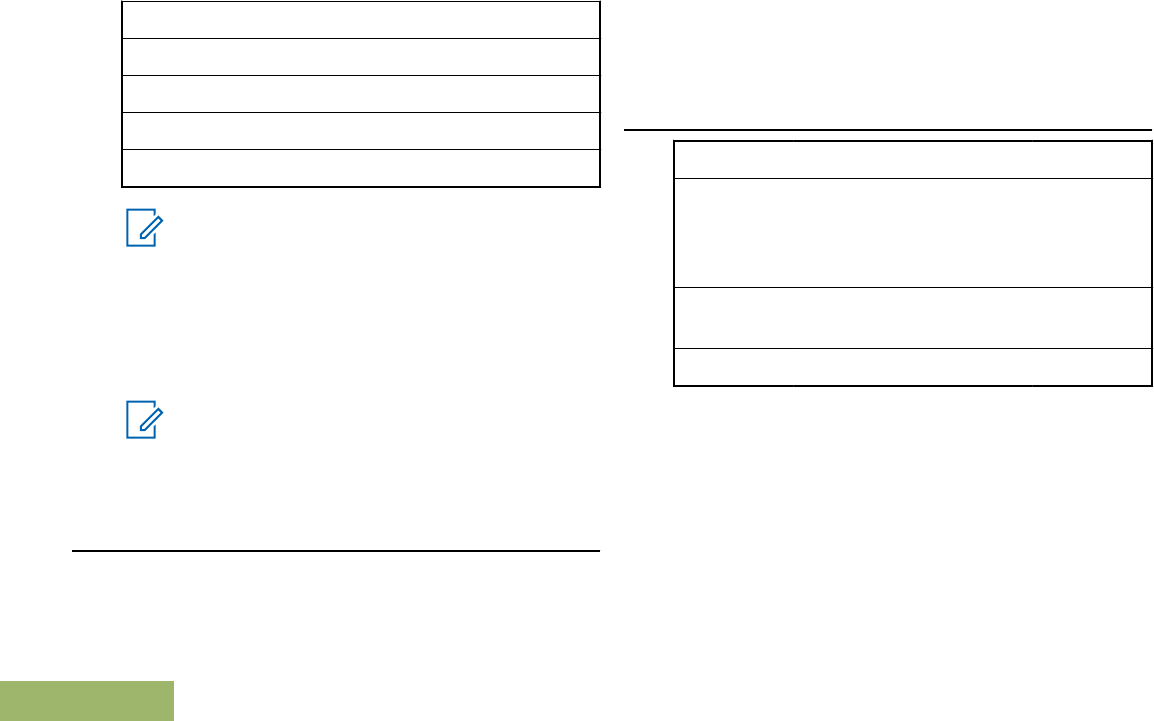
84 157.225 161.825
85 157.275 161.875
86 157.325 161.925
87 157.375 161.975
88 157.425 162.025
Note:
* Simplex channels 3, 21, 23, 61, 64, 81, 82,
and 83 cannot be lawfully used by the
general public in US waters.
** Low power (1 W) only.
*** Guard band.
Note:
A – in the Receive column indicates that the
channel is transmit only.
Declaration of Compliance for the Use of
Distress and Safety Frequencies
The radio equipment does not employ a modulation
other than the internationally adopted modulation for
maritime use when it operates on the distress and
safety frequencies specified in RSS-182 Section 7.3.
Technical Parameters for Interfacing External
Data Sources
RS232 USB SB9600
Input Volt-
age (Volts
Peak-to-
peak)
18V 3.6V 5V
Max Data
Rate
28 kb/s 12 Mb/s 9.6 kb/s
Impedance 5000 ohm 90 ohm 120 ohm
Maritime Radio Use in the VHF Frequency Range
192
English

Glossary
This glossary is a list of specialized terms used in this
manual.
ACK Acknowledgment of
communication.
Active Channel A channel that has traffic on it.
Analog Signal An RF signal that has a
continuous nature rather than a
pulsed or discrete nature.
ARS Automatic Registration Service
ASTRO 25 Motorola standard for wireless
digital trunked communications.
ASTRO
Conventional
Motorola standard for wireless
digital conventional
communications.
Autoscan A feature that allows the radio
to automatically scan the
members of a scan list.
Bluetooth Bluetooth is an open wireless
technology standard for
exchanging data over short
distances from fixed and mobile
devices with high levels of
security.
Bluetooth Pairing Bluetooth pairing occurs when
two bluetooth devices
exchanged a passkey to form a
paired Bluetooth wireless
connection.
Call Alert Privately page an individual by
sending an audible tone.
Carrier Squelch Feature that responds to the
presence of an RF carrier by
opening or unmuting (turning
on) a receiver’s audio circuit. A
squelch circuit silences the
radio when no signal is being
received so that the user does
not have to listen to “noise”.
Central Controller A software-controlled,
computer-driven device that
receives and generates data for
the trunked radios assigned to
it. It monitors and directs the
Glossary
193
English

operations of the trunked
repeaters.
Channel A group of characteristics such
as transmit/ receive frequency
pairs, radio parameters, and
encryption encoding.
Control Channel In a trunking system, one of the
channels that is used to provide
a continuous, two-way/ data
communications path between
the central controller and all
radios on the system.
Conventional Typically refers to radio-to-radio
communications, sometimes
through a repeater (see
Trunking).
Conventional
Scan List
A scan list that includes only
conventional channels.
COTS Commercial Off-The-Shelf
Cursor A visual tracking marker (a
blinking line) that indicates a
location on the display.
Deadlock Displayed by the radio after
three failed attempts to unlock
the radio. The radio must be
powered off and on prior to
another attempt.
Digital Private
Line (DPL)
A type of coded squelch using
data bursts. Similar to PL
except a digital code is used
instead of a tone.
Digital Signal An RF signal that has a pulsed,
or discrete, nature, rather than
a continuous nature.
Dispatcher An individual who has radio
system management duties.
DSP Digital Signal Processing
Dynamic
Regrouping
A feature that allows the
dispatcher to temporarily
reassign selected radios to a
single special channel so they
can communicate with each
other.
DSR Dynamic System Resilience
EID Encrypted Integrated Data
Glossary
194
English

ESN Electrical Serial Number
Failsoft A feature that allows
communications to take place
even though the central
controller has failed. Each
trunked repeater in the system
transmits a data word informing
every radio that the system has
gone into failsoft.
FCC Federal Communications
Commission.
FM Frequency Modulation
Hang Up Disconnect.
Home screen The first display information
after the radio completes its
self test.
IV&D Integrated Voice and Data
KVL Key-variable loader: A device
for loading encryption keys into
the radio.
LCD Liquid crystal display.
LED Light-emitting diode.
Li-Ion Lithium ion.
Man Down A life-saving feature that
senses the radio user may be
in trouble by monitoring the
whether the radio is in a vertical
or horizontal position or
whether the radio is motionless.
When this feature is triggered,
the radio alerts the user with
audio and visual alerts. It can
also trigger Emergency Alarm
the Post-Alert Timer is not
cancelled.
MCW Mission Critical Wireless
MDC Motorola Data Communication
Menu Entry A software-activated feature
shown at the bottom of the
display – selection of these
features is controlled by the
, , and buttons.
Monitor Check channel activity by
pressing the Monitor button. If
the channel is clear, you hear
Glossary
195
English

static. If the channel is in use,
you hear conversation. It also
serves as a way to check the
volume level of the radio, since
the radio “opens the squelch”
when the monitor button is
pressed.
Multi-System
Talkgroup Scan
List
A scan list that can include both
talkgroups (trunked) and
channels (conventional).
Network Access
Code
Network Access Code (NAC)
operates on digital channels to
reduce voice channel
interference between adjacent
systems and sites.
NiMH Nickel-metal-hydride.
Non-Tactical/
Revert
The user talks on a
preprogrammed emergency
channel. The emergency alarm
is sent out on this same
channel.
OCW Operation Critical Wireless
OTAR Over-the-air rekeying.
Page A one-way alert, with audio
and/or display messages.
Personality A set of unique features
specific to a radio.
PIN Personal Identification Number
PremierOne A software application which
streamlines critical real time
operations and simplifies
system administration to deliver
accurate, consistent and
integrated information remotely
to the requestors.
Preprogrammed Refers to a software feature
that has been activated by a
qualified radio technician.
Private
(Conversation)
Call
A feature that lets you have a
private conversation with
another radio user in the
talkgroup.
Private Line (PL) A sub-audible tone that is
transmitted such that only
receivers decoding the tone
receives it.
Glossary
196
English

Programmable Refers to a radio control that
can have a radio feature
assigned to it.
PTT Push-To-Talk. The PTT button
engages the transmitter and
puts the radio in transmit (send)
operation when pressed.
Radio Frequency
(RF)
The part of the general
frequency spectrum between
the audio and infrared light
regions (about 10 kHz to
10,000,000 MHz).
Repeater A conventional radio feature,
where you talk through a
receive/transmit facility that re-
transmits received signals, in
order to improve
communications range and
coverage.
Selective Call A feature that allows you to call
a selected individual, intended
to provide privacy and to
eliminate the annoyance of
having to listen to
conversations of no interest to
you.
Selective Switch Any digital P25 traffic having
the correct Network Access
Code and the correct talkgroup.
Squelch Special electronic circuitry,
added to the receiver of a
radio, that reduces, or cuts off,
unwanted signals before they
are heard in the speaker.
SSI Synchronous Serial Interface
Standby An operating condition whereby
the radio’s speaker is muted
but still continues to receive
data.
Status Calls Pre-defined text messages that
allow the user to send a
conditional message without
talking.
Tactical/ Non-
Revert
The user talks on the channel
that was selected before the
radio entered the emergency
state.
Glossary
197
English

Talkaround Bypass a repeater and talk
directly to another unit for easy
local unit-to-unit
communications.
Talkgroup An organization or group of
radio users who communicate
with each other using the same
communication path.
TMS Text Messaging Service
Trunking The automatic sharing of
communications paths between
a large number of users (see
Conventional).
Trunking Priority
Monitor Scan List
A scan list that includes
talkgroups that are all from the
same trunking system.
USK Unique Shadow Key.
UTC Coordinated Universal Time.
The international time standard
(formerly Greenwich Mean
Time, or GMT). Zero hours
UTC is midnight in Greenwich,
England, which is located at 0
degrees longitude. Everything
east of Greenwich (up to 180
degrees) is later in time;
everything west is earlier.
There are 42 time authorities
around the world that are
constantly synchronizing with
each other. Abbreviated as
UTC (English backronym =
Universal Time, Coordinated), it
is also known as Zulu (Z) Time.
Zone A grouping of channels.
Glossary
198
English
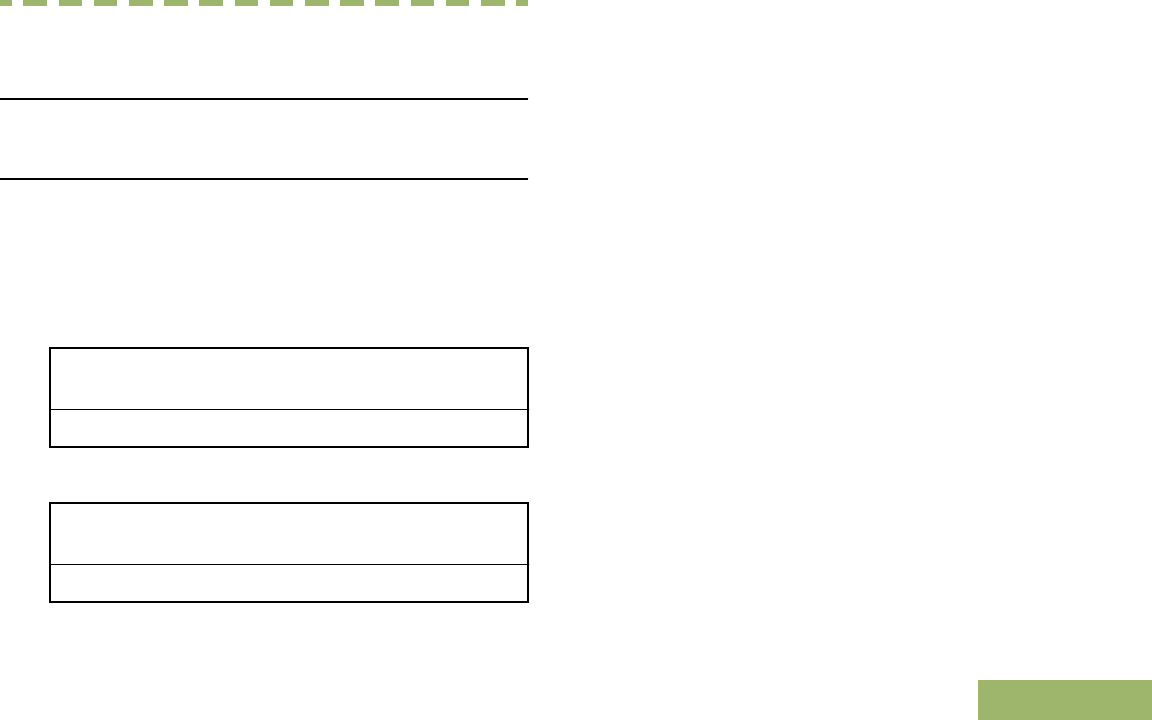
Limited Warranty
MOTOROLA COMMUNICATION PRODUCTS
I. WHAT THIS WARRANTY COVERS AND FOR
HOW LONG:
MOTOROLA SOLUTIONS, INC. (“MOTOROLA”)
warrants the MOTOROLA manufactured
Communication Products listed below (“Product”)
against defects in material and workmanship under
normal use and service for a period of time from the
date of purchase as scheduled below:
ASTRO SRX 2200 Porta-
ble Units
One (1) Year
Product Accessories One (1) Year
For LACR region:
ASTRO SRX 2200 Porta-
ble Units
Three (3) Years
Product Accessories One (1) Year
MOTOROLA, at its option, will at no charge either
repair the Product (with new or reconditioned parts),
replace it (with a new or reconditioned Product), or
refund the purchase price of the Product during the
warranty period provided it is returned in accordance
with the terms of this warranty. Replaced parts or
boards are warranted for the balance of the original
applicable warranty period. All replaced parts of
Product shall become the property of MOTOROLA.
This express limited warranty is extended by
MOTOROLA to the original end user purchaser only
and is not assignable or transferable to any other
party. This is the complete warranty for the Product
manufactured by MOTOROLA. MOTOROLA
assumes no obligations or liability for additions or
modifications to this warranty unless made in writing
and signed by an officer of MOTOROLA.
Unless made in a separate agreement between
MOTOROLA and the original end user purchaser,
MOTOROLA does not warrant the installation,
maintenance or service of the Product.
MOTOROLA cannot be responsible in any way for
any ancillary equipment not furnished by MOTOROLA
which is attached to or used in connection with the
Product, or for operation of the Product with any
Limited Warranty
199
English

ancillary equipment, and all such equipment is
expressly excluded from this warranty. Because each
system which may use the Product is unique,
MOTOROLA disclaims liability for range, coverage, or
operation of the system as a whole under this
warranty.
MOTOROLA offers the following optional extended
service contracts.
SERVICE FROM THE START (SfS)
COMPREHENSIVE
Provides for extended hardware repair coverage
INCLUDING CHEMICAL, LIQUID, FIRE, AND
OTHER PHYSICAL DAMAGE. Comprehensive
coverage is available in conjunction with
MOTOROLA’S standard Commercial Warranty and
starts from the FIRST DAY the radio is put into use.
Service performed under this plan consists of repair
or replacement of the covered equipment as set forth
in the terms and conditions. Repairs will be made
only at the designated MOTOROLA repair depot.
Local services are not included. MOTOROLA will pay
the inbound shipping charges only with use of the
MOTOROLA designated delivery service.
MOTOROLA will pay for outbound shipping via
MOTOROLA'S normal shipping methods.
SERVICE FROM THE START (SfS) LITE
Provides extended hardware normal wear and tear
repair coverage beginning AFTER MOTOROLA’S
standard Commercial Warranty period expires.
Service performed under this plan consists of repair
of the covered equipment as set forth in the terms
and conditions. Repairs will be made only at the
designated MOTOROLA repair depot. Local services
are not included. MOTOROLA will pay for outbound
shipping via MOTOROLA'S normal shipping methods.
II. GENERAL PROVISIONS:
This warranty sets forth the full extent of
MOTOROLA'S responsibilities regarding the Product.
Repair, replacement or refund of the purchase price,
at MOTOROLA’s option, is the exclusive remedy.
THIS WARRANTY IS GIVEN IN LIEU OF ALL
OTHER EXPRESS WARRANTIES. IMPLIED
WARRANTIES, INCLUDING WITHOUT LIMITATION,
IMPLIED WARRANTIES OF MERCHANTABILITY
AND FITNESS FOR A PARTICULAR PURPOSE,
ARE LIMITED TO THE DURATION OF THIS
LIMITED WARRANTY. IN NO EVENT SHALL
MOTOROLA BE LIABLE FOR DAMAGES IN
EXCESS OF THE PURCHASE PRICE OF THE
Limited Warranty
200
English

PRODUCT, FOR ANY LOSS OF USE, LOSS OF
TIME, INCONVENIENCE, COMMERCIAL LOSS,
LOST PROFITS OR SAVINGS OR OTHER
INCIDENTAL, SPECIAL OR CONSEQUENTIAL
DAMAGES ARISING OUT OF THE USE OR
INABILITY TO USE SUCH PRODUCT, TO THE
FULL EXTENT SUCH MAY BE DISCLAIMED BY
LAW.
III. STATE LAW RIGHTS:
SOME STATES DO NOT ALLOW THE EXCLUSION
OR LIMITATION OF INCIDENTAL OR
CONSEQUENTIAL DAMAGES OR LIMITATION ON
HOW LONG AN IMPLIED WARRANTY LASTS, SO
THE ABOVE LIMITATION OR EXCLUSIONS MAY
NOT APPLY.
This warranty gives specific legal rights, and there
may be other rights which may vary from state to
state.
IV. HOW TO GET WARRANTY SERVICE:
You must provide proof of purchase (bearing the date
of purchase and Product item serial number) in order
to receive warranty service and, also, deliver or send
the Product item, transportation and insurance
prepaid, to an authorized warranty service location.
Warranty service will be provided by MOTOROLA
through one of its authorized warranty service
locations. If you first contact the company which sold
you the Product (e.g., dealer or communication
service provider), it can facilitate your obtaining
warranty service. You can also call MOTOROLA at
1-800-927-2744 US/Canada.
V. WHAT THIS WARRANTY DOES NOT
COVER:
1Defects or damage resulting from use of the
Product in other than its normal and customary
manner.
2Defects or damage from misuse, accident, water,
or neglect.
3Defects or damage from improper testing,
operation, maintenance, installation, alteration,
modification, or adjustment.
4Breakage or damage to antennas unless caused
directly by defects in material workmanship.
5A Product subjected to unauthorized Product
modifications, disassembles or repairs (including,
without limitation, the addition to the Product of
non-MOTOROLA supplied equipment) which
Limited Warranty
201
English

adversely affect performance of the Product or
interfere with MOTOROLA's normal warranty
inspection and testing of the Product to verify any
warranty claim.
6Product which has had the serial number removed
or made illegible.
7Rechargeable batteries if:
• any of the seals on the battery enclosure of
cells are broken or show evidence of
tampering.
• the damage or defect is caused by charging or
using the battery in equipment or service other
than the Product for which it is specified.
8Freight costs to the repair depot.
9A Product which, due to illegal or unauthorized
alteration of the software/firmware in the Product,
does not function in accordance with
MOTOROLA’s published specifications or the FCC
certification labeling in effect for the Product at the
time the Product was initially distributed from
MOTOROLA.
10 Scratches or other cosmetic damage to Product
surfaces that does not affect the operation of the
Product.
11 Normal and customary wear and tear.
VI. PATENT AND SOFTWARE PROVISIONS:
MOTOROLA will defend, at its own expense, any suit
brought against the end user purchaser to the extent
that it is based on a claim that the Product or parts
infringe a United States patent, and MOTOROLA will
pay those costs and damages finally awarded against
the end user purchaser in any such suit which are
attributable to any such claim, but such defense and
payments are conditioned on the following:
1that MOTOROLA will be notified promptly in
writing by such purchaser of any notice of such
claim,
2that MOTOROLA will have sole control of the
defense of such suit and all negotiations for its
settlement or compromise, and
3should the Product or parts become, or in
MOTOROLA’s opinion be likely to become, the
subject of a claim of infringement of a United
States patent, that such purchaser will permit
MOTOROLA, at its option and expense, either to
procure for such purchaser the right to continue
using the Product or parts or to replace or modify
the same so that it becomes non-infringing or to
grant such purchaser a credit for the Product or
parts as depreciated and accept its return. The
Limited Warranty
202
English

depreciation will be an equal amount per year over
the lifetime of the Product or parts as established
by MOTOROLA.
MOTOROLA will have no liability with respect to any
claim of patent infringement which is based upon the
combination of the Product or parts furnished
hereunder with software, apparatus or devices not
furnished by MOTOROLA, nor will MOTOROLA have
any liability for the use of ancillary equipment or
software not furnished by MOTOROLA which is
attached to or used in connection with the Product.
The foregoing states the entire liability of
MOTOROLA with respect to infringement of patents
by the Product or any parts thereof.
Laws in the United States and other countries
preserve for MOTOROLA certain exclusive rights for
copyrighted MOTOROLA software such as the
exclusive rights to reproduce in copies and distribute
copies of such MOTOROLA software. MOTOROLA
software may be used in only the Product in which
the software was originally embodied and such
software in such Product may not be replaced,
copied, distributed, modified in any way, or used to
produce any derivative thereof. No other use
including, without limitation, alteration, modification,
reproduction, distribution, or reverse engineering of
such MOTOROLA software or exercise of rights in
such MOTOROLA software is permitted. No license is
granted by implication, estoppel or otherwise under
MOTOROLA patent rights or copyrights.
VII. GOVERNING LAW:
This Warranty is governed by the laws of the State of
Illinois, U.S.A.
VIII. For Australia Only
This warranty is given by Motorola Solutions Australia
Pty Limited (ABN 16 004 742 312) of Tally Ho
Business Park, 10 Wesley Court. Burwood East,
Victoria.
Our goods come with guarantees that cannot be
excluded under the Australia Consumer Law. You are
entitled to a replacement or refund for a major failure
and compensation for any other reasonably
foreseeable loss or damage. You are also entitled to
have the goods repaired or replaced if the goods fail
to be of acceptable quality and the failure does not
amount to a major failure.
Motorola Solutions Australia’s limited warranty above
is in addition to any rights and remedies you may
Limited Warranty
203
English
SRX2200_M3.5_BackCover_HalfLetter_P299C.fm Page 1 Monday, November 3, 2014 5:36 PM

Motorola Solutions, Inc.
1303 East Algonquin Road
Schaumburg, Illinois 60196 U.S.A.
MOTOROLA, MOTO, MOTOROLA SOLUTIONS and
the Stylized M logo are trademarks or registered trademarks
of Motorola Trademark Holdings, LLC and are used under
license.
All other trademarks are the property of their respective owners.
© 2011 and 2015 Motorola Solutions, Inc. All rights reserved.
June 2015
*68012005051*
68012005051-FB
SRX2200_M3.5_BackCover_HalfLetter_P299C.fm Page 2 Monday, November 3, 2014 5:36 PM

